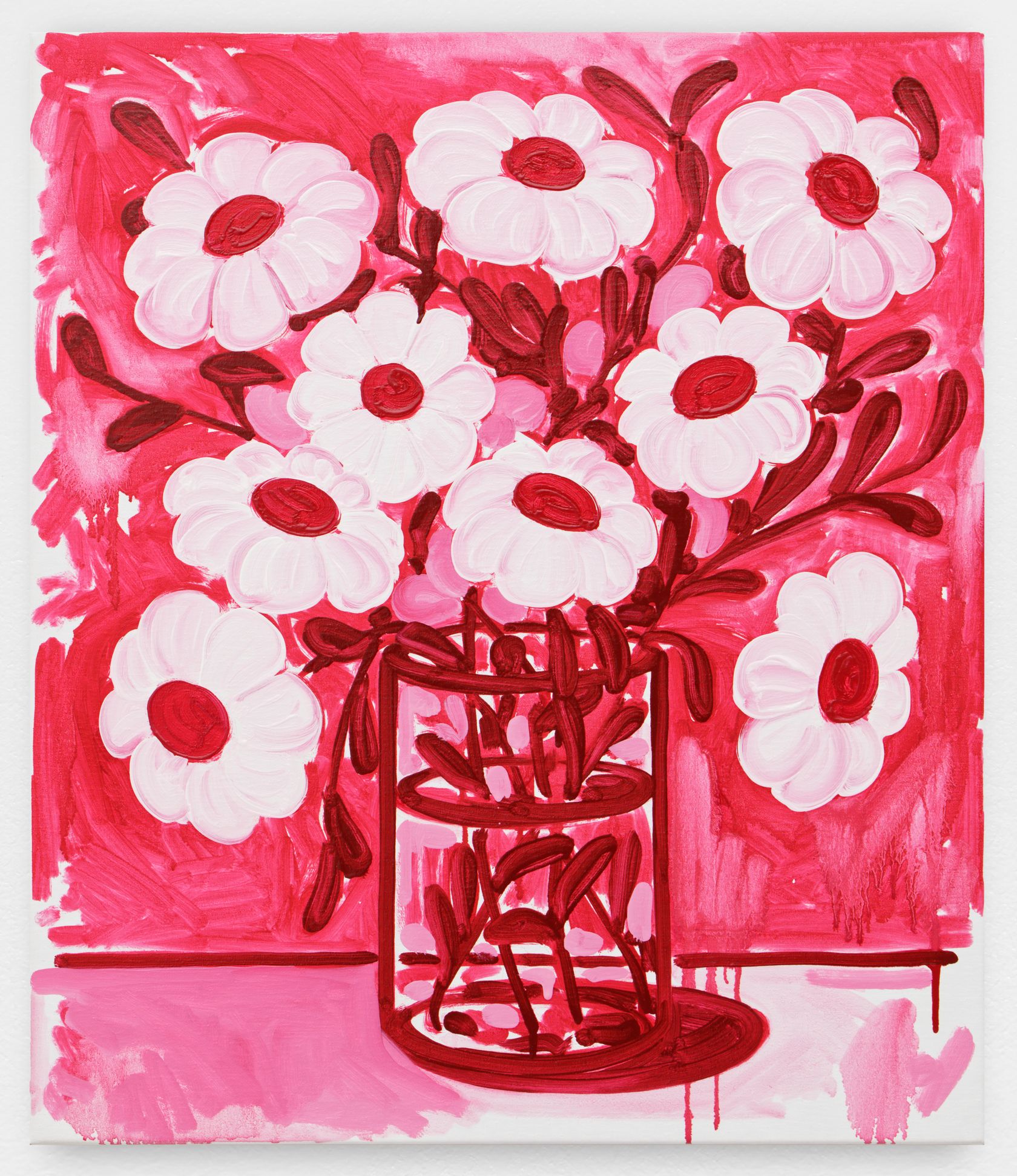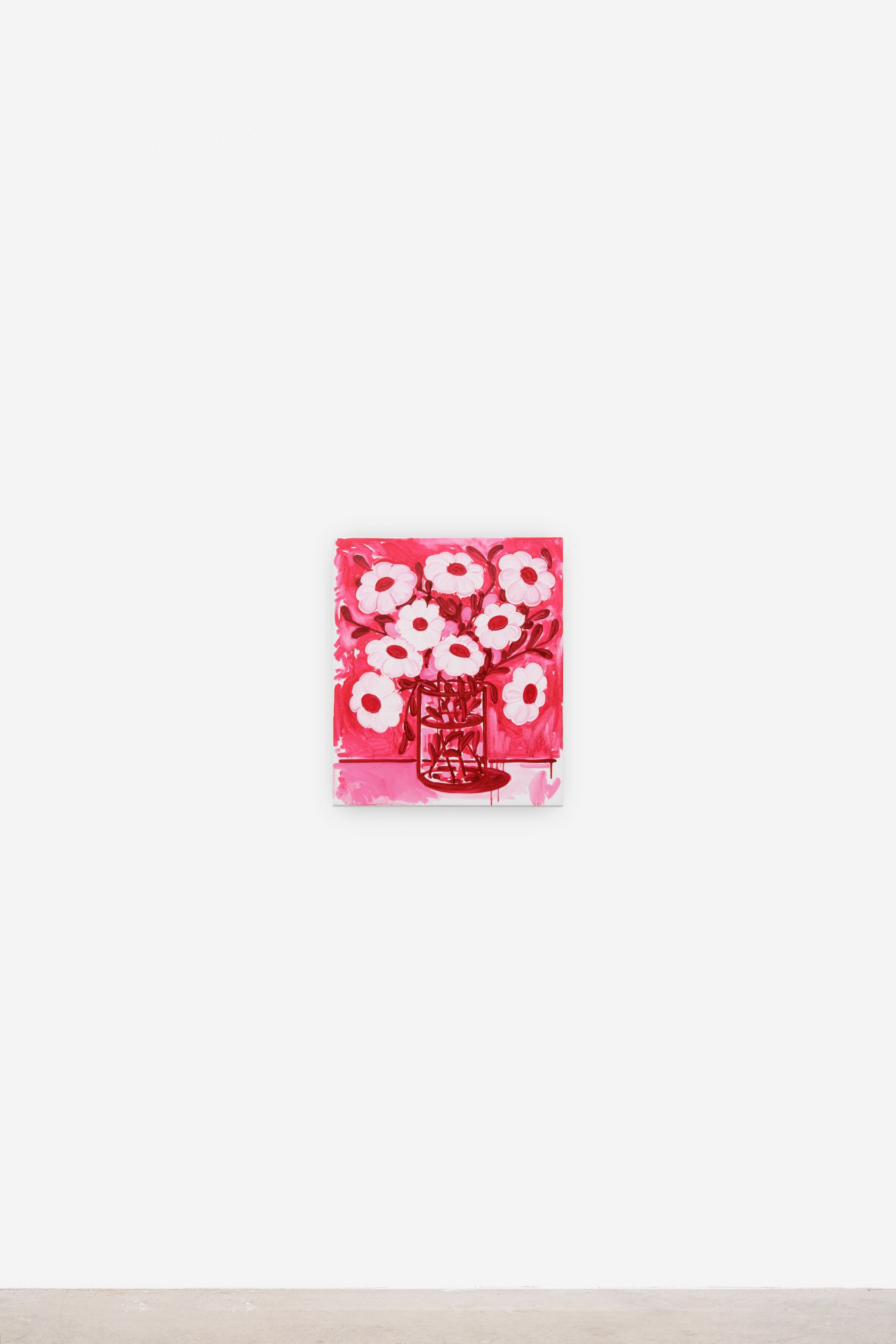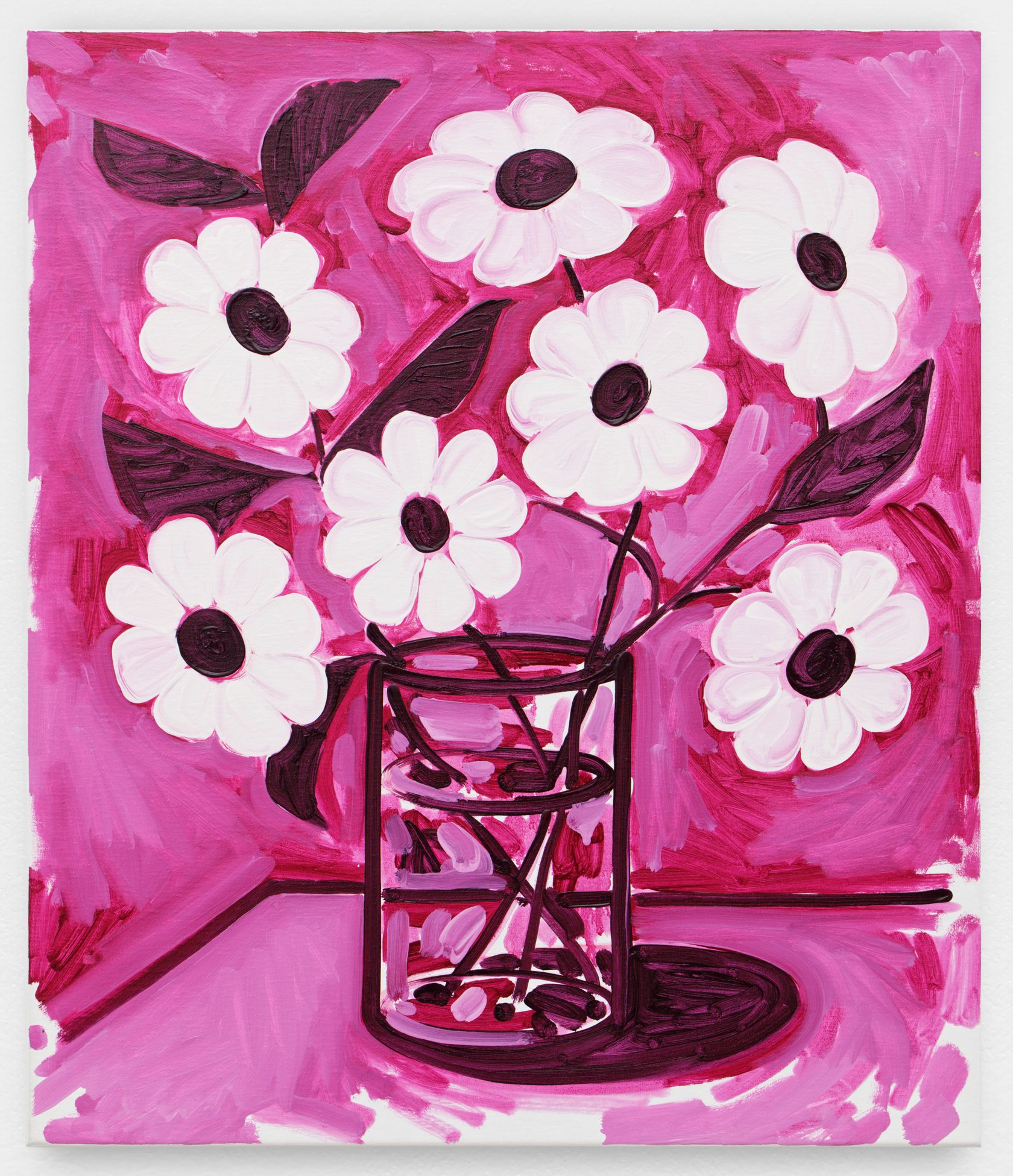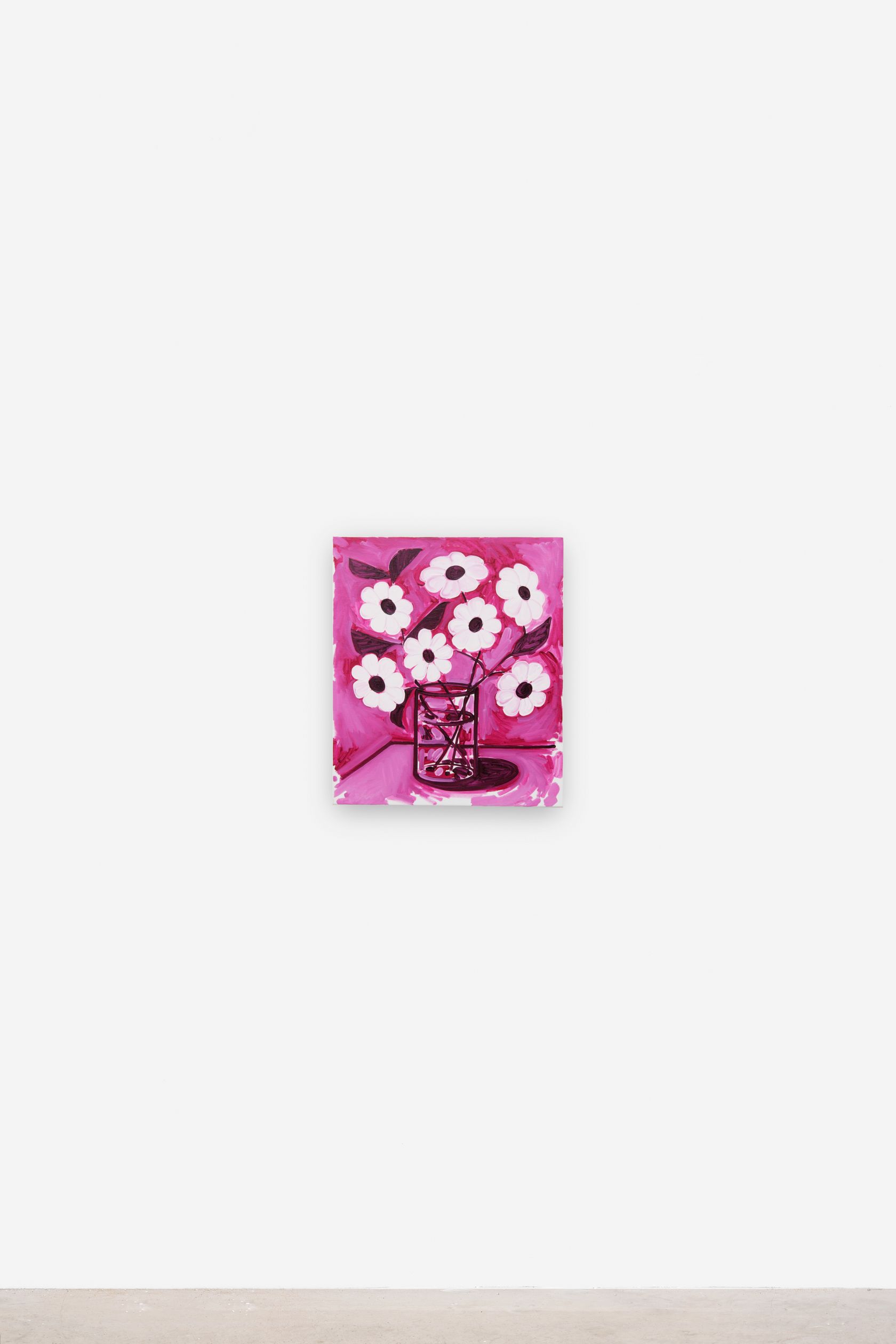To learn more about available works, please provide your contact information
Art Brussels
April 25th - 28th, 2024
Booth 5E-39
Solo: Moffat Takadiwa
Moffat Takadiwa creates large format sculptures from materials found on garbage dumps, notably computer parts, plastic bottle-caps, toothbrushes and toothpaste tubes. After gathering great quantities of these objects and sorting them by color and shape, the artist weaves these discarded scraps into rich wall hangings. Once suspended, these post-industrial fabrics, through their intricate beauty, acquire an aura of ritual or totemic artifacts.
Born in 1983, Moffat Takadiwa lives and works on the outskirts of Harare in Mbare, one of the largest recycling centers in the country and an important hub for the informal economy. Belonging to the post-independence generation, his work reflects his preoccupation with issues such as consumerism, inequality, post-colonialism and the environment. Since the earliest days of his artistic career, he has used his practice as a platform for the rehabilitation of his community, working with young local artists and designers, with a view to founding the world first artistic center based on the use of reclaimed materials.
The National Gallery of Zimbabwe, Harare, staged a major solo exhibition of Moffat Takadiwa in 2023. In 2024, he will have his first solo exhibition in a French institution at the Galerie Édouard Manet, Gennevilliers, and will represent Zimbabwe at the 60th Biennale di Venezia alongside five other artists. He exhibited his works in major institutions abroad as well, most notably at the Craft Contemporary (US), during the exhibition organized by Jeffrey Deitch and Gagosian at the Moore Building in Miami (US), at the ARoS Kunstmuseumat, Aarhus (DK), the MACAAL, Marrakesh (MA) and the Arnhem Museum (NL).
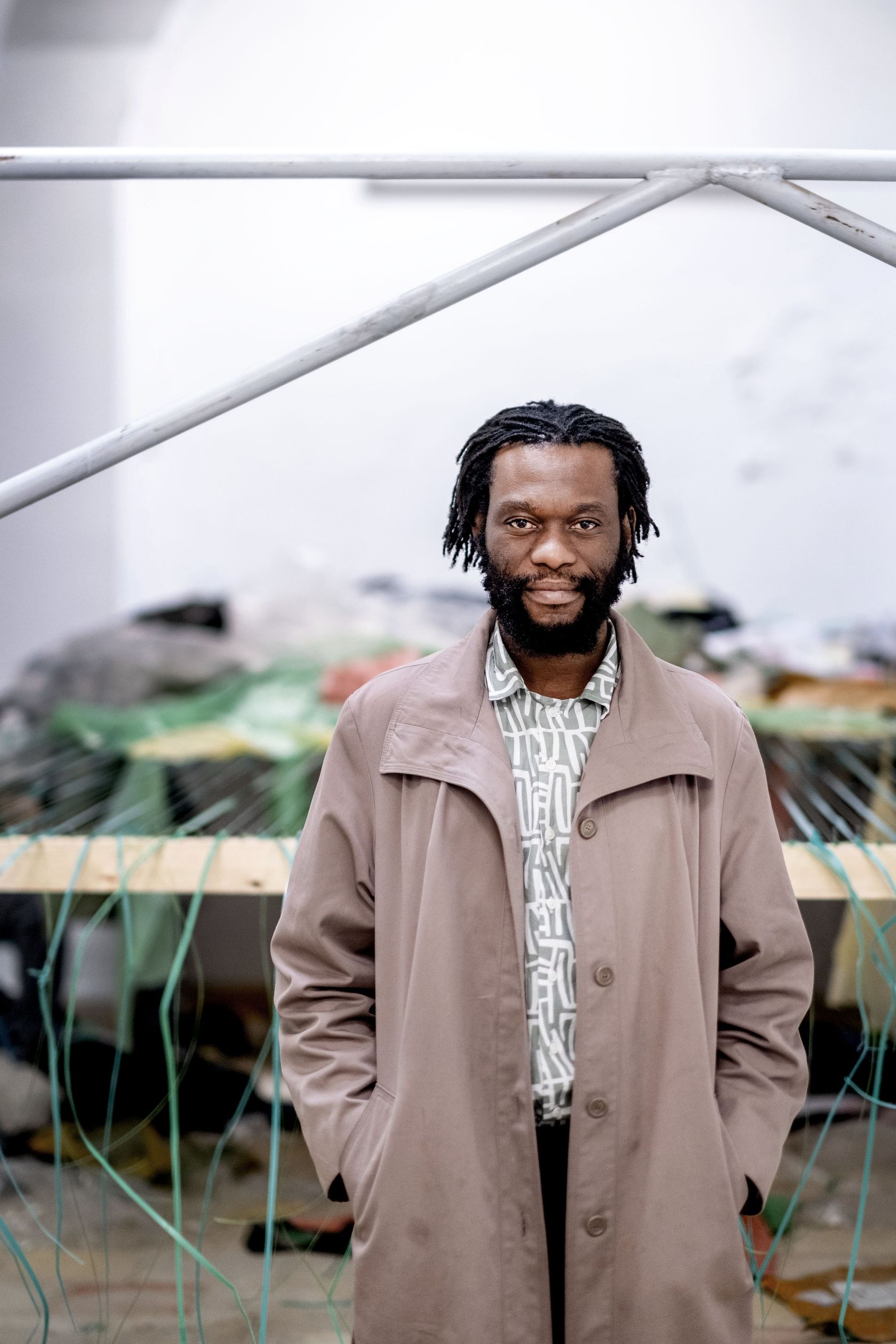
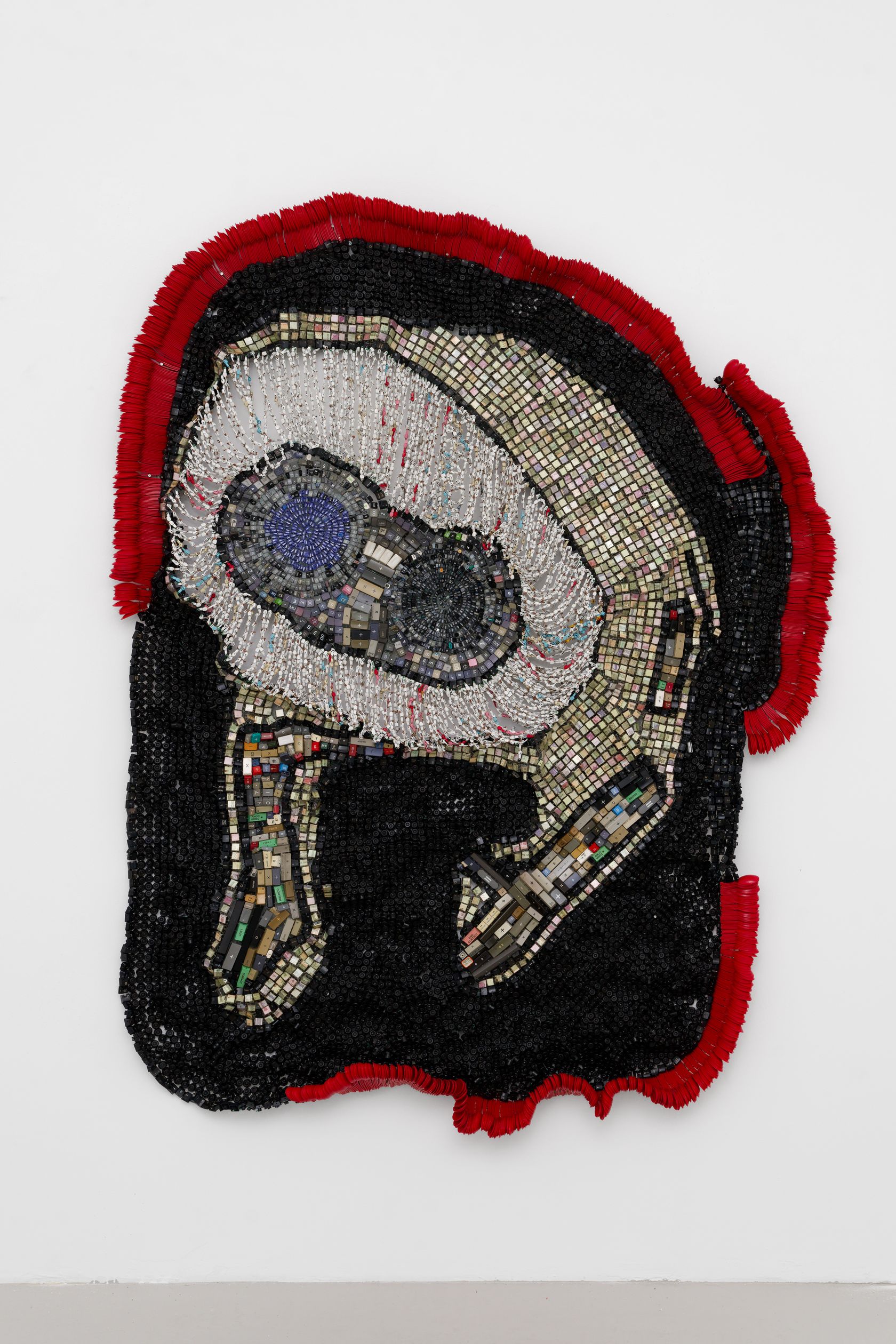
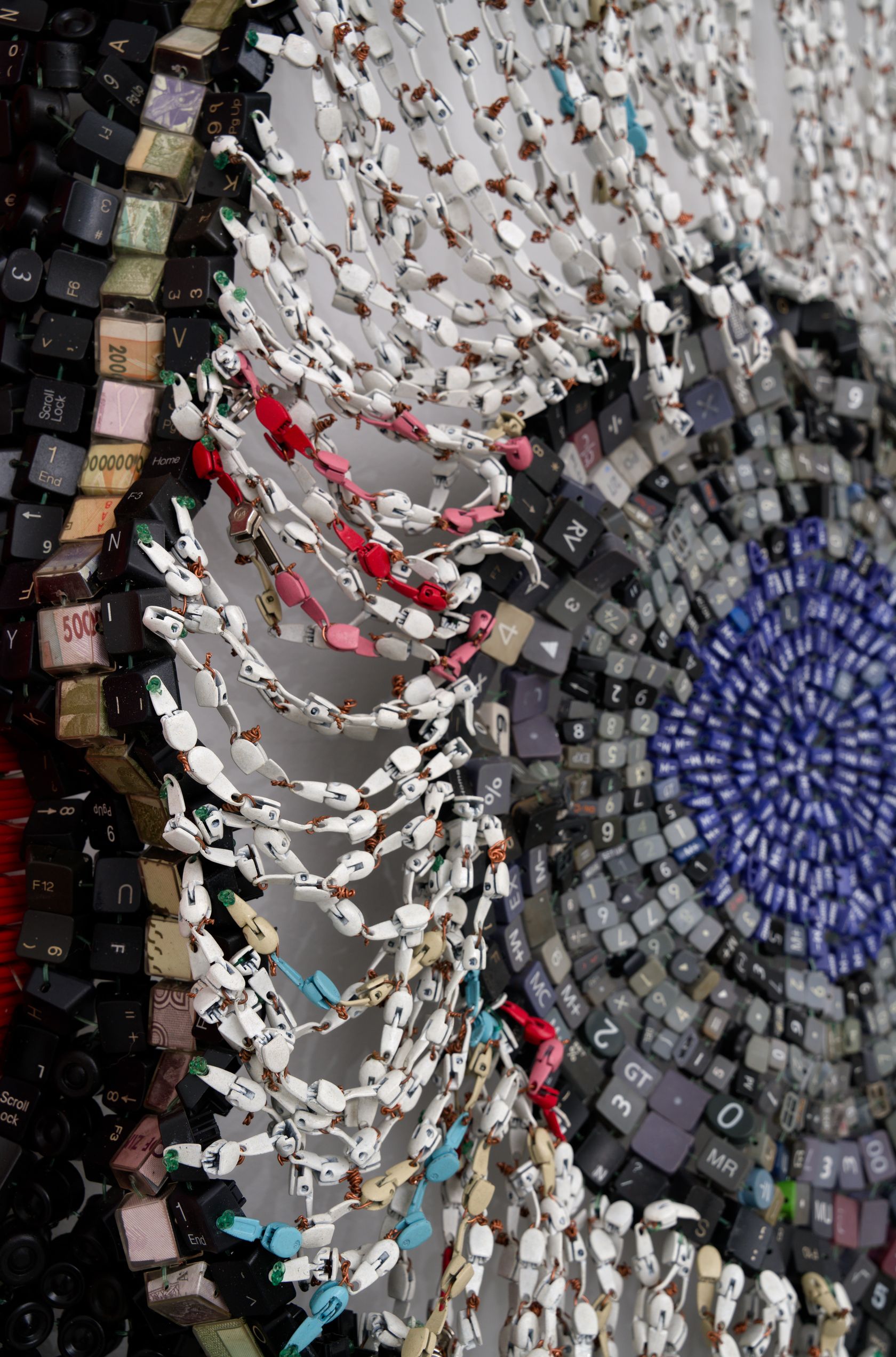
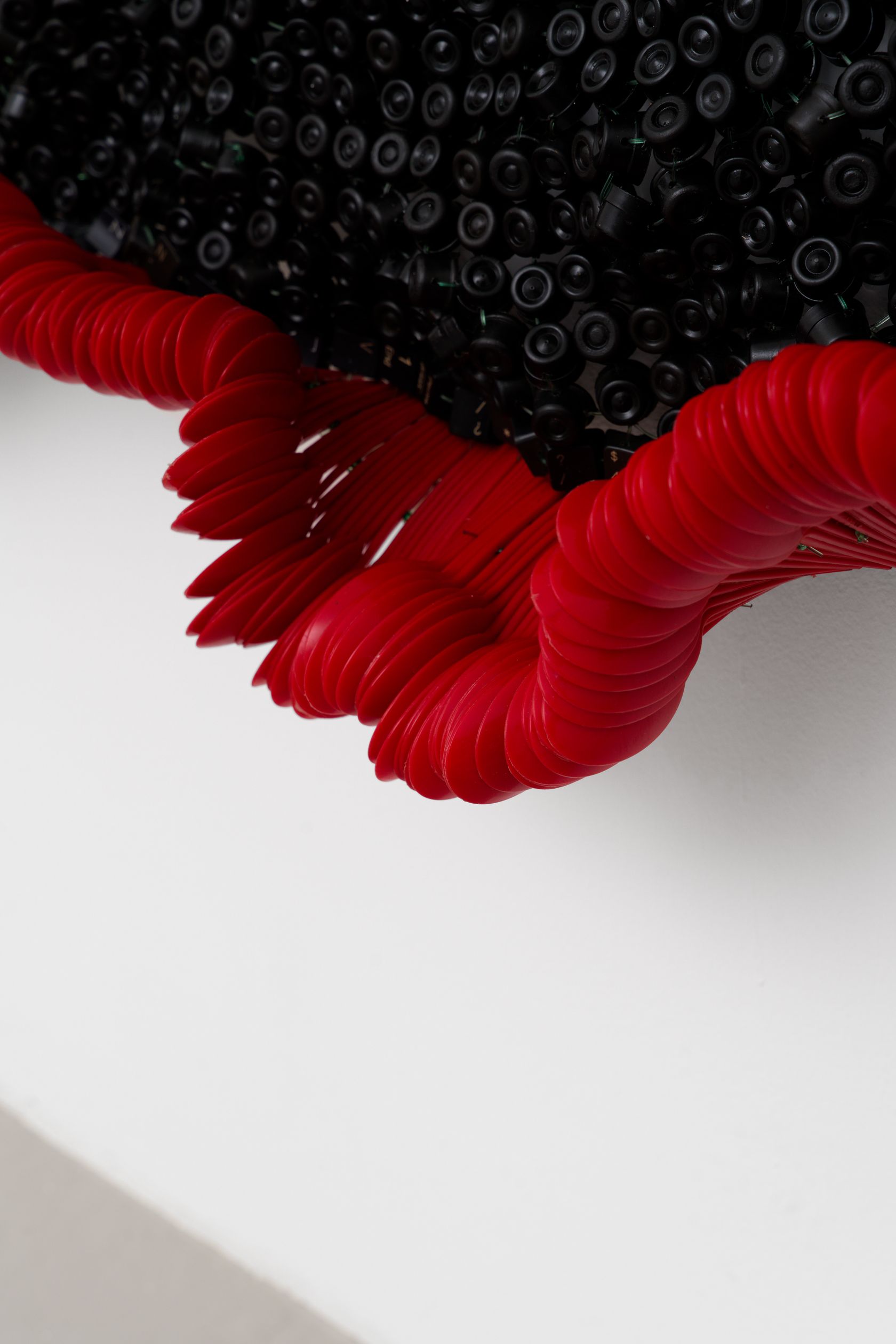
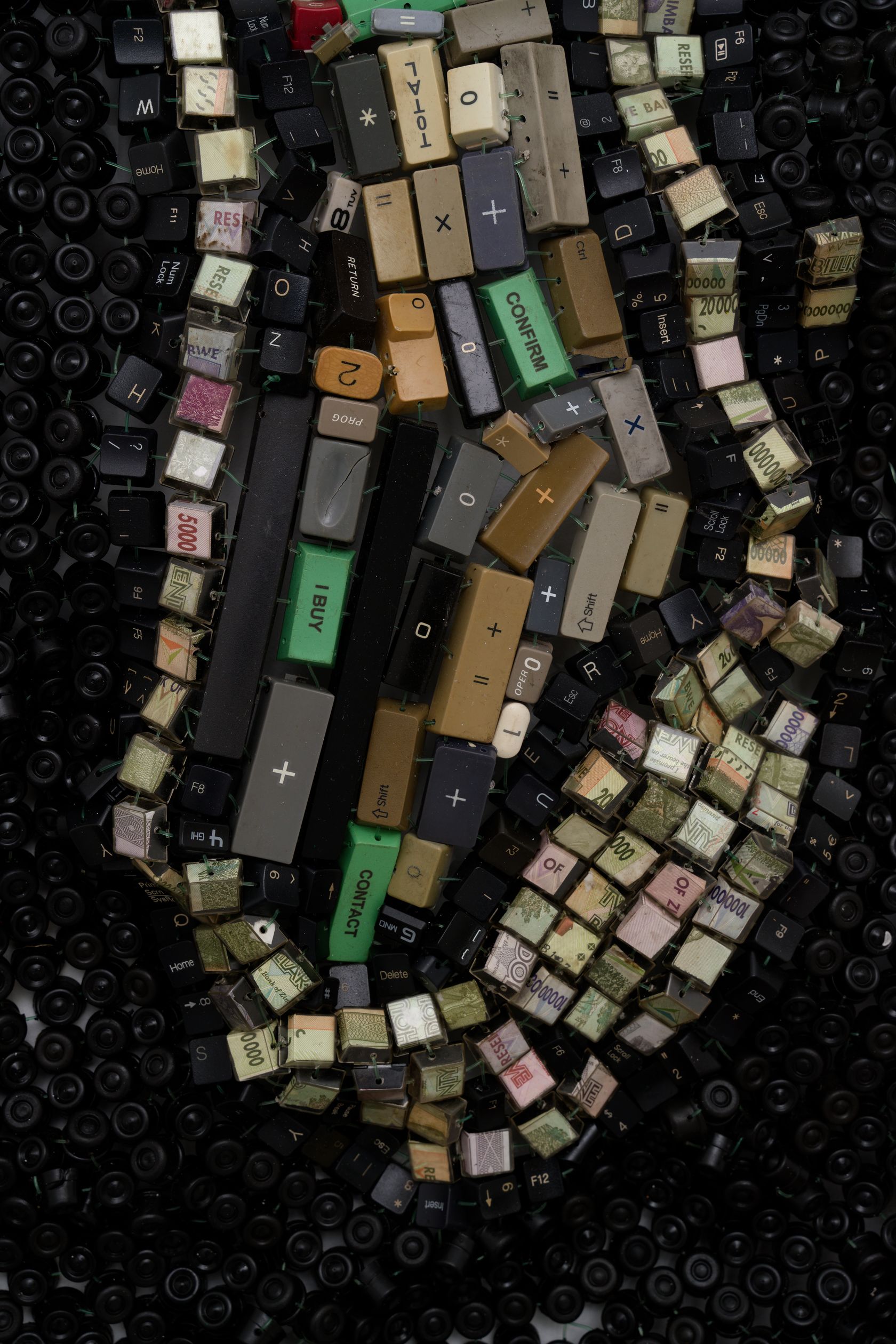
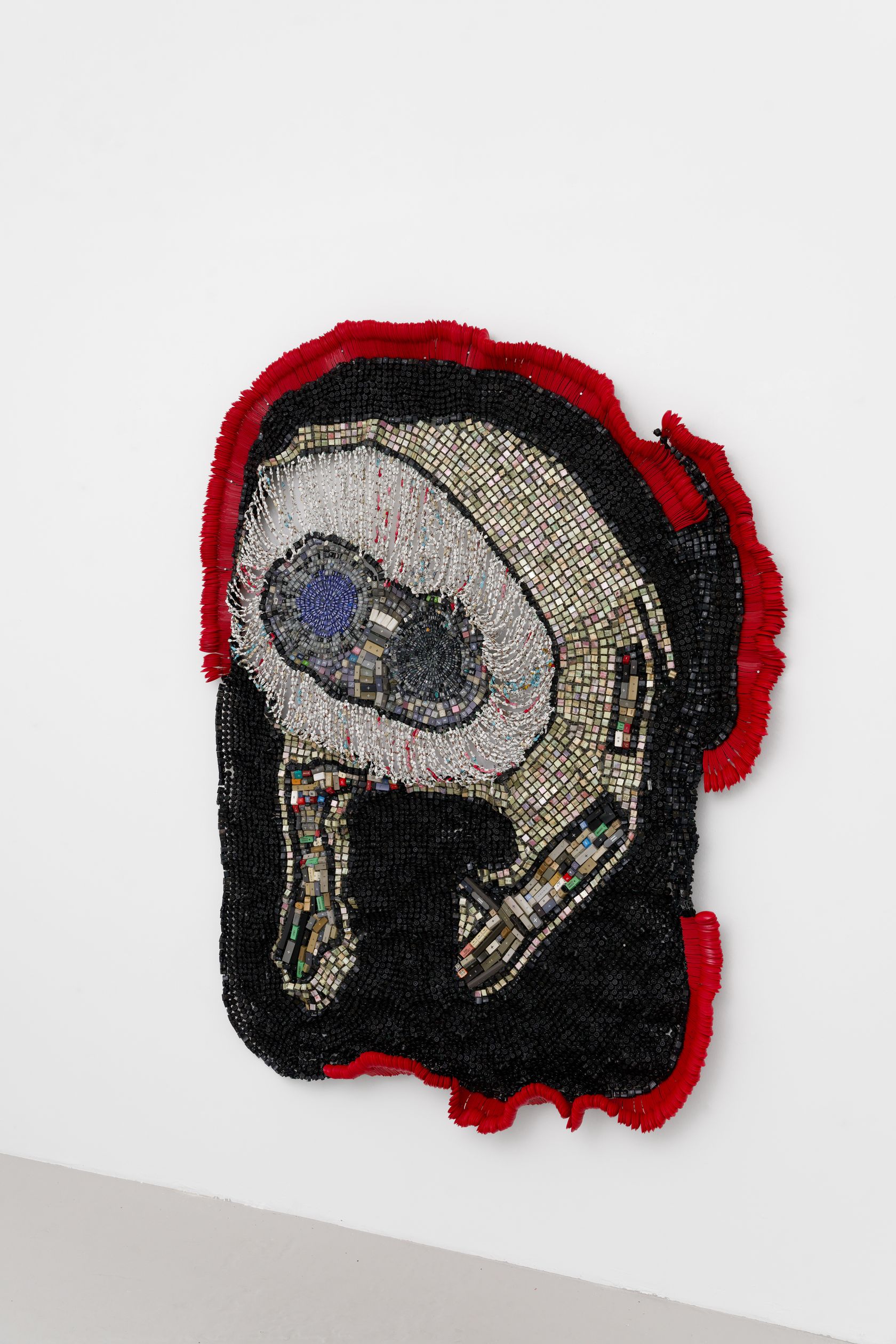
- Moffat Takadiwa
- Fast Food (b) , 2024
- Plastic keyboard and spoon, metal zipper and decommissioned bank notes
-
- 195 ×
- 150 × cm
- 76 3/4 ×
- 59 1/16 × inches
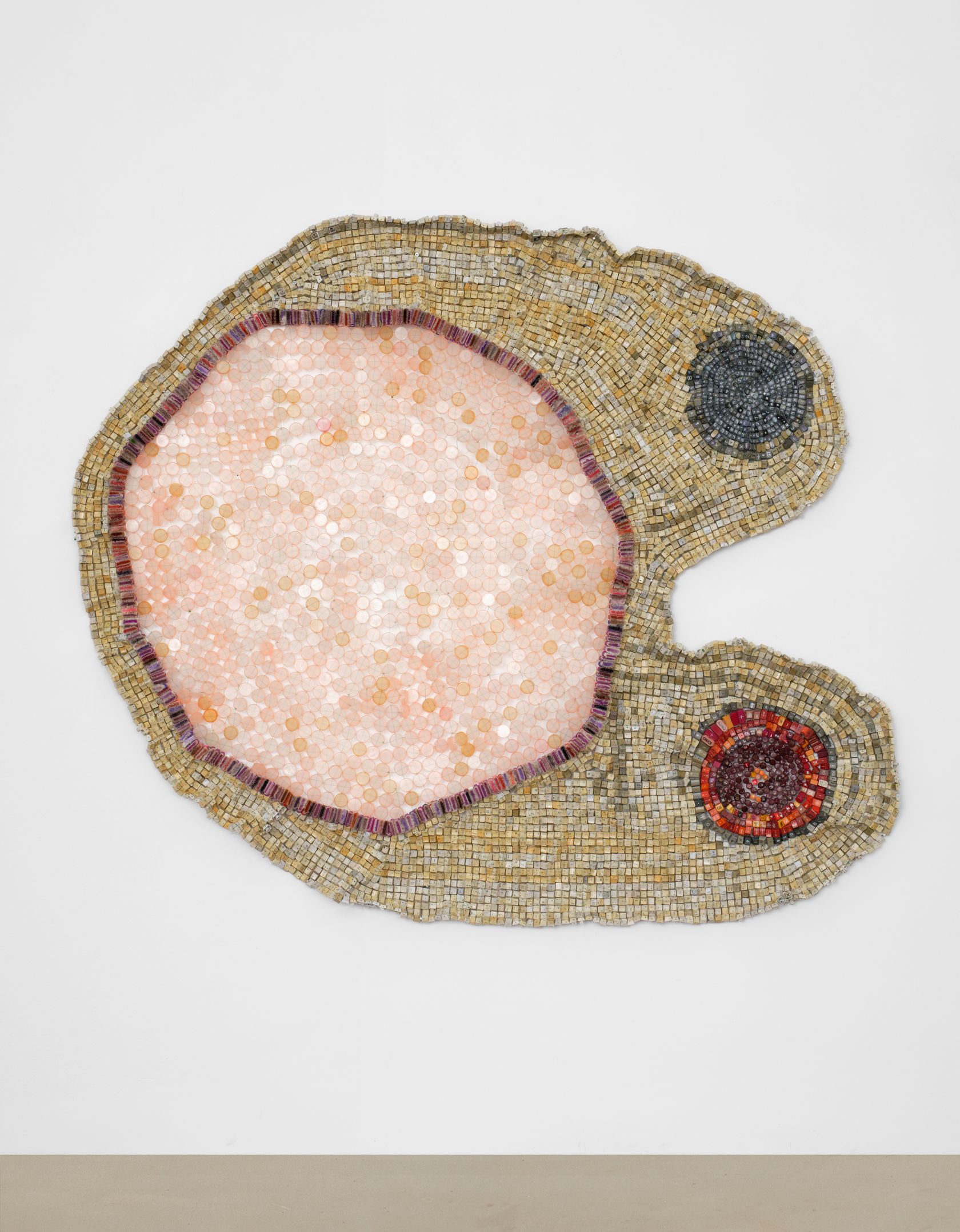
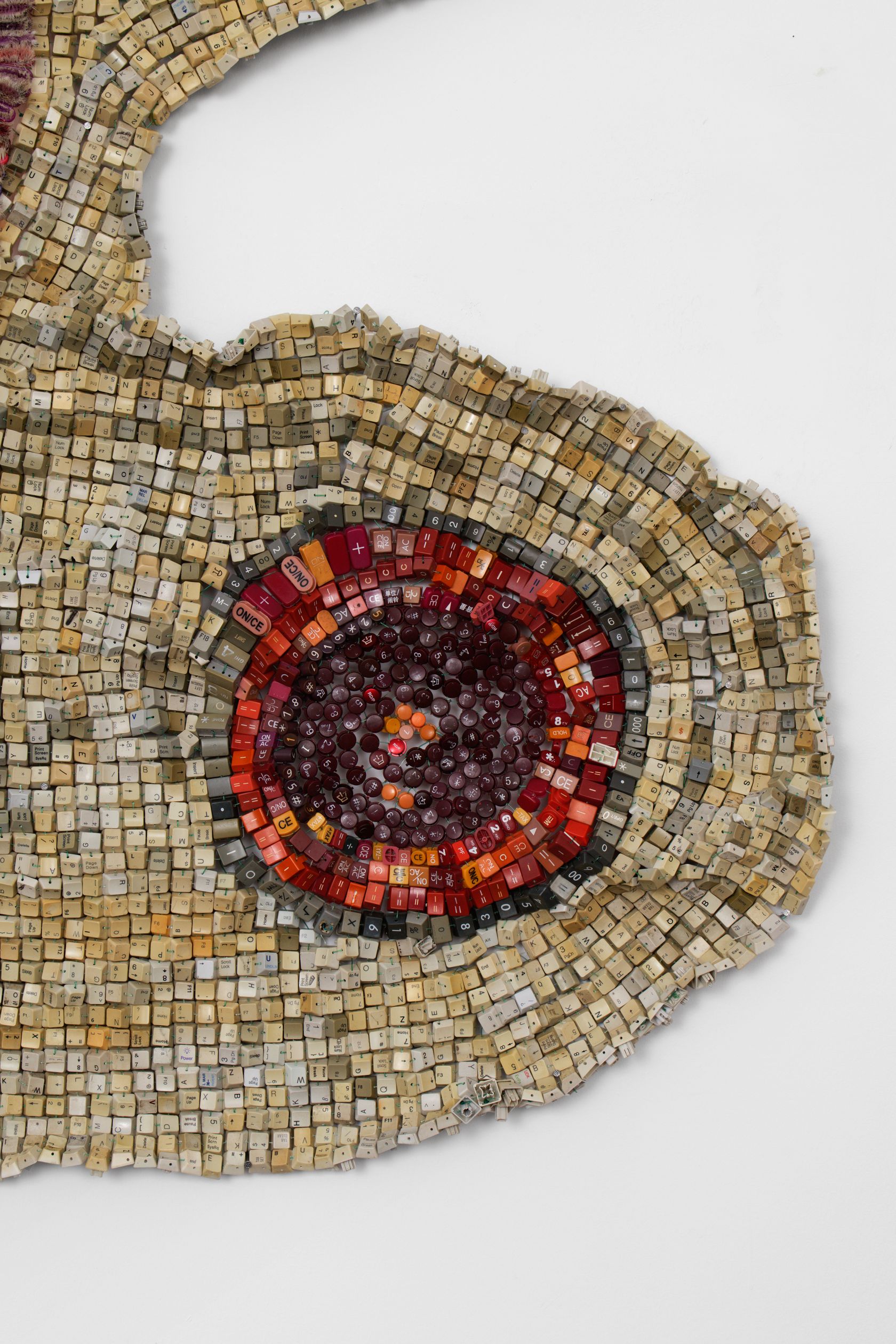
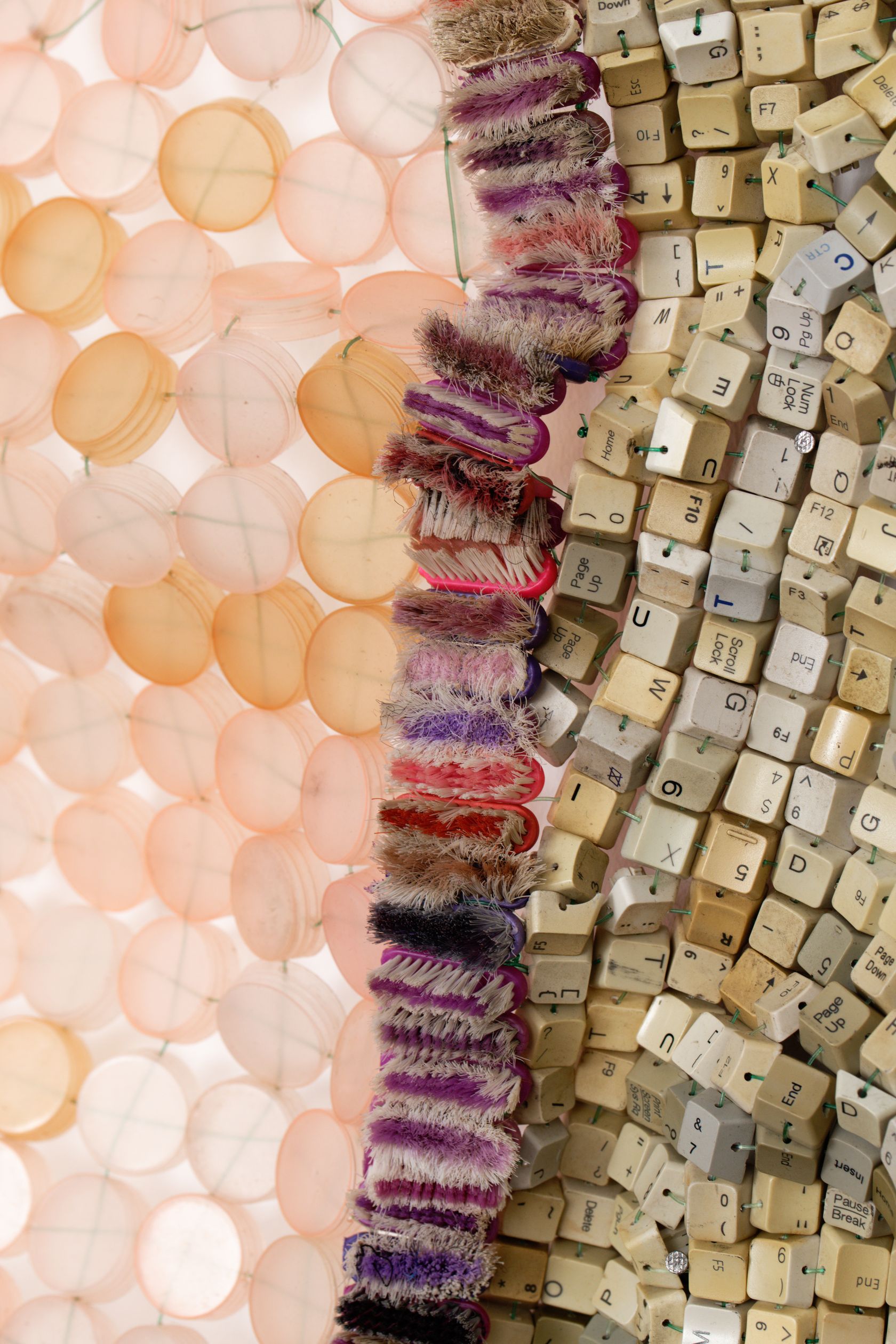
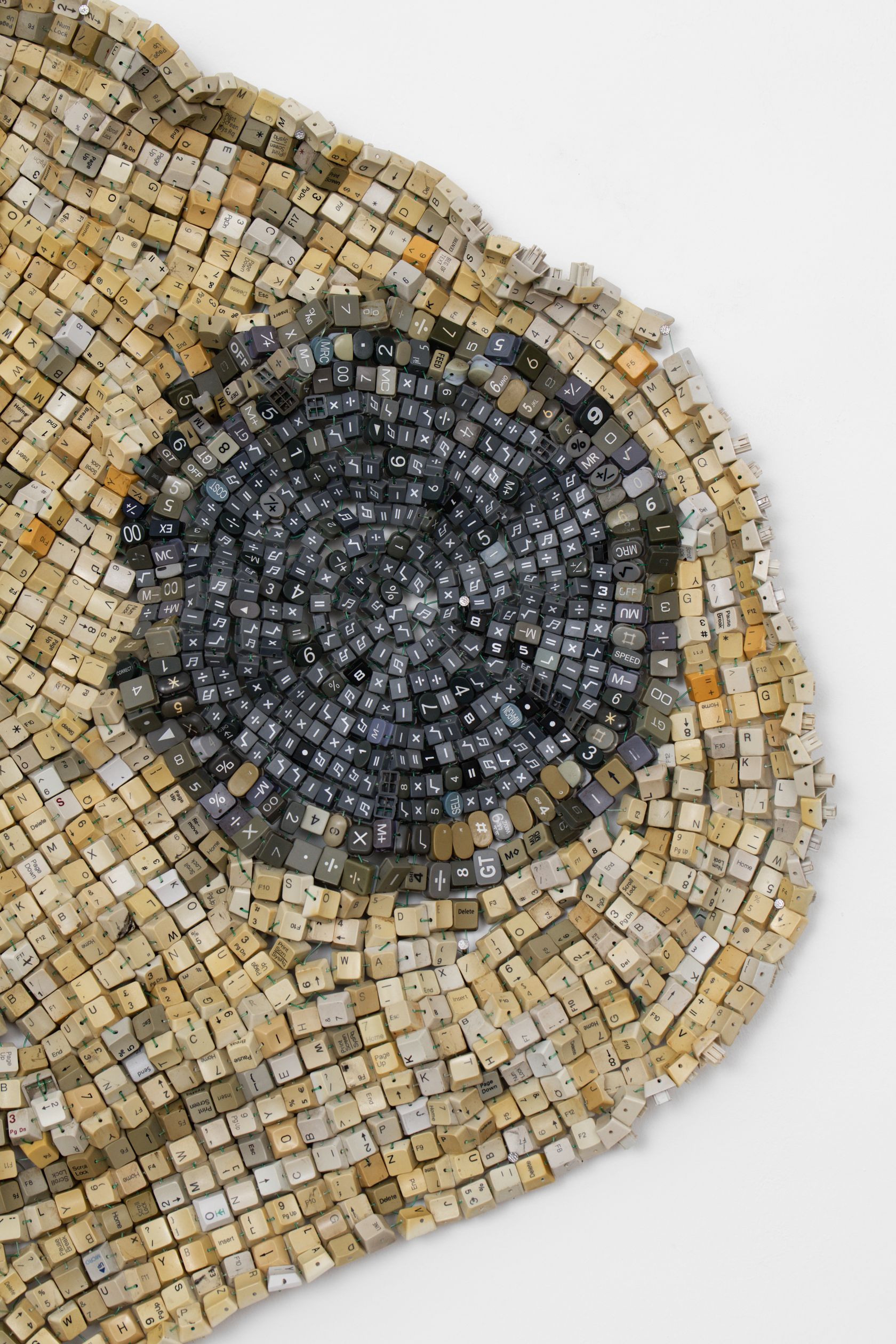
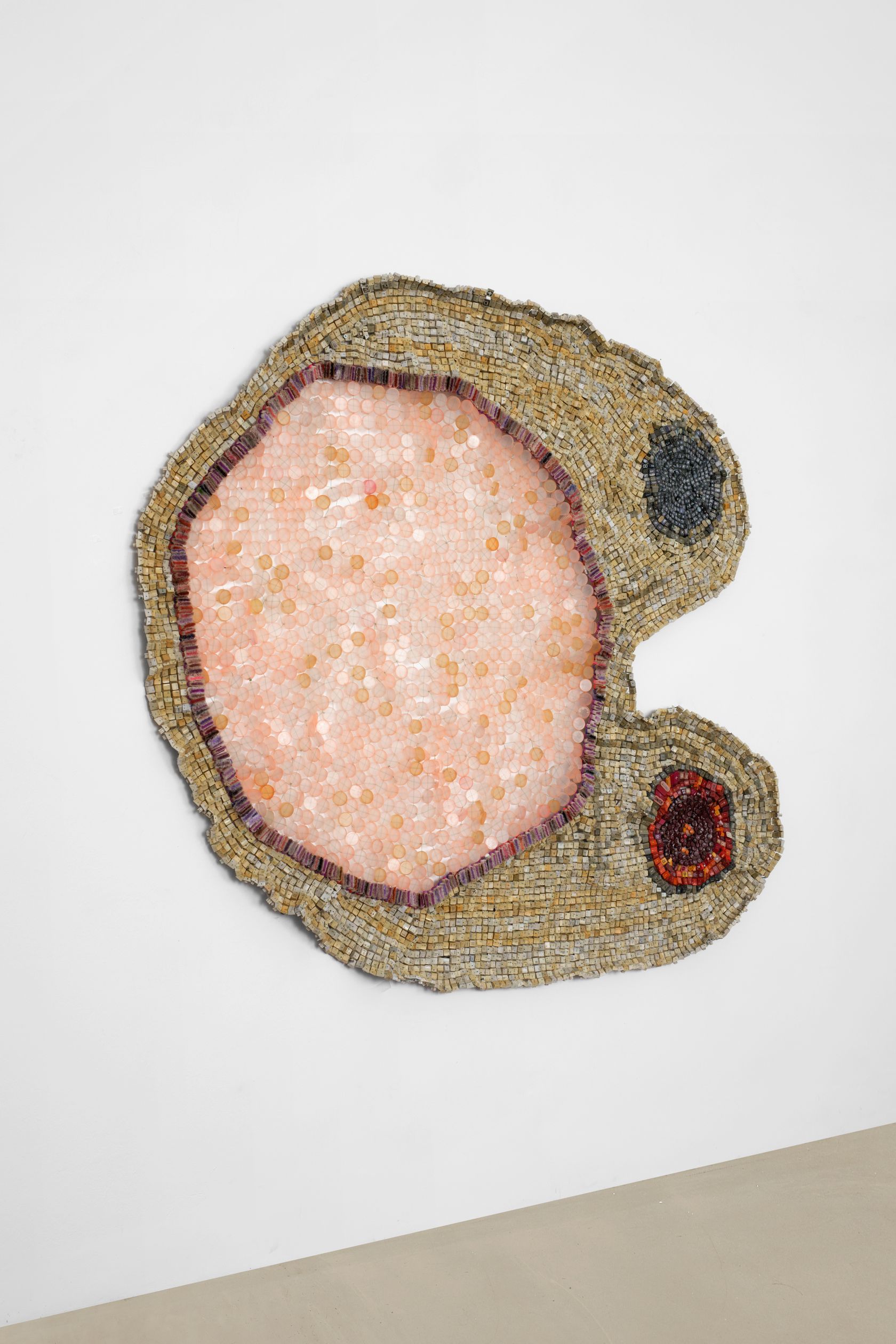
- Moffat Takadiwa
- Pink stone , 2024
- Computer keys, bottle tops, toothbrushes and calculator keys in plastic
-
- 165 ×
- 190 ×
- 7 × cm
- 64 15/16 ×
- 74 13/16 ×
- 2 3/4 × inches
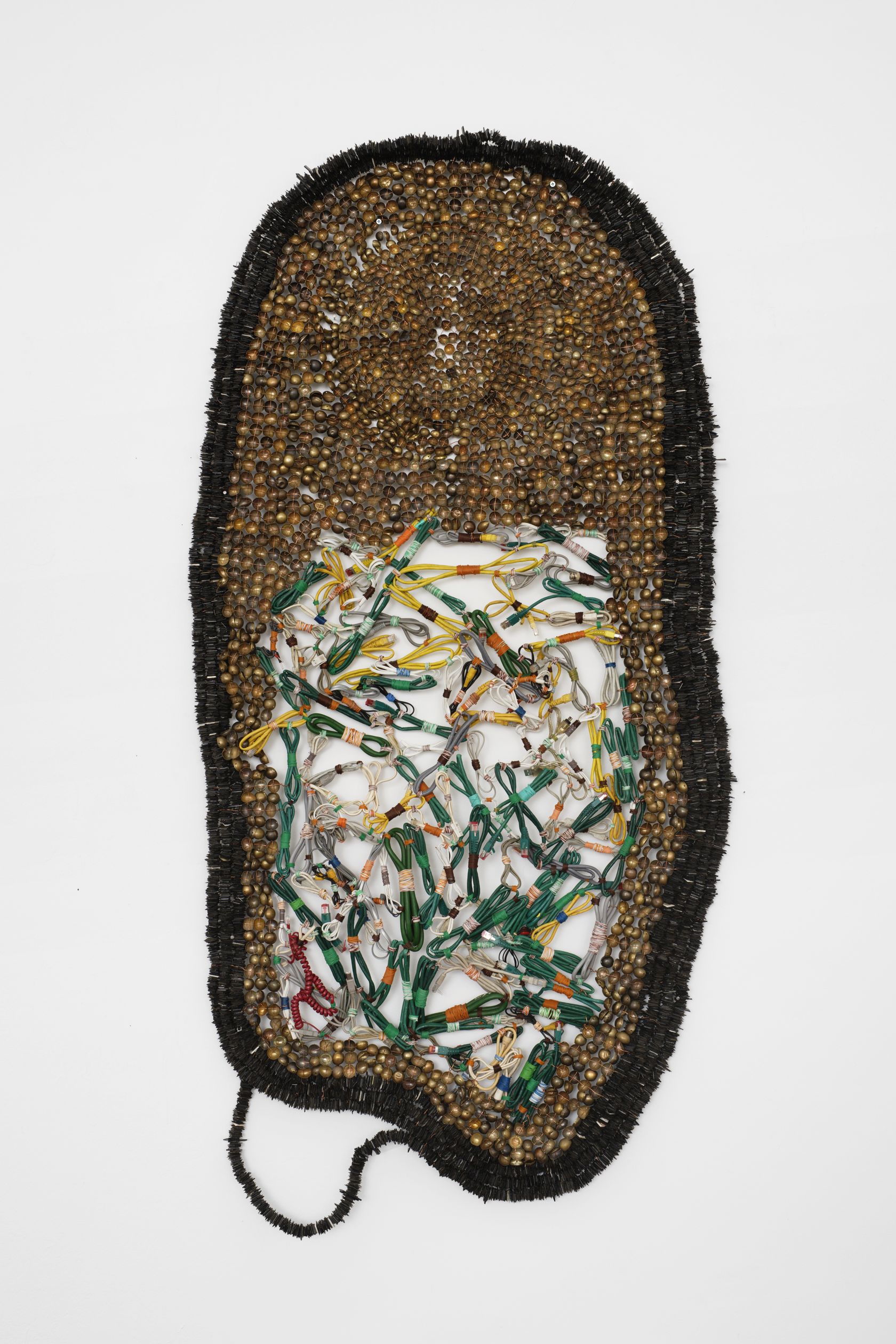
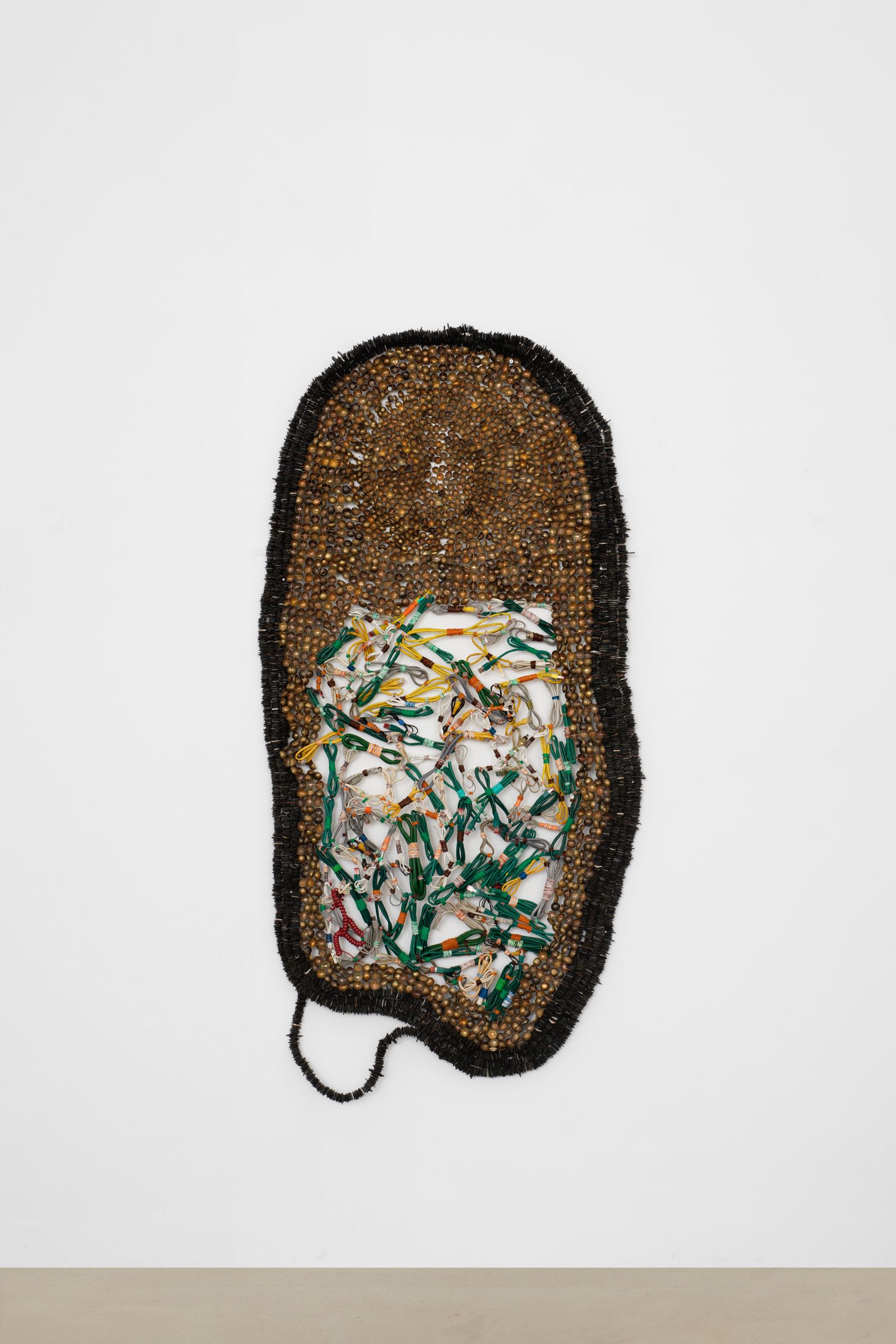
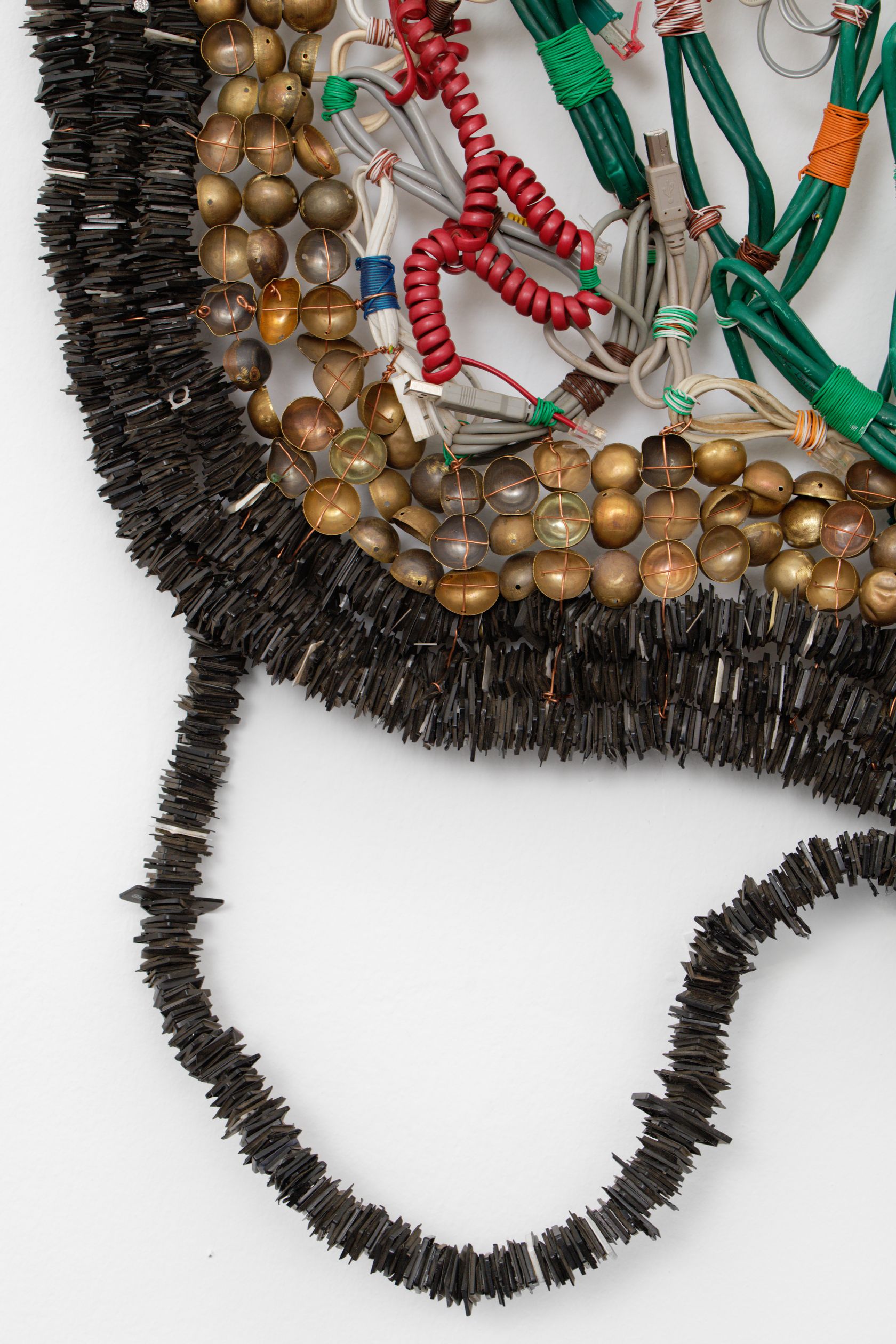
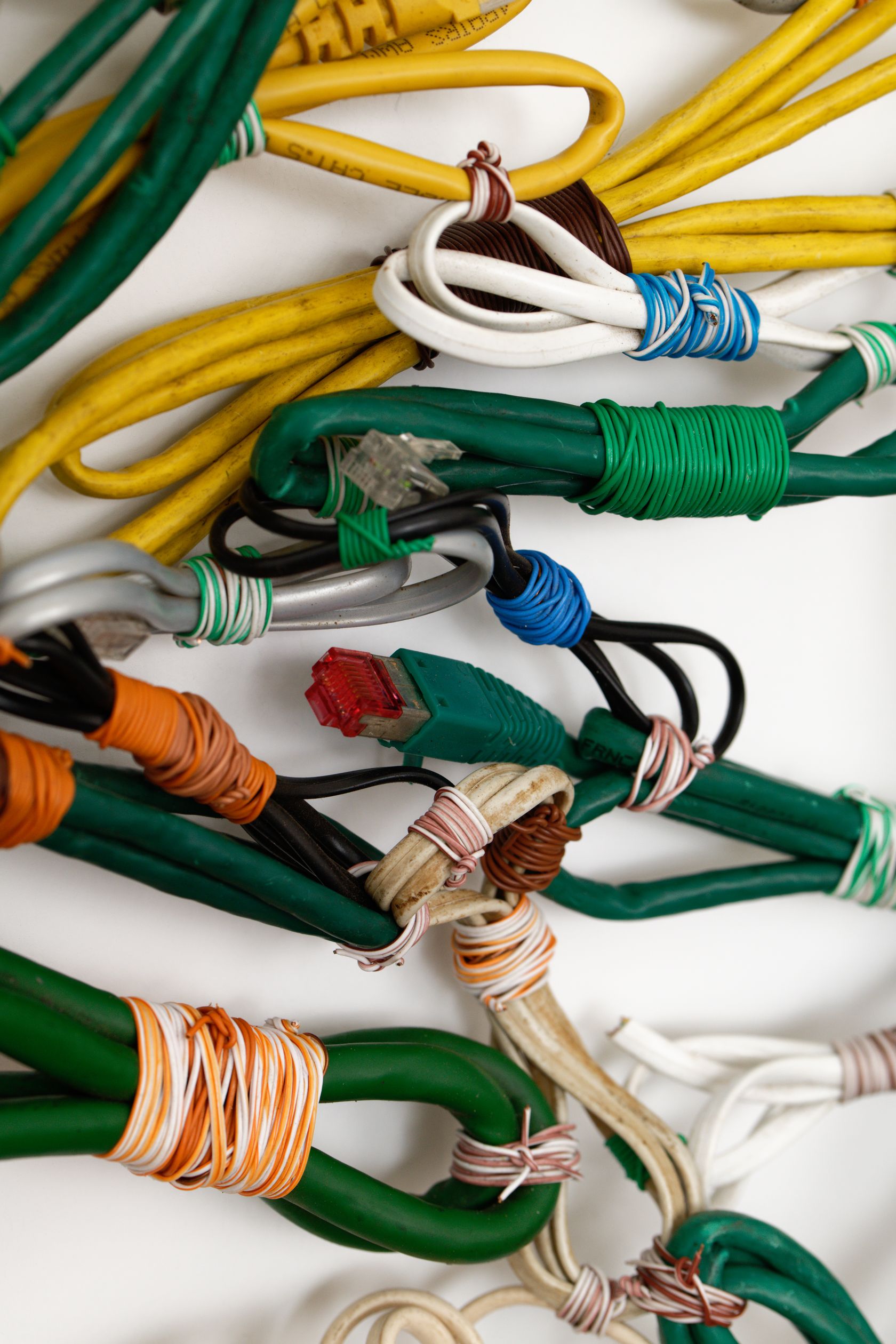
- Moffat Takadiwa
- Copper Belt , 2024
- Copper buttons, IT cables, plastic laptop keys, and soft copper wire
-
- 180 ×
- 90 ×
- 7 × cm
- 70 7/8 ×
- 35 7/16 ×
- 2 3/4 × inches
Art Brussels
April 25th - 28th, 2024
Booth 5E-39
Amélie Bertrand
Olaf Breuning
Hugo Capron
Drew Dodge
Steve Gianakos
Aneta Kajzer
Laurent Le Deunff
Françoise Pétrovitch
Abraham Poincheval
Laurent Proux
Philemona Williamson
Born in 1985, the painter Amélie Bertrand immediately gained recognition on her graduation from the School of Fine Arts in Marseille. By means of her impeccably smooth execution, the artist is able to distance herself from ideal landscapes inspired by nature, and shape decors that fall somewhere between dreams and nightmares.
The planes and surfaces of her works are assembled in a complex and meticulous manner, branching out into skewed perspectives and shallow horizons. All kinds of materials and motifs typical of our era saturate her compositions: OSB, laminates, wire mesh, tiles, fleecing, chains, foliage, camouflage etc. Colors are applied in gradients, yet always as a single layer, as if trapped on the surface of an impenetrable screen. Amélie Bertrand creates an atmosphere of déjà-vu, a contemporary ambience that is both psychological and physical within the confined space of the painting. “I never attempt to create real spaces, only painted ones.” As the missing link between Giotto and West Coast art, Amélie Bertrand combines the great traditions of painting with synthetic psychedelia. She strips back painting with her artificial perspectives and syrupy cocktails of colors, transforming contemporary visual culture into carefully controlled constructs of flat tints.
She has recently enjoyed solo and group exhibitions at Centre d’art contemporain de la Matmut - Daniel Havis, Saint-Pierre-de-Varengeville (FR), the Maison des arts, Malakoff (FR), the Centre d’art contemporain de Meymac (FR), the Kunstwerk Carlshütte, Büdelsdorf (DE), the Ecole Municipale des Beaux-Arts, Châteauroux and the Musée des Beaux-Arts de Dole (FR). Her oeuvres are included in the collections of the MAC VAL, Vitry-sur-Seine, the CNAP, Paris; the FRAC Limousin, Limoges (FR), Les Abattoirs Musée – Frac Occitanie Toulouse (FR) and the Musée de l’Abbaye Sainte Croix, Les Sables-d’Olonne (FR).
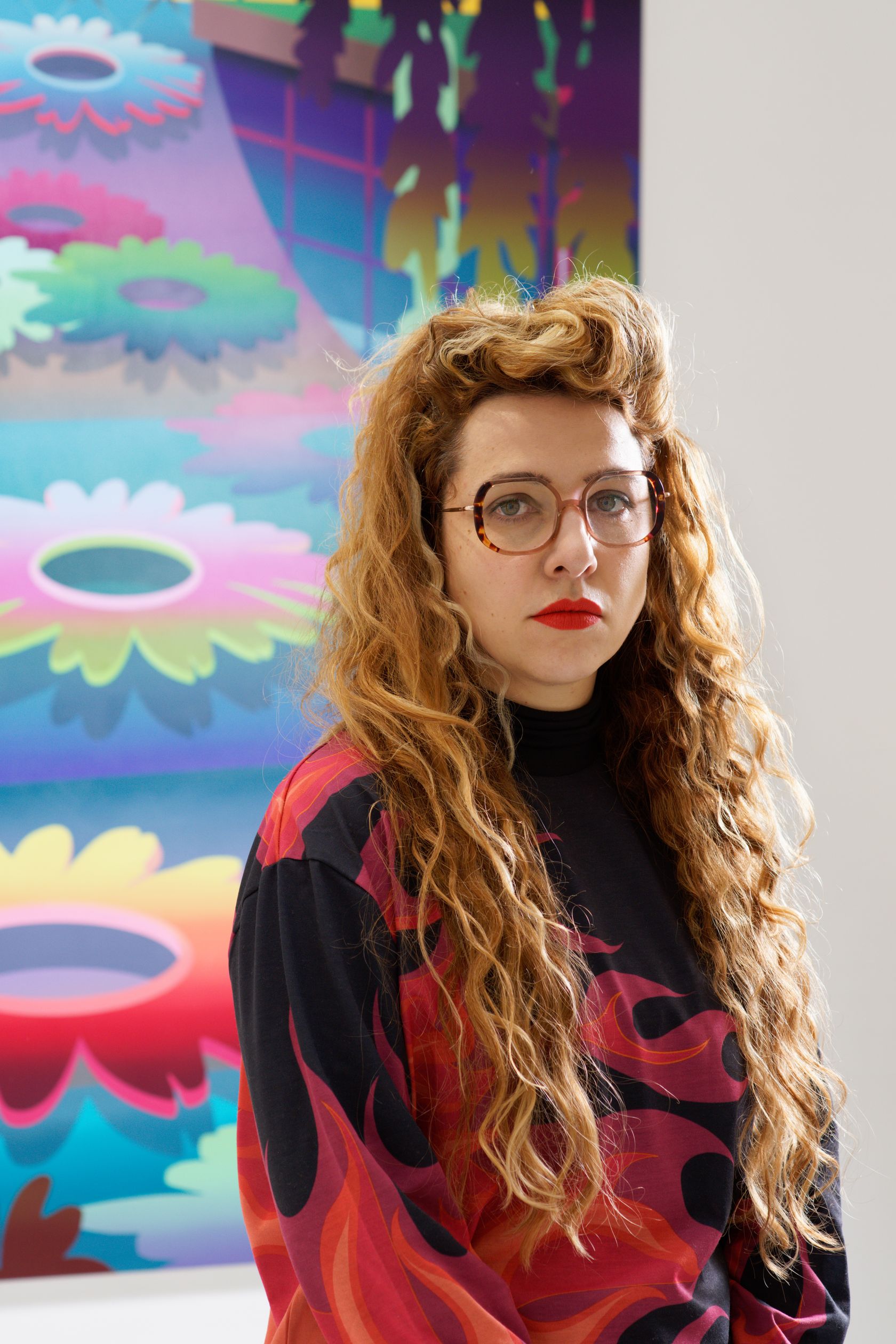
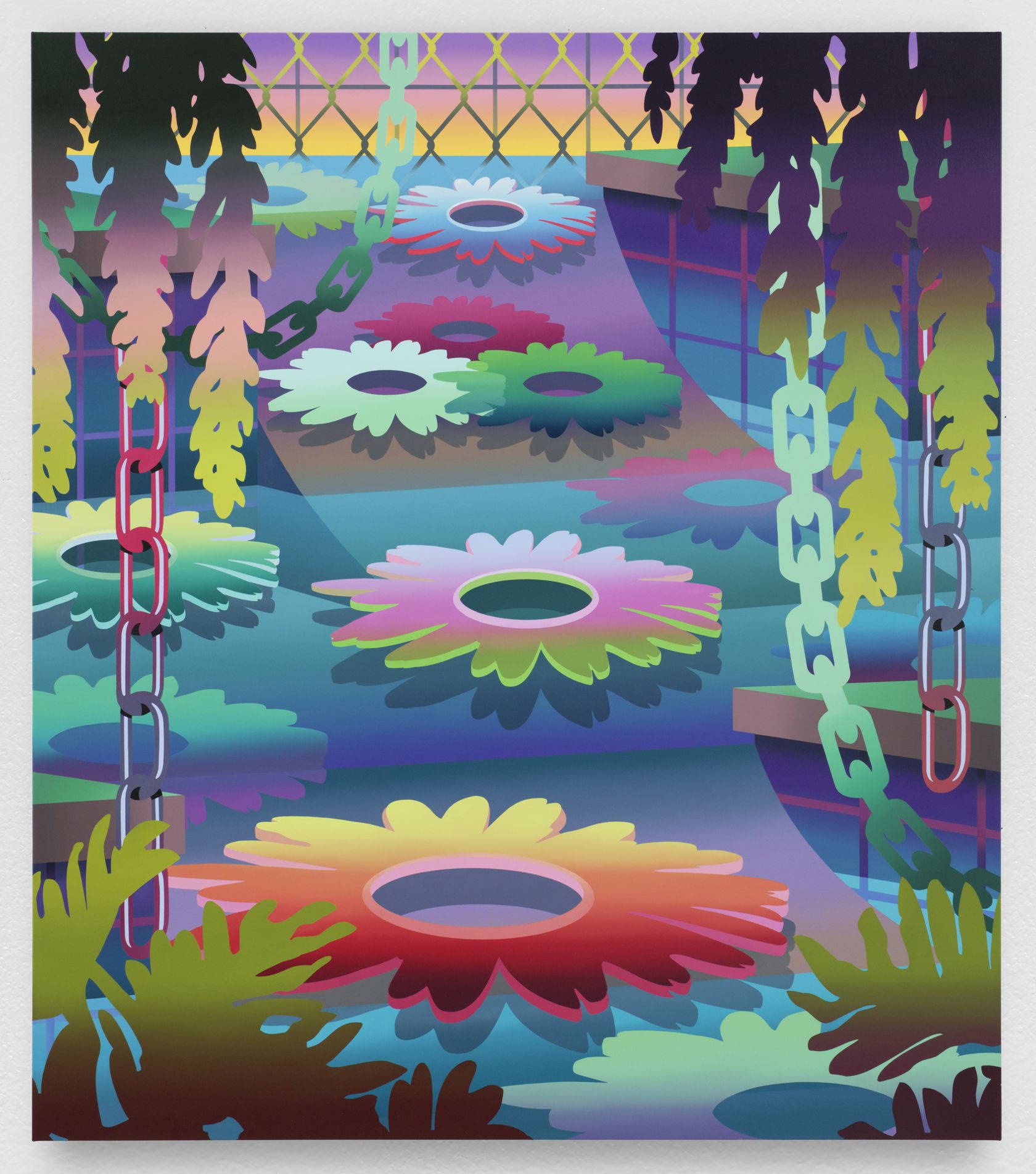
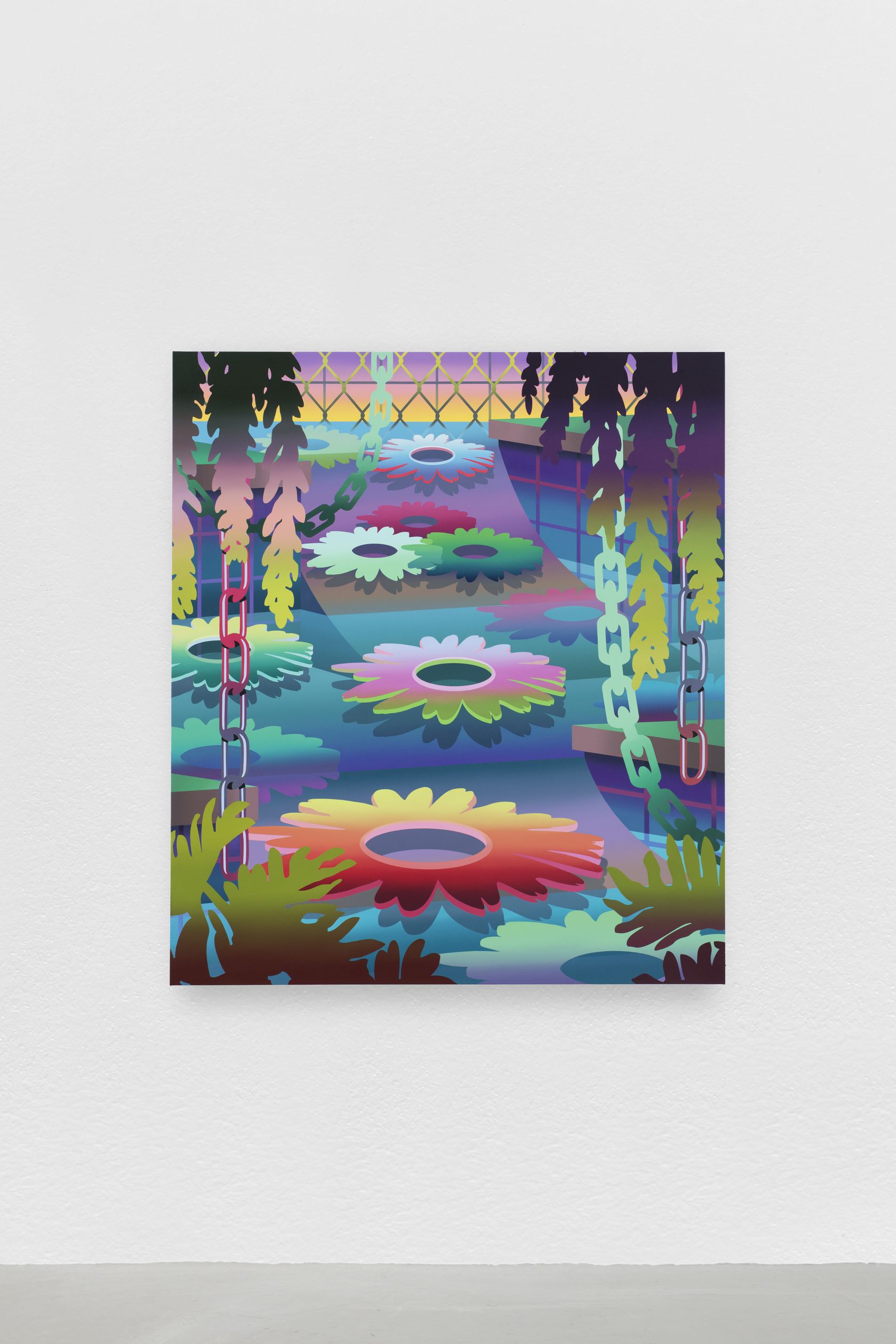
- Amélie Bertrand
- Wrong Way , 2023
- Oil on canvas
-
- 160 ×
- 140 × cm
- 63 ×
- 55 1/8 × inches
As something of an enfant terrible of the art world, Olaf Breuning views the world through disillusioned eyes and delivers an absurd and deceptively idiotic, satirical version of what he sees. His work can be perceived as a kind of personal diary, driven by everyday life, fueled by humor and fashioned by whatever might be at hand and with the help of a gang of friends. Stylistically, his work happily flirts with caricature and reveals an ongoing concern with man’s impact on nature. Olaf Breuning employs photography, film, ceramics, engraving and drawing to create a very direct and deliberately regressive form of art. Recently, he has added painting to his body of work: naïve and almost childlike forms and colors are applied using woodcut stamps made from solid wooden blocks, lending his highly rhythmic compositions the rustic aspect of wood engraving and the primitivism of art brut.
Olaf Breuning was born in 1970 in Schaffhausen (Switzerland), moving to the USA at the beginning of the 2000s. Today he lives and works in upstate New York. In 2016, he was the subject of a retrospective at the NRW-Forum in Düsseldorf and has enjoyed solo exhibitions at the Palais de Tokyo, Paris, the Chisenhale Gallery, London and at the Paul Klee Museum in Bern. He participated in the 2008 Whitney Biennial and his work has been featured in group exhibitions at the MoMA, New York, the Pompidou Center, Paris, the Haus der Kunst, Munich, the Kunsthalle, Zurich, the Walker Art Center, Minneapolis, the Jeu de Paume, Paris, the KW Institute for Contemporary Art, Berlin, the Whitechapel Gallery, London and the Mori Art Museum in Tokyo.
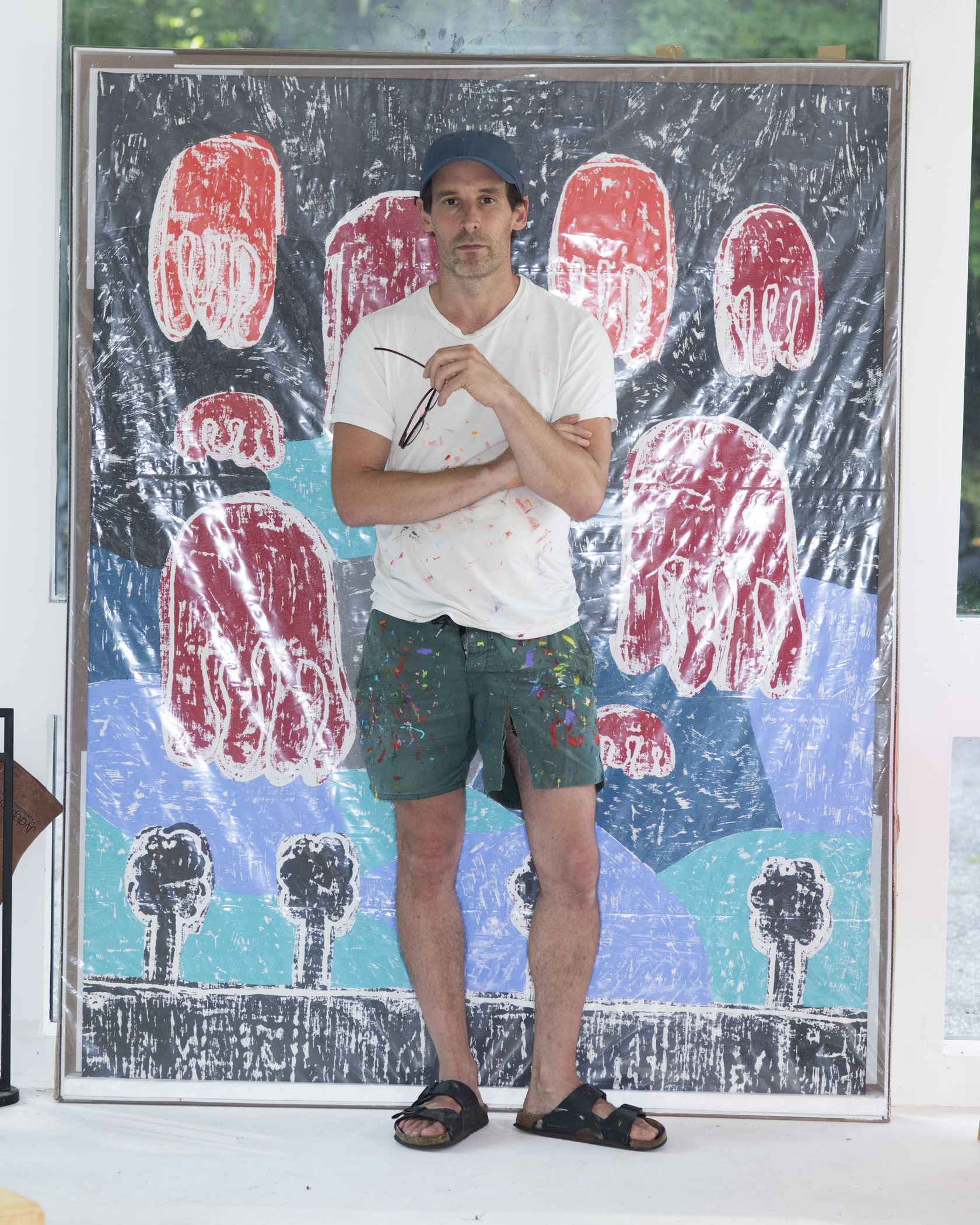
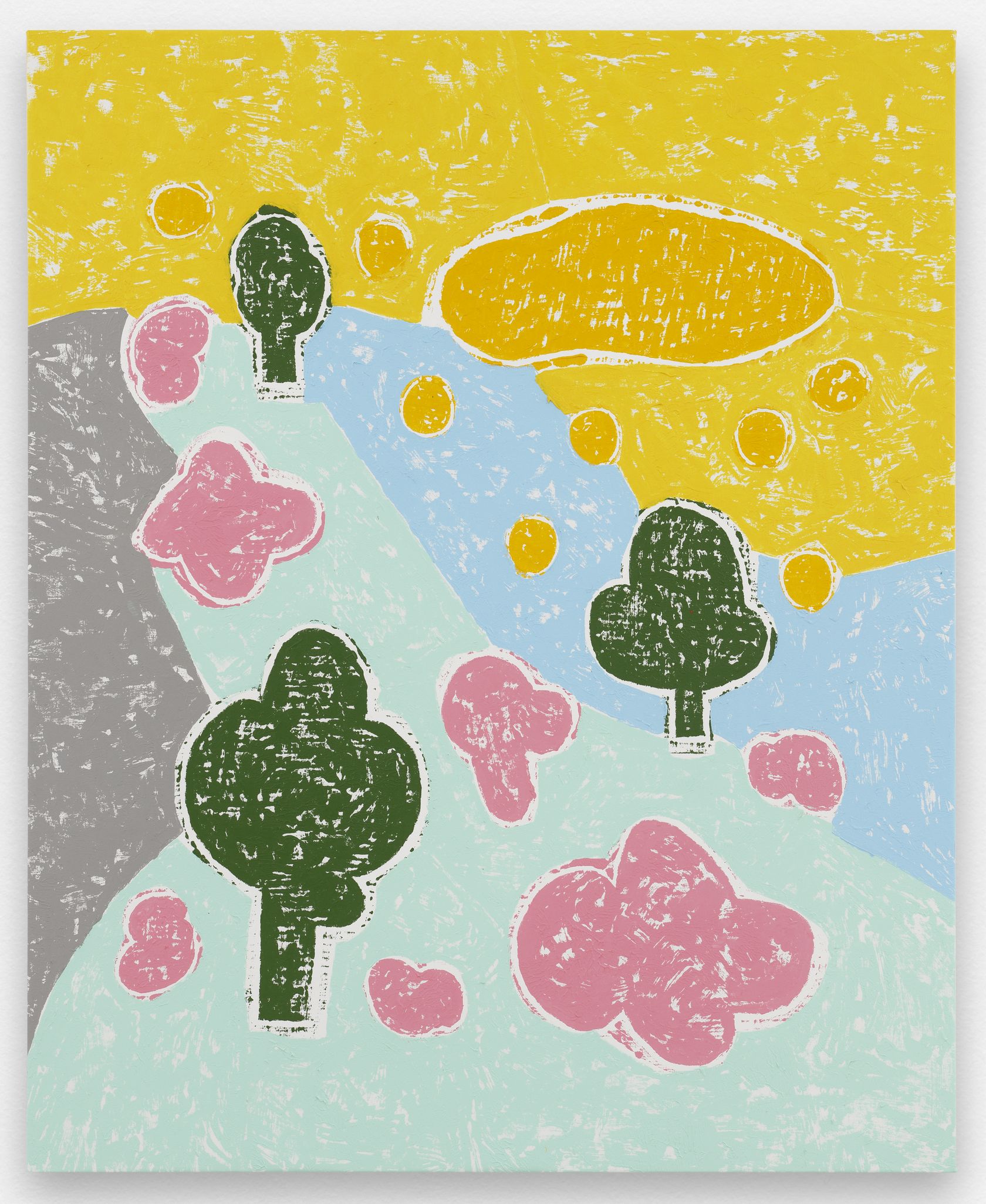
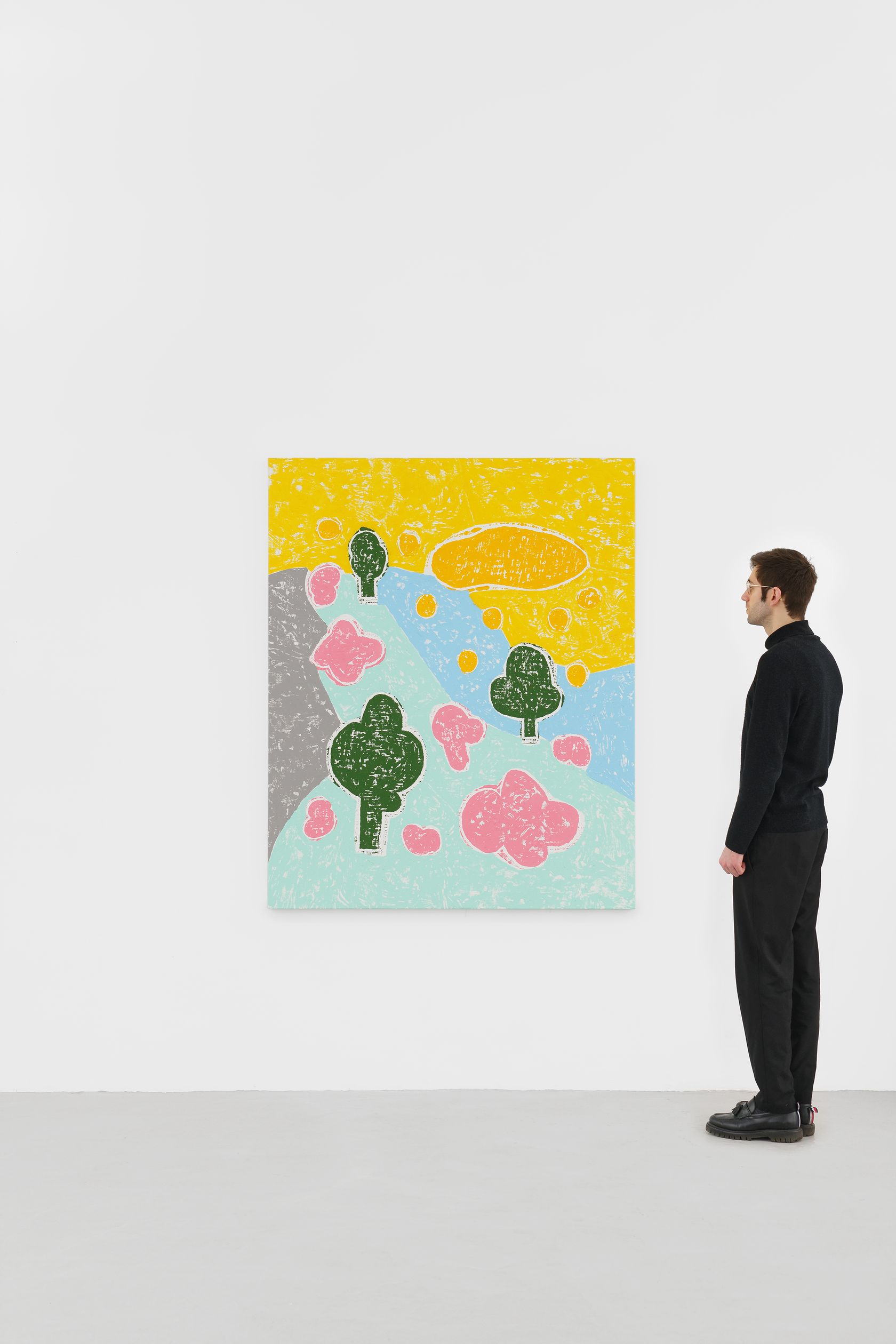
- Olaf Breuning
- Pink Flowers , 2021
- Woodcut, acrylic on canvas
-
- 160 ×
- 130 ×
- 3.5 × cm
- 63 ×
- 51 3/16 ×
- 1 3/8 × inches
With a background in printing, Hugo Capron's painting is based on the pleasure of reproducing the same image in long series that seek to exhaust all the possibilities of variation. His paintings are generally produced in one go and without repentance, but are nevertheless based on precise technical equations. Long interested in the correspondences between a volume of paint and a surface of canvas to be covered, his return from the Kujoyama Villa in 2019 led to a breaking point. His works began to represent subjects that were often classical and anonymous, borrowed from the history of etching or the history of painting.
Hugo Capron’s palettes are the result of fine investigations among suppliers from all over the world in search of the most accurate shades. On the canvas, they reveal themselves in a whole range of materials, juices and luminous extra thickness which emphasise the speed of execution. The gesture is almost calligraphic, it is a mixture of commas and loops.
Hugo Capron (b. 1989) lives and works in Dijon (FR). He graduated from the Ecole Nationale Supérieure d'Art et de Design, Dijon (FR). In 2021, he is the winner of the 8th edition of the Emerige Revelation Grant. His work has been exhibited in numerous individual and collective shows at the Hôtel des Arts, Toulon (FR), the Centre Régional d’Art Contemporain de Montbéliard (FR), the Collection Yvon Lambert, Avignon (FR), the Frac Bourgogne, Dijon (FR) and at Consortium, Dijon (FR). His work features in a large number of French and international, public and private collections.
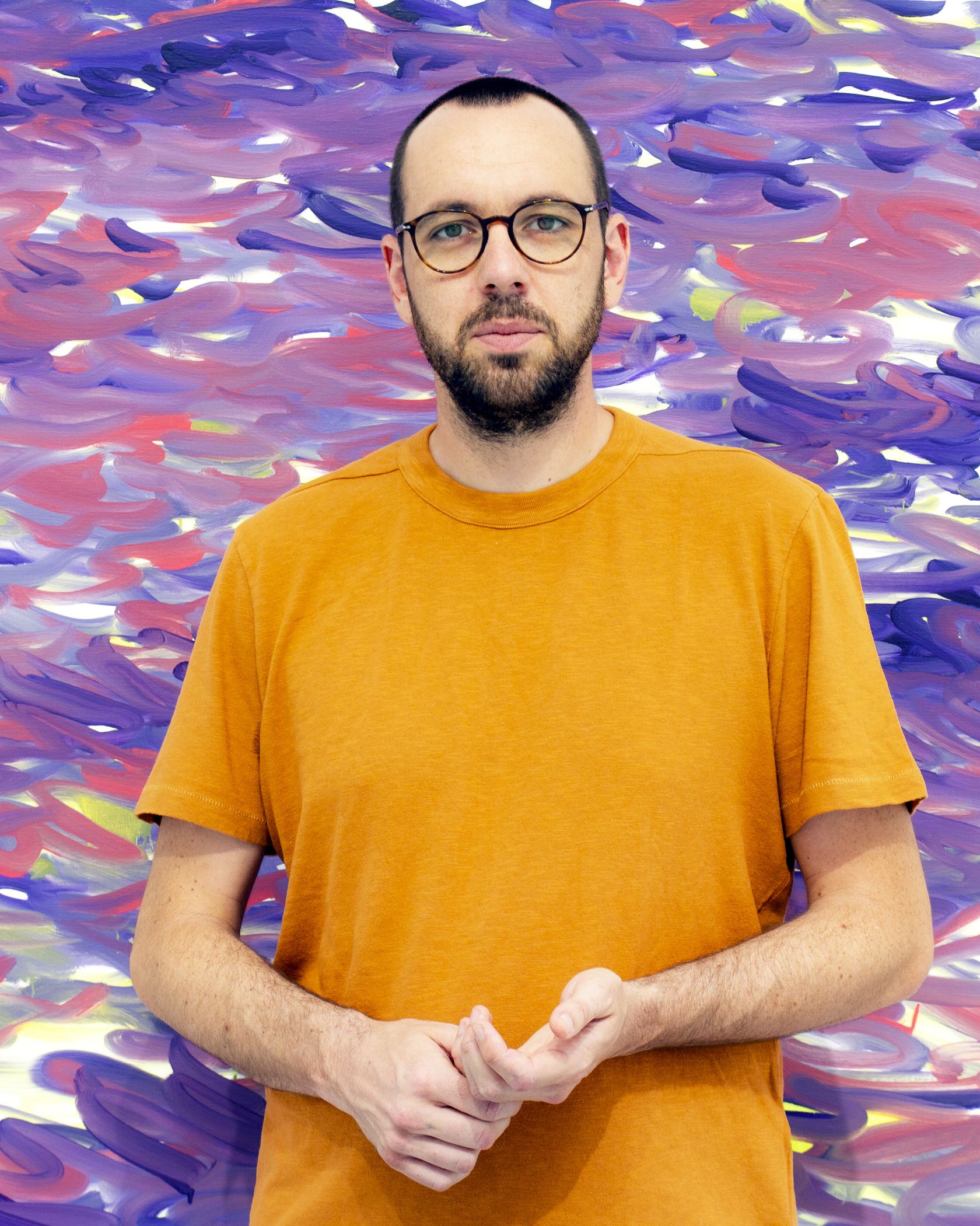
In Drew Dodge’s paintings, part human part canine figures often take part in suggestive activities, bathed in moonlight, in desert landscapes or perhaps in the setting of a ranch. An impression of tenderness and a peculiar eroticism emerge from the physical relationships between beings and objects. By softening the bristly texture of his colorful creatures, Dodge summons a balance between chaos, ecstasy, pleasure and pain. His masterful works bring together three artistic traditions: Religious painting from the European Renaissance and its powerfully structured pictorial spaces and intertwining bodies; American desert mysticism and its powerful symbolism; the cartoon, with its strange and seductive mix of animal and human characters.
Drew Dodge (b. 2001, Monterey, California, USA) lives and works in Providence, Rhode Island, where he recently graduated as a Bachelor of Fine Arts from the Rhode Island School of Art and Design. His already acclaimed work has featured in several exhibitions in the USA and Europe.
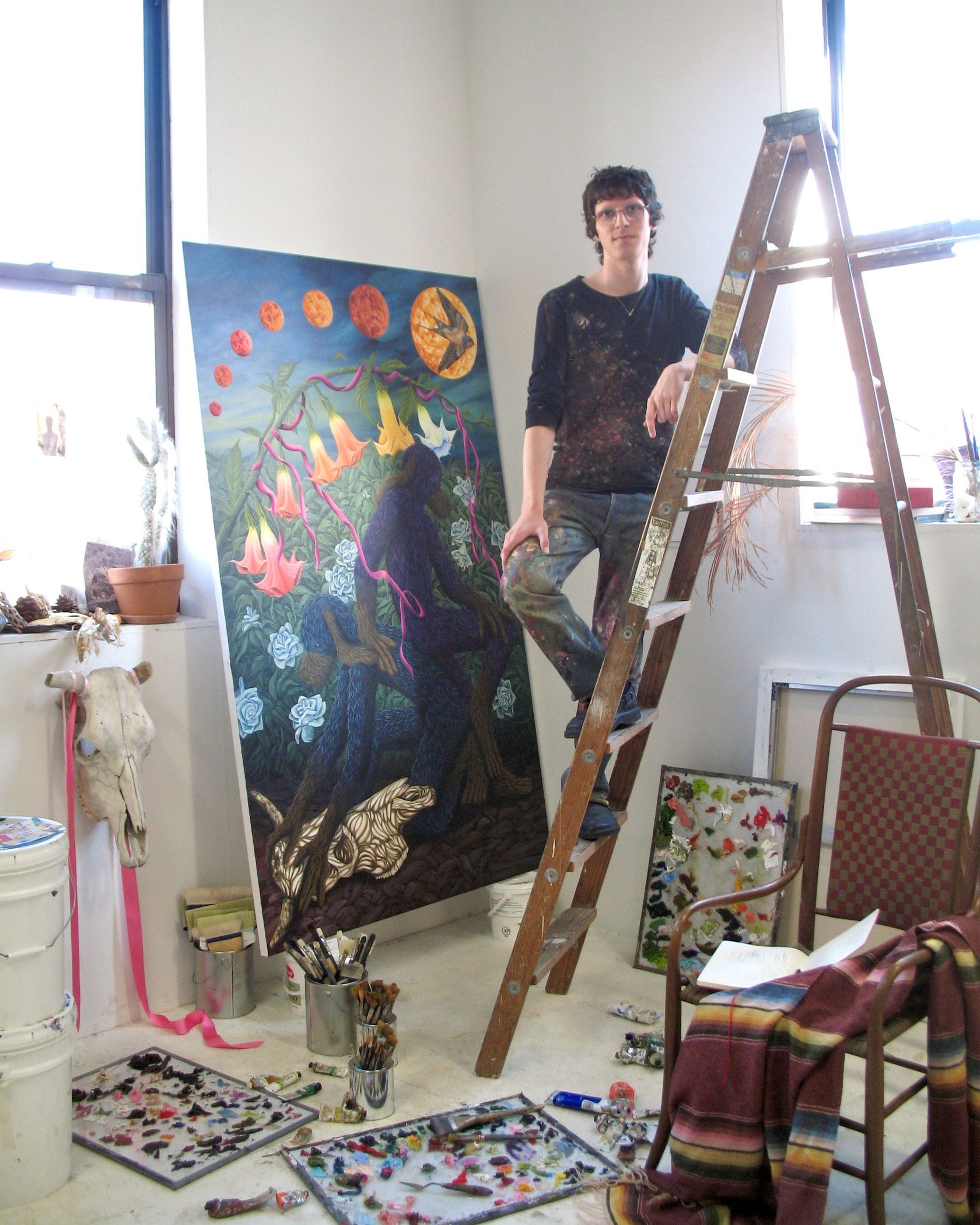
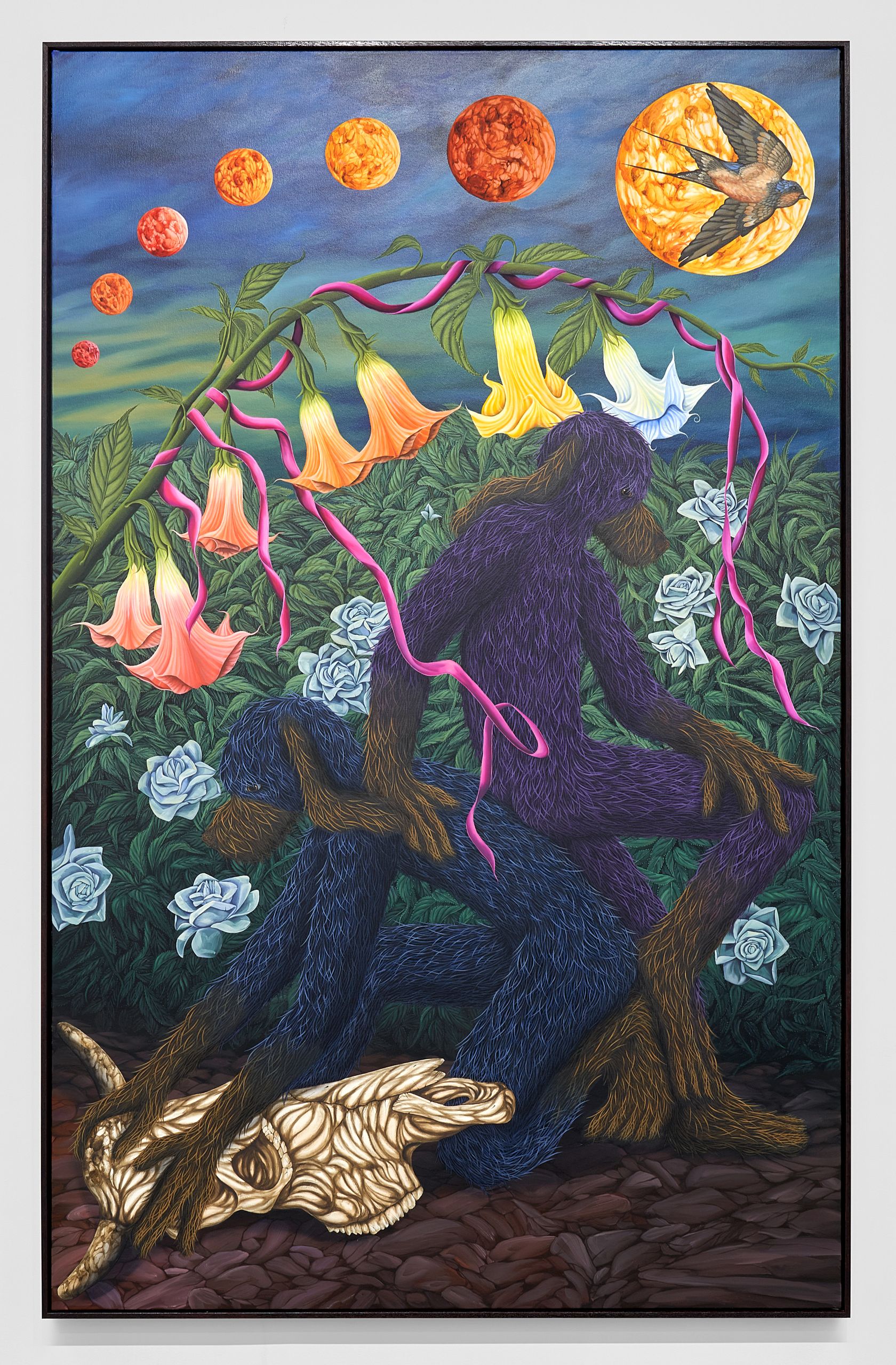
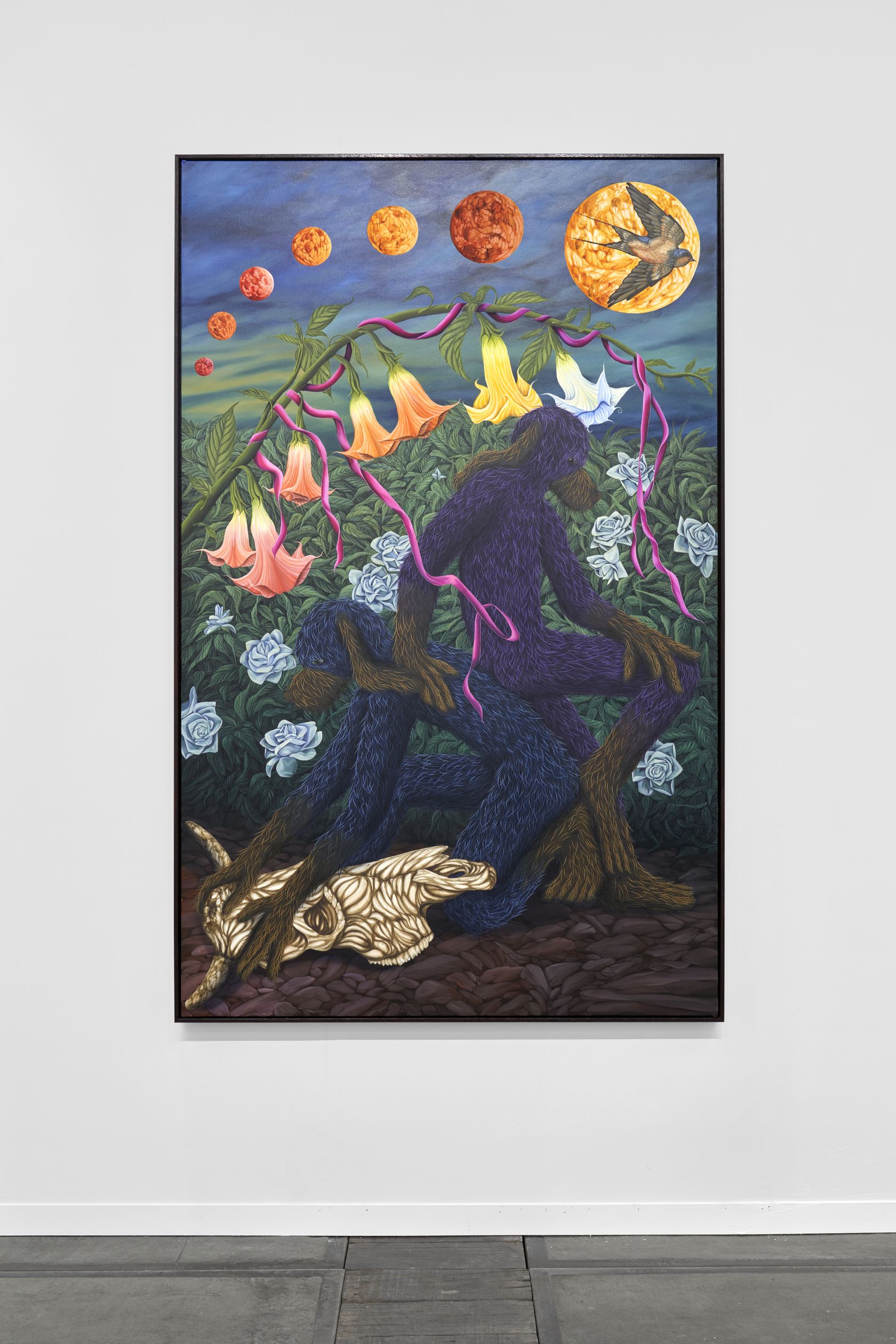
- Drew Dodge
- Head, Spine, and Spirit , 2024
- Oil on canvas
-
- 198 ×
- 122 × cm
- 78 ×
- 48 × inches
- unframed
- 201 ×
- 125 ×
- 5 × cm
- 79 1/8 ×
- 49 3/16 ×
- 1 15/16 × in
- framed
Born in 1938, the New York artist Steve Gianakos began developing his artistic language in the mid-1960s, in the midst of the Pop Art explosion on one hand and during the early days of Minimal Art on the other. From the clean brushstrokes of his paintings from the 1970s and 80s to the photocopied collages that began to proliferate later in his career, his lines have always remained sober and precise, distilling his trivial truths with a visual efficiency worthy of commercial art. As a Pop artist, Gianakos delves into a variety of sources—adult comics and 1950s children’s books amongst others—while encompassing references to Dada as well as Surrealism, his oeuvre is denoted by its overtly erotic and gory, punk attitude, leading to its qualification as underground. The most obscene, comical and cruel scenes are depicted in the naïve style of vintage comic books, joyfully undermining the American Dream.
Gianakos’ works feature in the most prestigious American public collections—MoMA, the Guggenheim, the New York Whitney Museum—as well as the CNAP collections in France. During the 1970s and 80s, he enjoyed exhibitions at PS1 in New York, Metro Pictures and the Marian Goodman and Barbara Gladstone galleries. In more recent years, he has participated in collective exhibitions at the MoMA, the Brooklyn Museum and the Queens Museum in New York and the Bonnefantenmuseum in Maastricht with Richard Artschwager, Peter Saul and John Wesley. In 2017, the Musée des beaux arts de Dole (FR) held a large retrospective exhibition of his oeuvres.
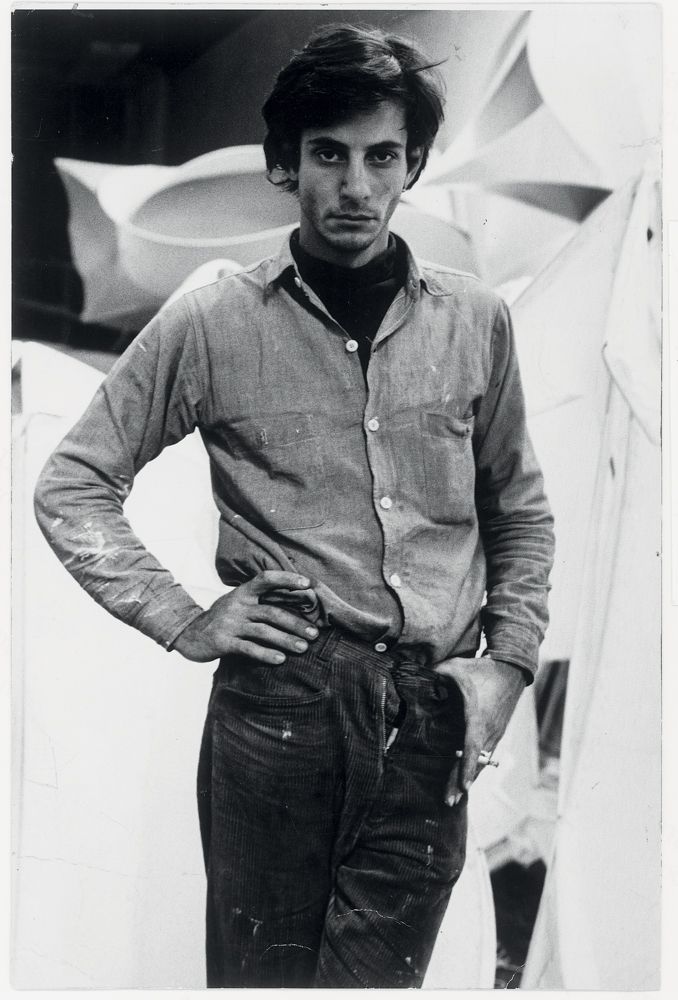
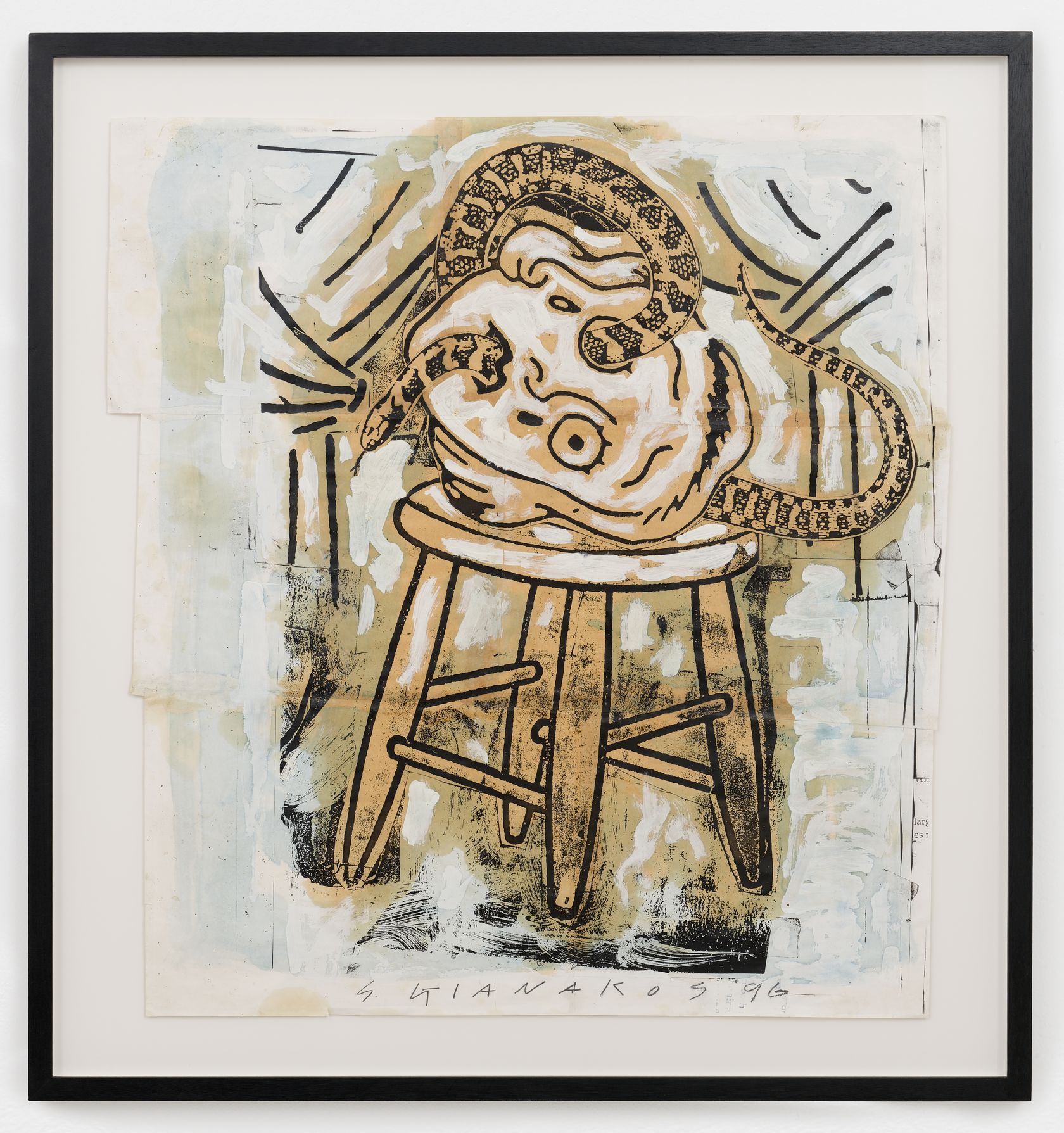
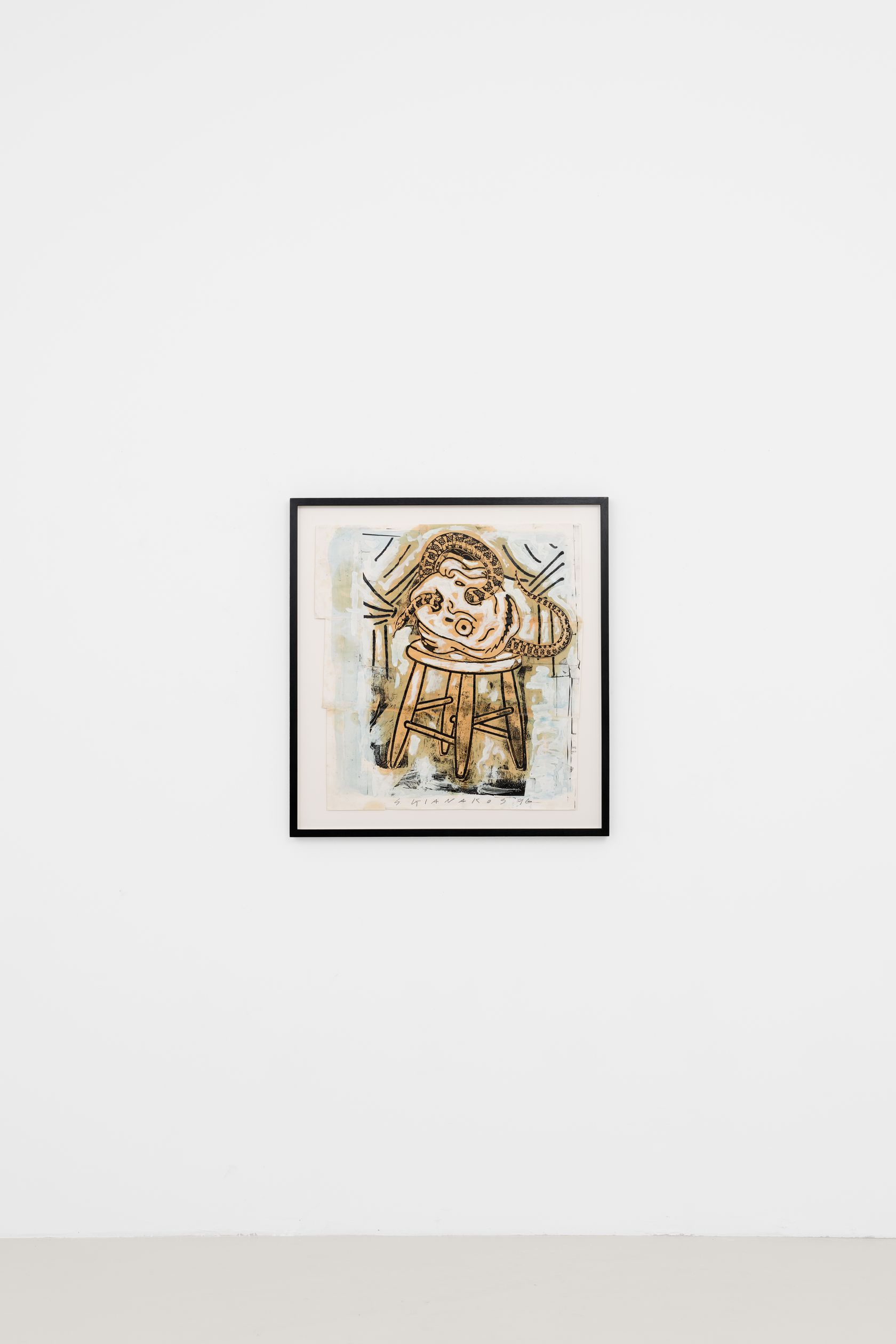
- Steve Gianakos
- She enrolled in acting school in Zurich , 1996
- Mixed media on paper
-
- 75 ×
- 70 × cm
- 29 1/2 ×
- 27 1/2 × inches
- unframed
- 89 ×
- 83.5 × cm
- 35 1/16 ×
- 32 7/8 × in
- framed
More abstract than CoBrA, more colorful than Joyce Pensato, Aneta Kajzer’s work sits assuredly in the ranks of Bad Painting. It eschews the normative concepts of the image, alternating between seriousness and humor and daringly treading the borderline between beauty and ugliness. Her deformed, diverse and sometimes-contradictory figures allow the spectator some insight into the artist’s social preoccupations: it is of no consequence if some things remain unresolved, as long as they exist. Her artistic process begins with her choice of colors and strokes, from which at first transitory forms emerge that constantly evolve before finally taking on their definitive shapes. In constant dialog with the motifs that appear on her canvases, Kajzer alternates between planned and intuitive gestures. She creates conflicting arrangements between abstraction and figuration, combining contradictory forms of expression. Often a perfectly placed comma of paint resolves the conundrum of the image as a whole, making full use of the phenomena of pareidolia and suggestive association.
Aneta Kajzer was born in 1989 in Katowice in Poland and lives and works in Berlin. She graduated from the Kunsthochschule Mainz and was awarded a residency at the Künstlerhaus Bethanien in Berlin. In 2018, she participated in the Goldrausch Künstlerinnenprojekt, a development program for female visual artists. Her work is regularly exhibited, particularly in shows dedicated to the contemporary rejuvenation of German art such as Now ! Painting in Germany Today in Deutschland, shown at the Deichtorhallen Hamburg, Kunstmuseum Bonn, Kunstsammlung Chemnitz and Museum Wiesbaden in 2019-2020. She has also enjoyed numerous solo exhibitions, most notably at the Conrads Gallery in Düsseldorf, the Künstlerhaus Bethanien and the Institut für Moderne Kunst in Nuremburg.
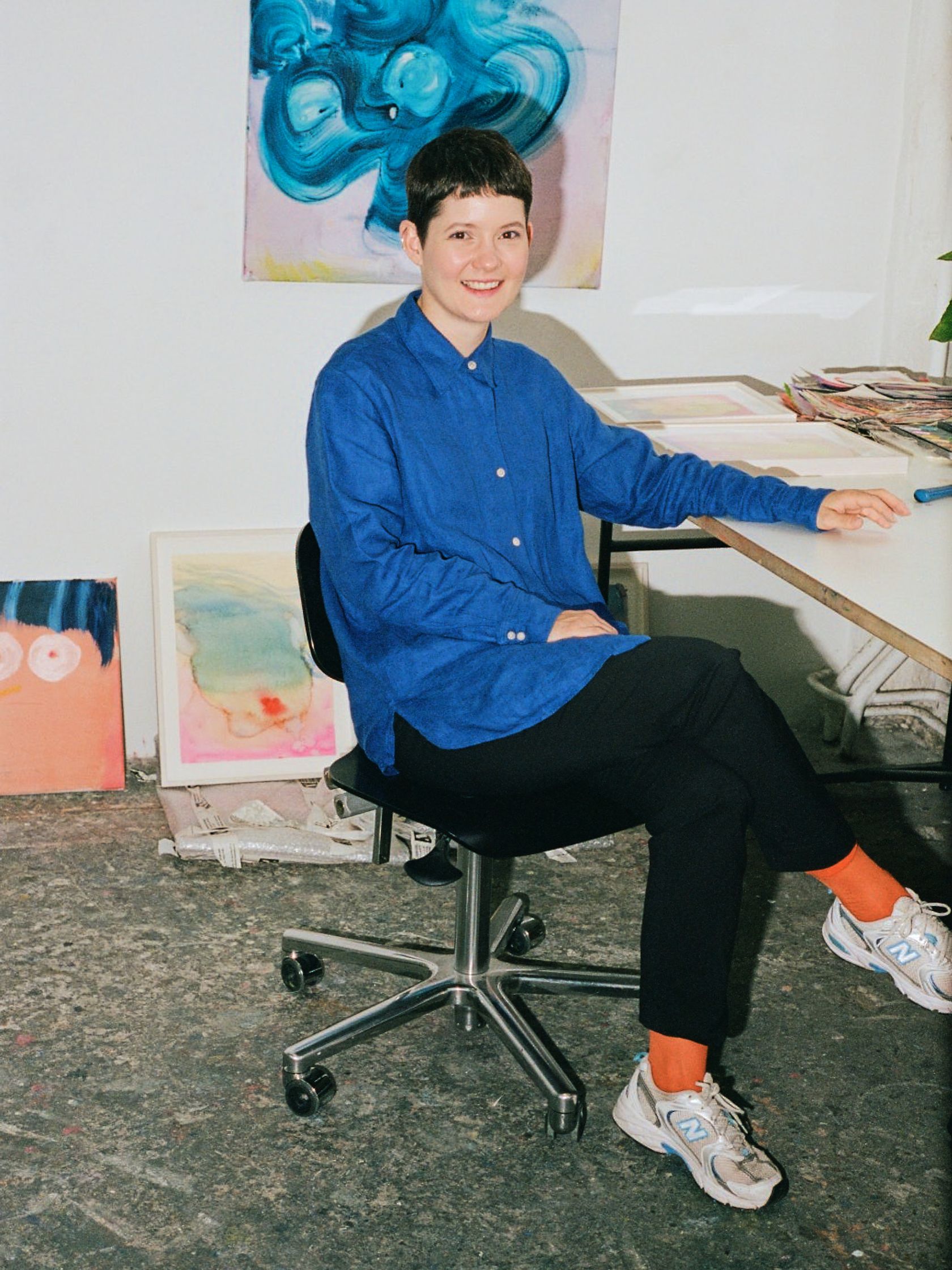
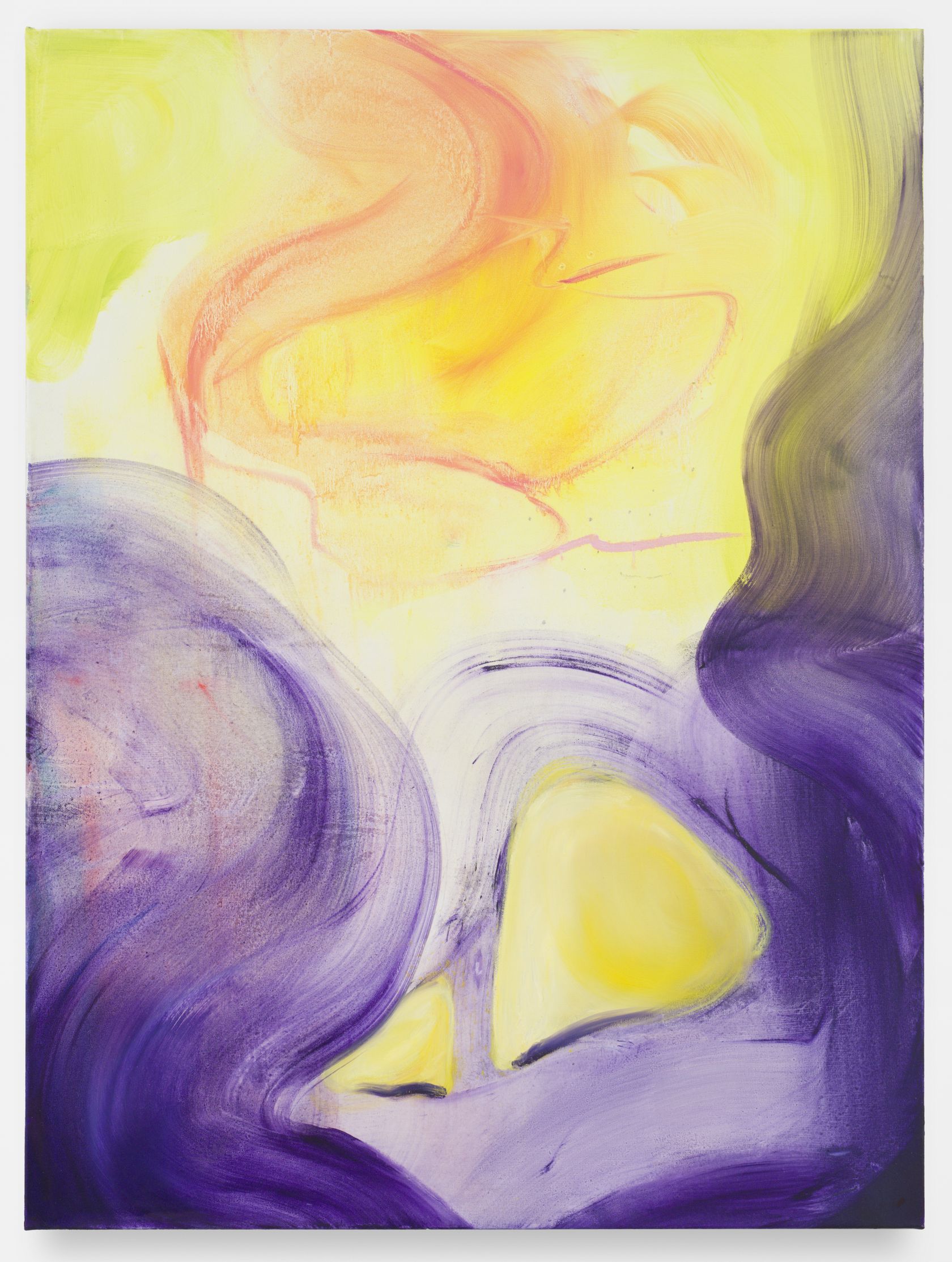
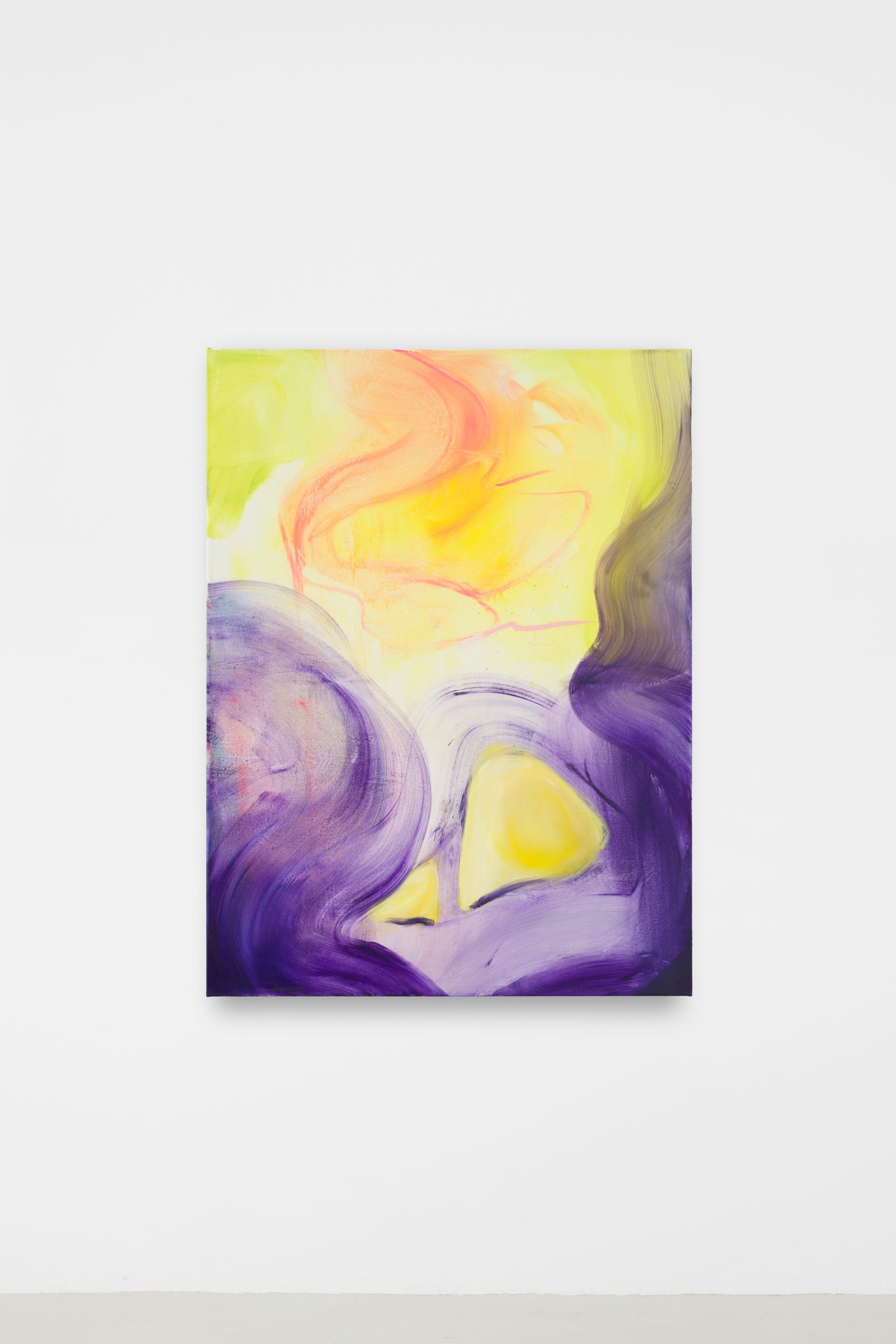
- Aneta Kajzer
- Schlangennest , 2024
- Oil on canvas
-
- 160 ×
- 120 × cm
- 63 ×
- 47 1/4 × inches
Laurent Le Deunff’s sculptures often mislead the eye due to the disparity between the materials used and the objects represented. He has a pronounced taste for traditional techniques from the world of arts and crafts as well as decorative artifices. The modesty of papier-mâché and fingernail clippings rubs shoulders with the nobility of bronze and deer antlers, and the rarity of fossilized dinosaur droppings sits side-by-side with the ordinariness of fake wood made from cement. Le Deunff’s meticulousness and acute sense of observation have also been deployed in his series of drawings—copulating animals, the footprints of imaginary monsters or artist’s cats—through which he explores animality, in a narrative that leaves plenty of space for the imagination. His bestiary brings together a wide variety of creatures—dolphins, slugs, moles seahorses and bears—without any hint of hierarchy of species. Humans are not excluded from the narrative, which reactivates a kind of archetypal primitivism: a prehistoric phallus and various totems and talismans transport civilization back to its most splendid origins.
His works have been the subject of exhibitions at La Halle des Bouchers, Vienne (FR), at Carré Scène nationale, Château-Gontier (FR), at Frac Île-de-France, Paris (FR), at Frac Normandie Caen (FR), at MOCO, Montpellier (FR), at Frac Poitou-Charentes, Angoulême (FR), at FRAC Nouvelle Aquitaine MÉCA, Bordeaux (FR), at MRAC Occitanie, Sérignan (FR) and at Musée d’Art Moderne Paris (FR). Laurent Le Deunff's work is held in the collections of the Musée d’Art Moderne de Paris (FR), MRAC Occitanie, Sérignan (FR), CAPC, Bordeaux (FR), Frac Île-de-France, Paris (FR), Frac Nouvelle-Aquitaine MÉCA, Bordeaux (FR), Frac-Artothèque Nouvelle Aquitaine, Limoges (FR) and Frac Normandie Caen (FR).
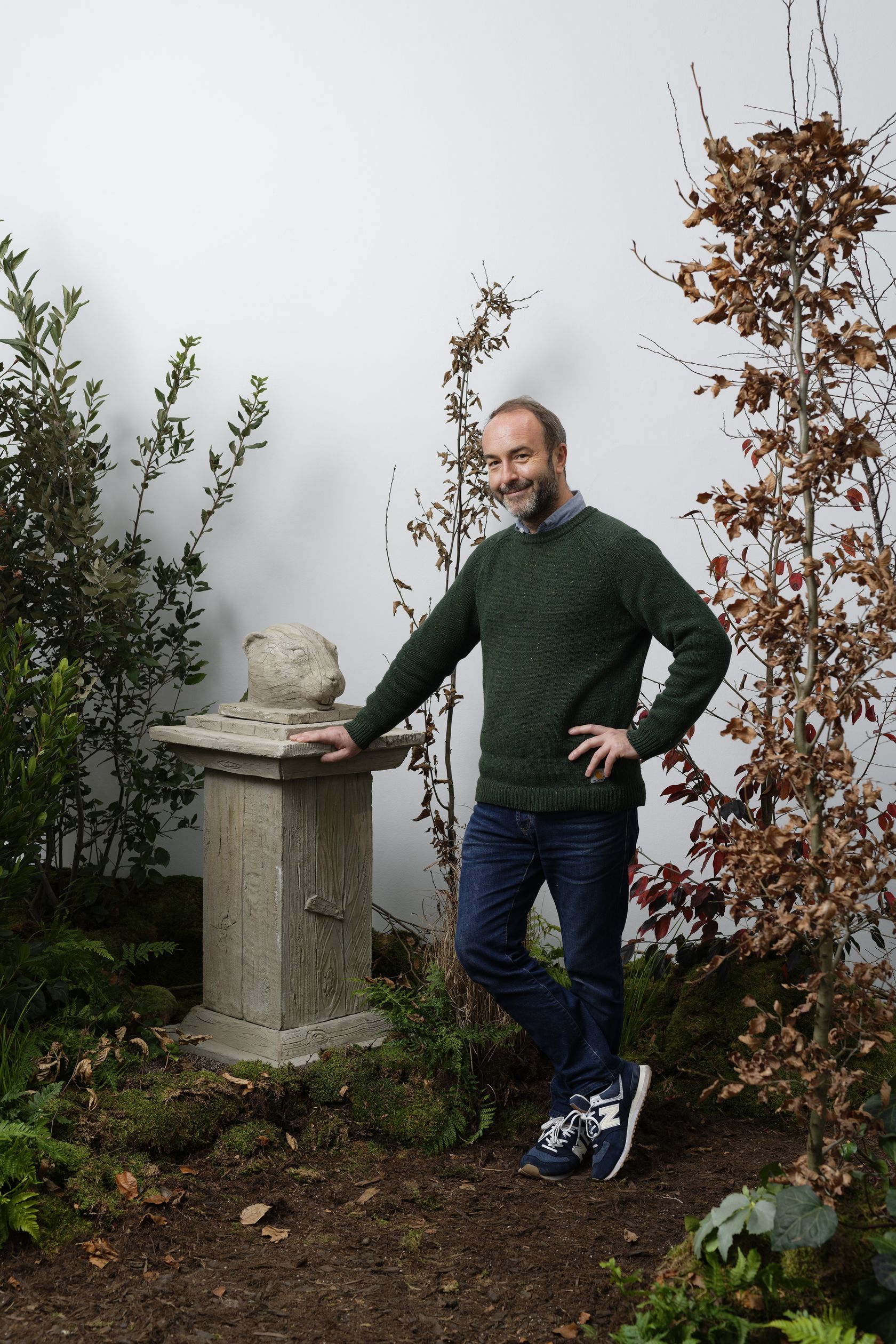
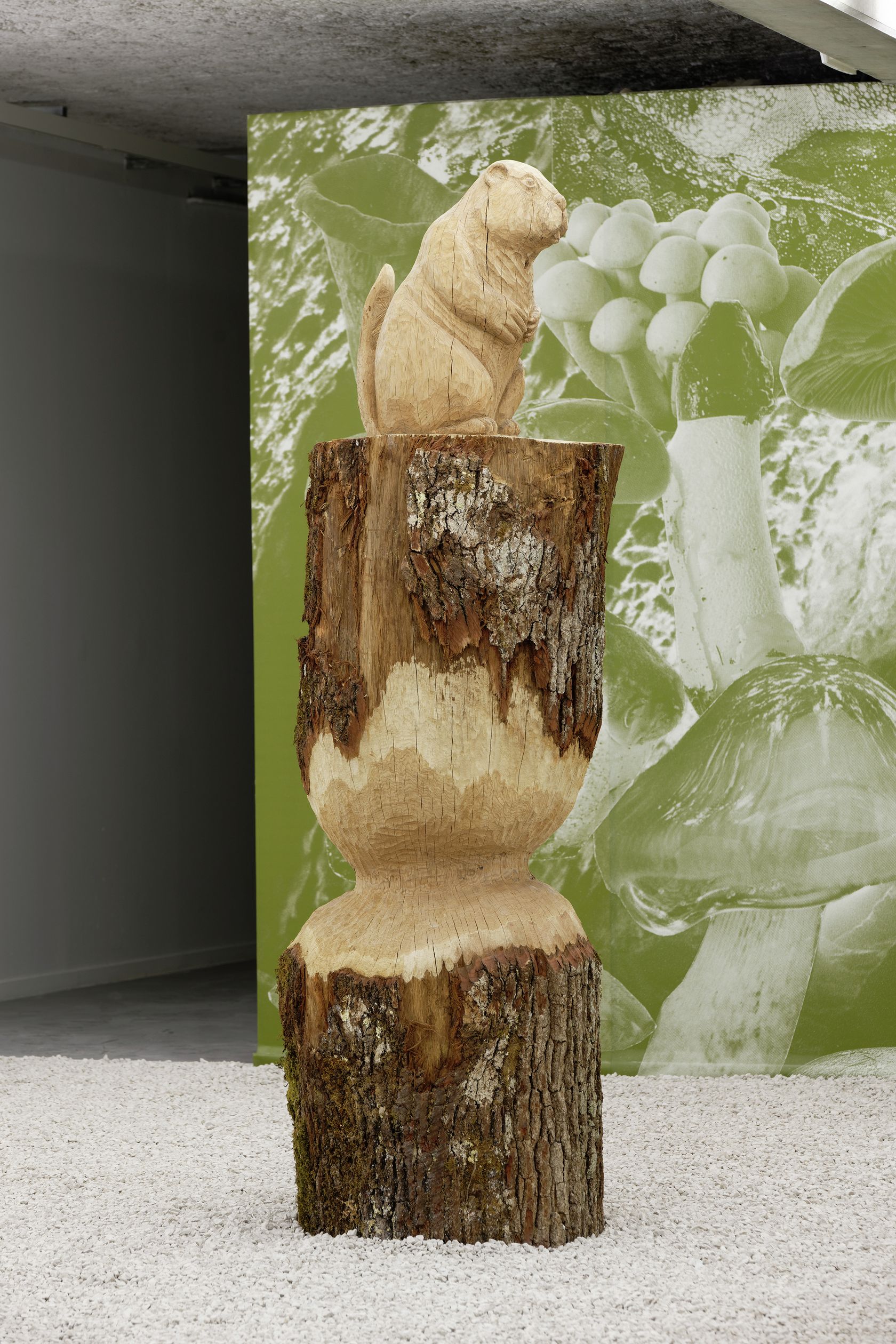
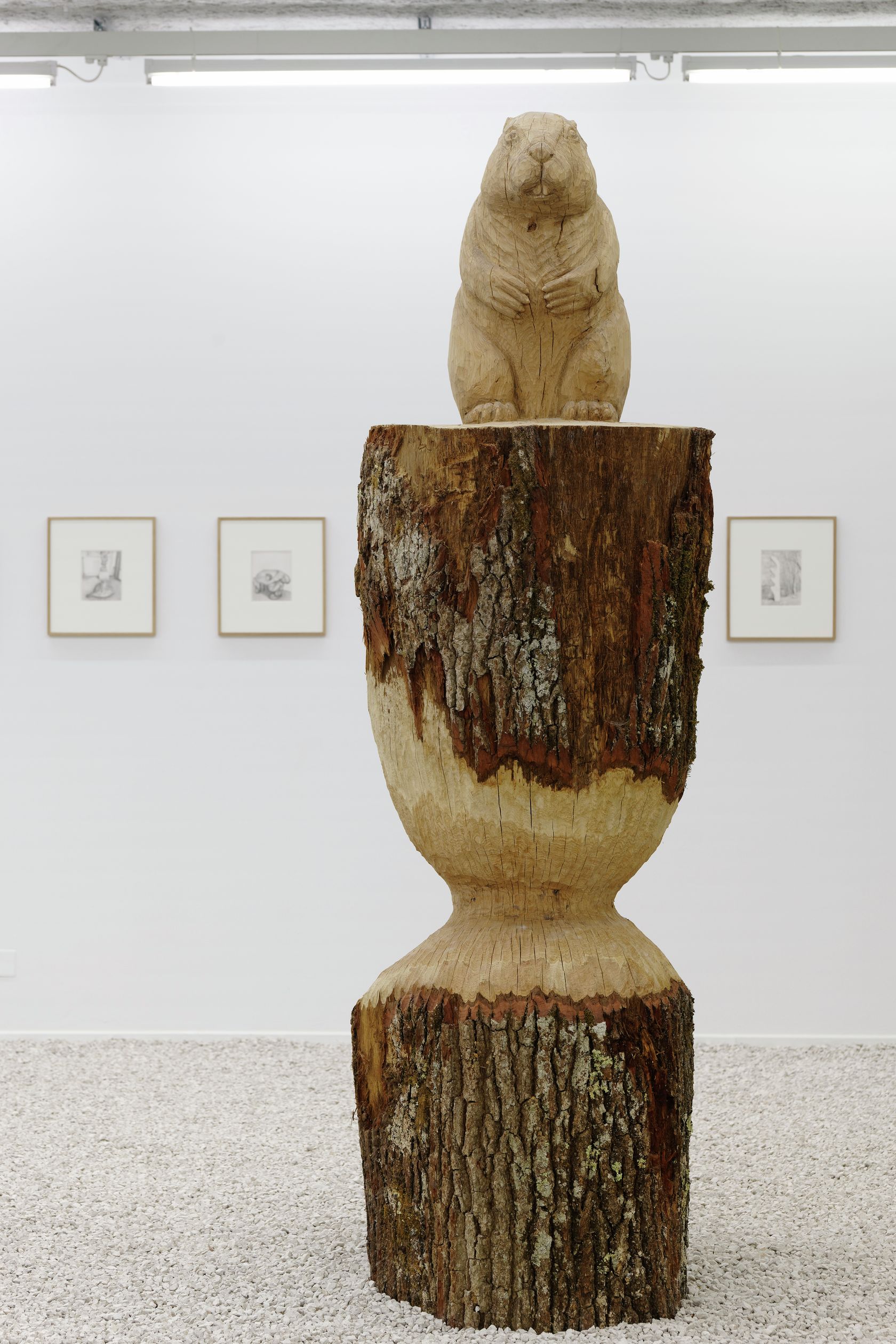
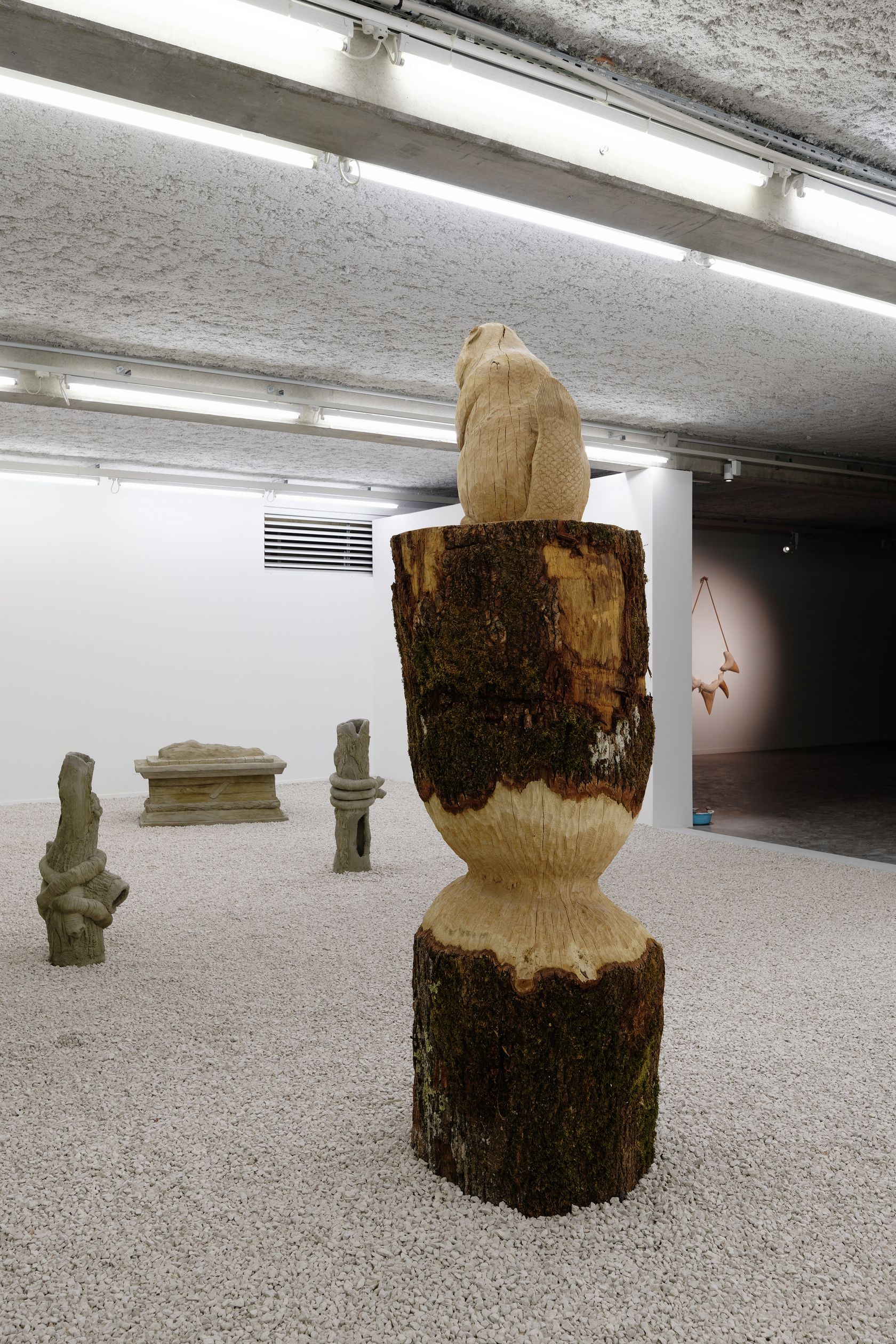
- Laurent Le Deunff
- Castor Poisson-Castor , 2021
- Oak
-
- 250 ×
- 70 ×
- 70 × cm
- 98 3/8 ×
- 27 1/2 ×
- 27 1/2 × inches
Since the 1990s, Françoise Pétrovitch has produced one of the most powerful bodies of work on the French art scene. Amongst the numerous media she has explored—ceramics, glass, ink washes, painting, print and video—drawing retains pride of place. In constant dialog with the artists who have preceded her, she has been able to measure herself against the incontrovertible motifs of “high art”—Saint Sebastian, still lifes, etc. Pétrovitch’s art reveals an ambiguous world, willingly transgressive, playing with conventional boundaries and eluding any interpretation. Intimacy, fragments of life and disappearance, alongside the themes such as the double, transition and cruelty run through her work, which is inhabited by animals, flowers and beings, and whose atmosphere fluctuates between light and dark, rarely leaving the spectator unmoved.
She has enjoyed numerous solo exhibitions both in France and abroad. The FHEL in Landernau (FR) hosted a major retrospective of her work and a monographic exhibition was dedicated to her at the BnF, Paris in 2022. In 2018, she was the first contemporary artist to be awarded a solo exhibition at the Louvre-Lens. Over the past few years, Pétrovitch has produced monumental wall drawings and large format ensembles, for the Galerie des Enfants at the Centre Pompidou, the West Bund Museum, Shanghai, or for the Ballets du Nord Company. Her works are included in many private and public collections, most notably the Centre Pompidou, Paris (FR), the Voorlinden Museum, Wassenaar (NL), the National Museum of Women in the Arts, Washington D.C. (US), the Musée Jenisch, Vevey (CH), the Musée d’Art Moderne et Contemporain of Saint-Etienne (FR) and of Strasbourg (FR), the MAC VAL (FR) and numerous regional art centers throughout France as well as the Salomon and Guerlain Foundations.
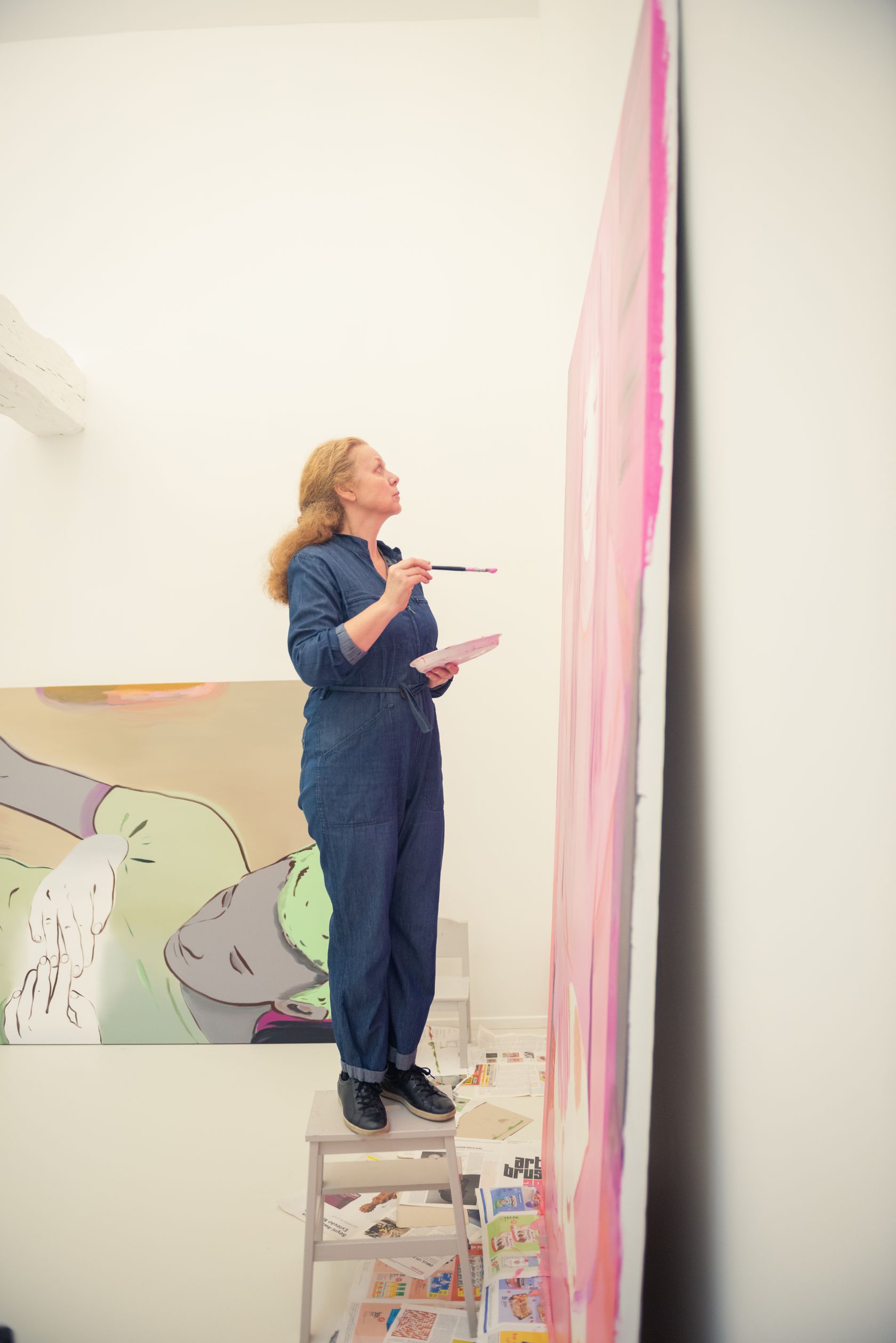
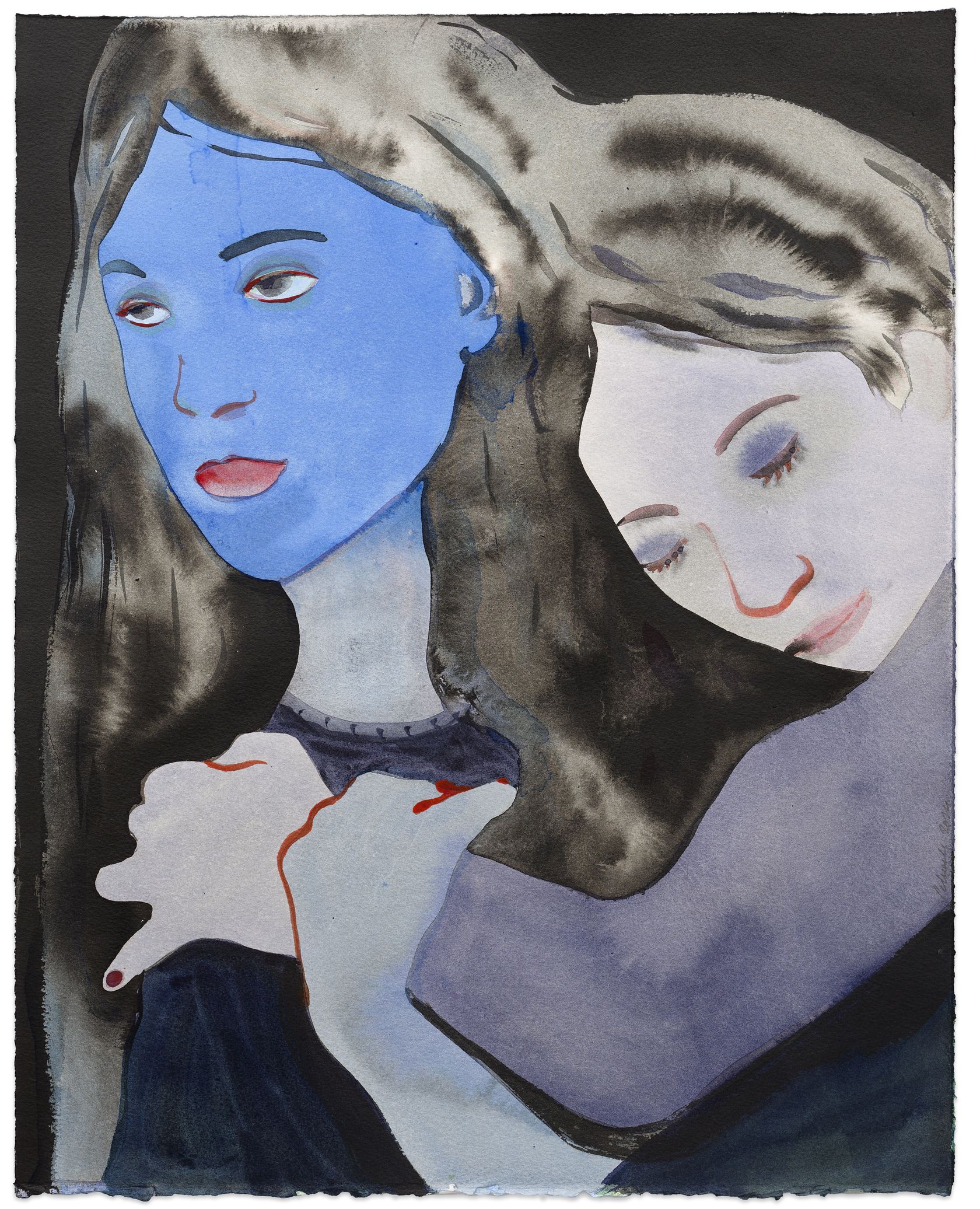
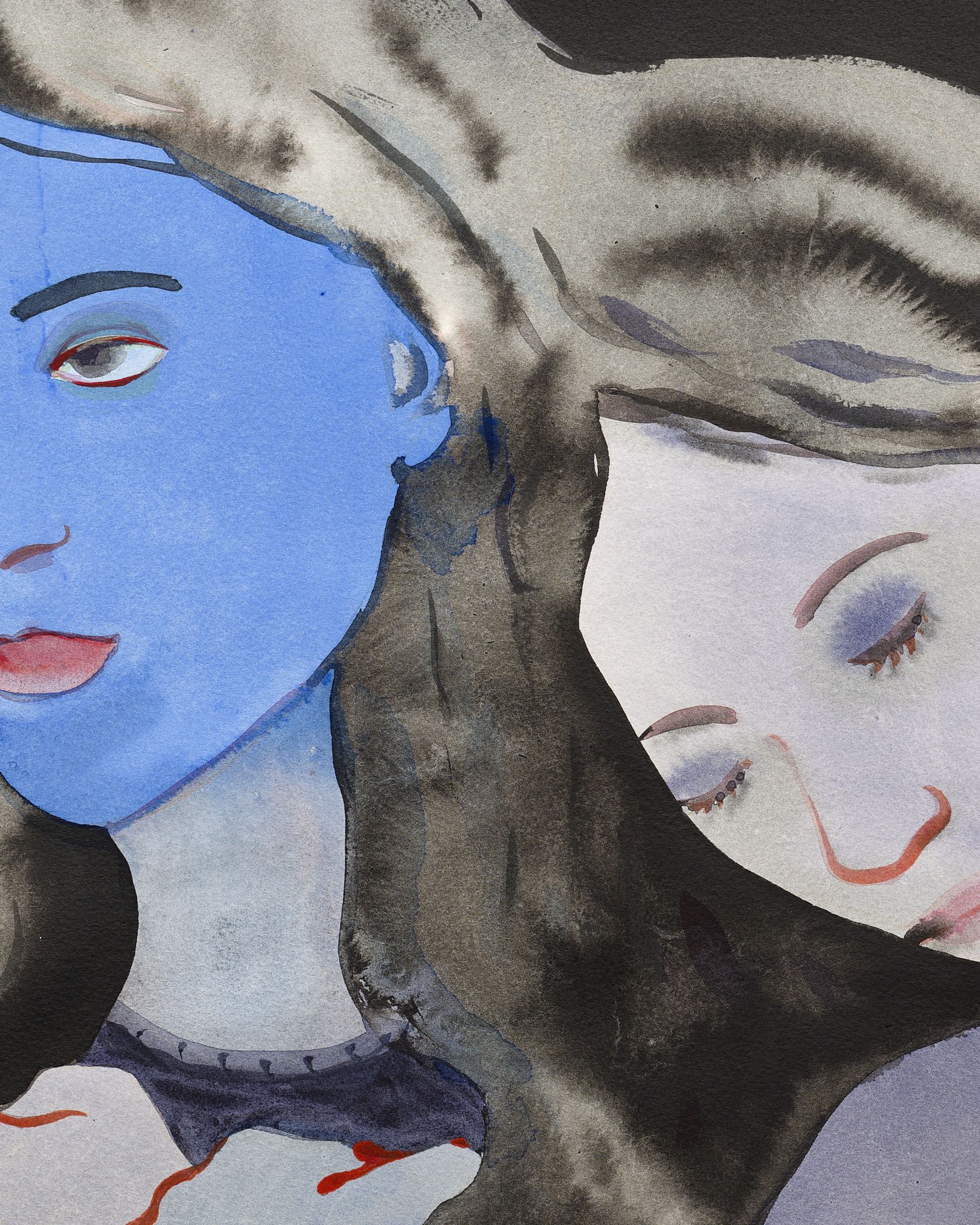
- Françoise Pétrovitch
- Sans titre , 2024
- Ink wash on paper
-
- 50 ×
- 40 × cm
- 19 11/16 ×
- 15 3/4 × inches
- unframed
- 62 ×
- 52 ×
- 3.5 × cm
- 24 7/16 ×
- 20 1/2 ×
- 1 3/8 × in
- framed
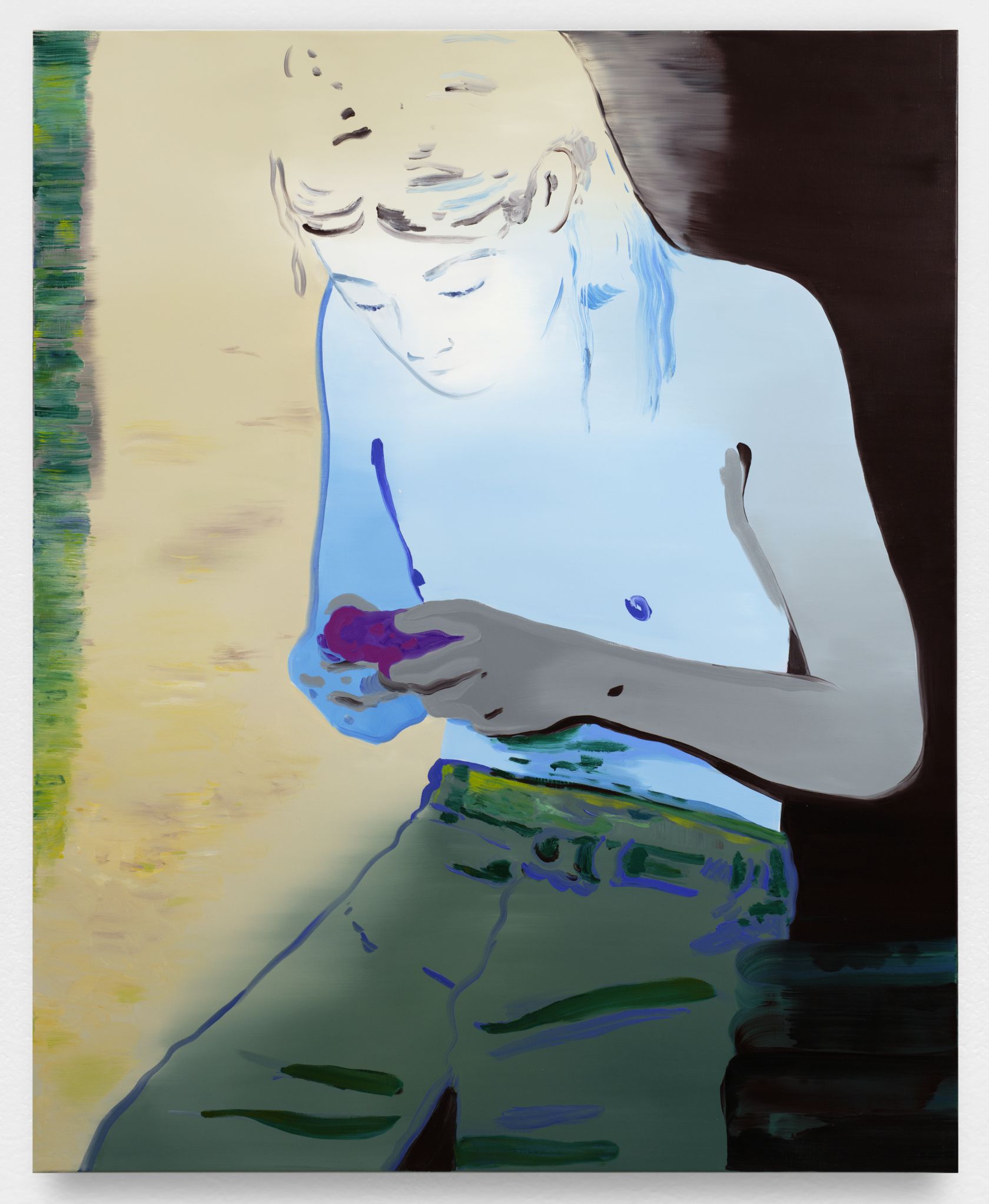
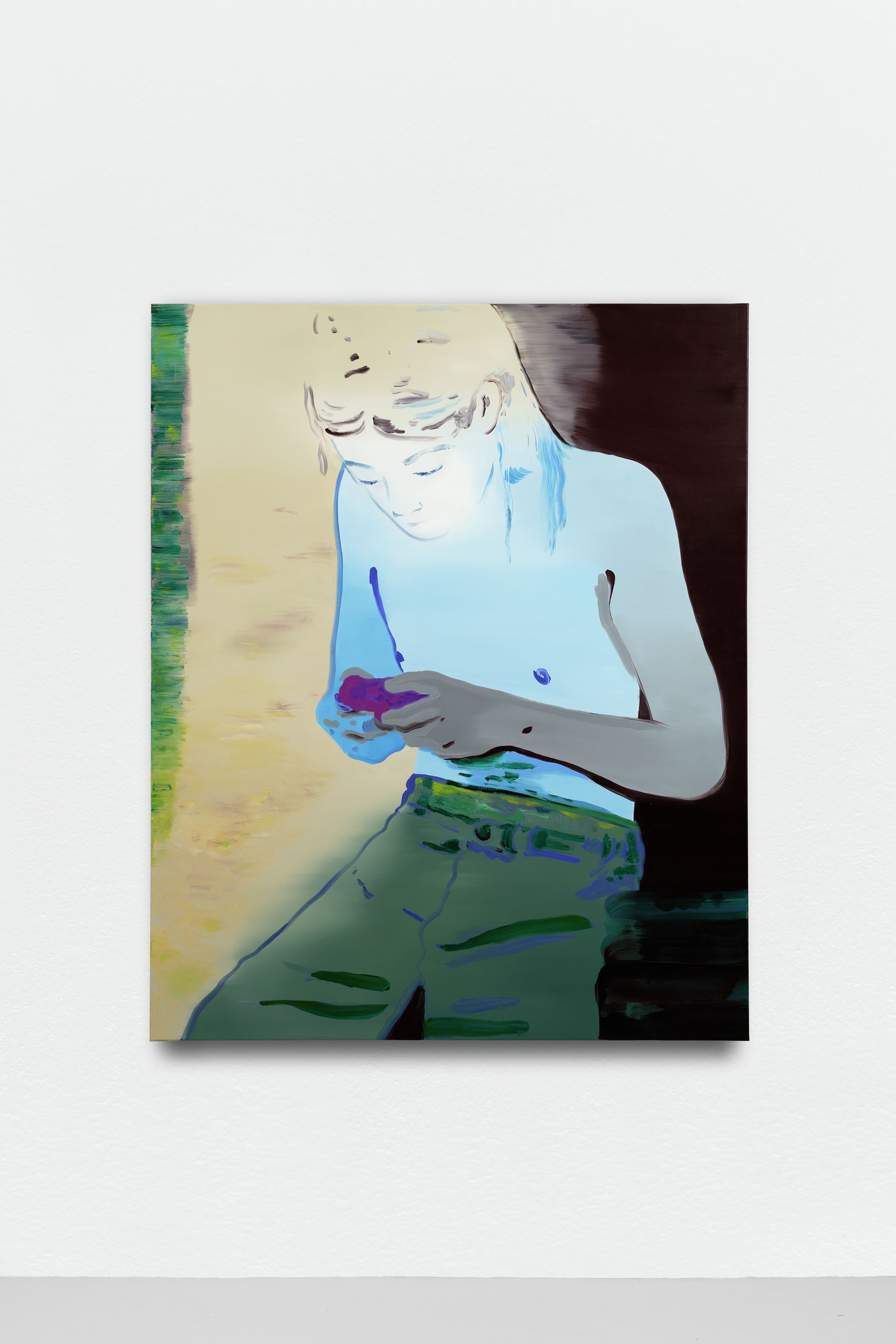
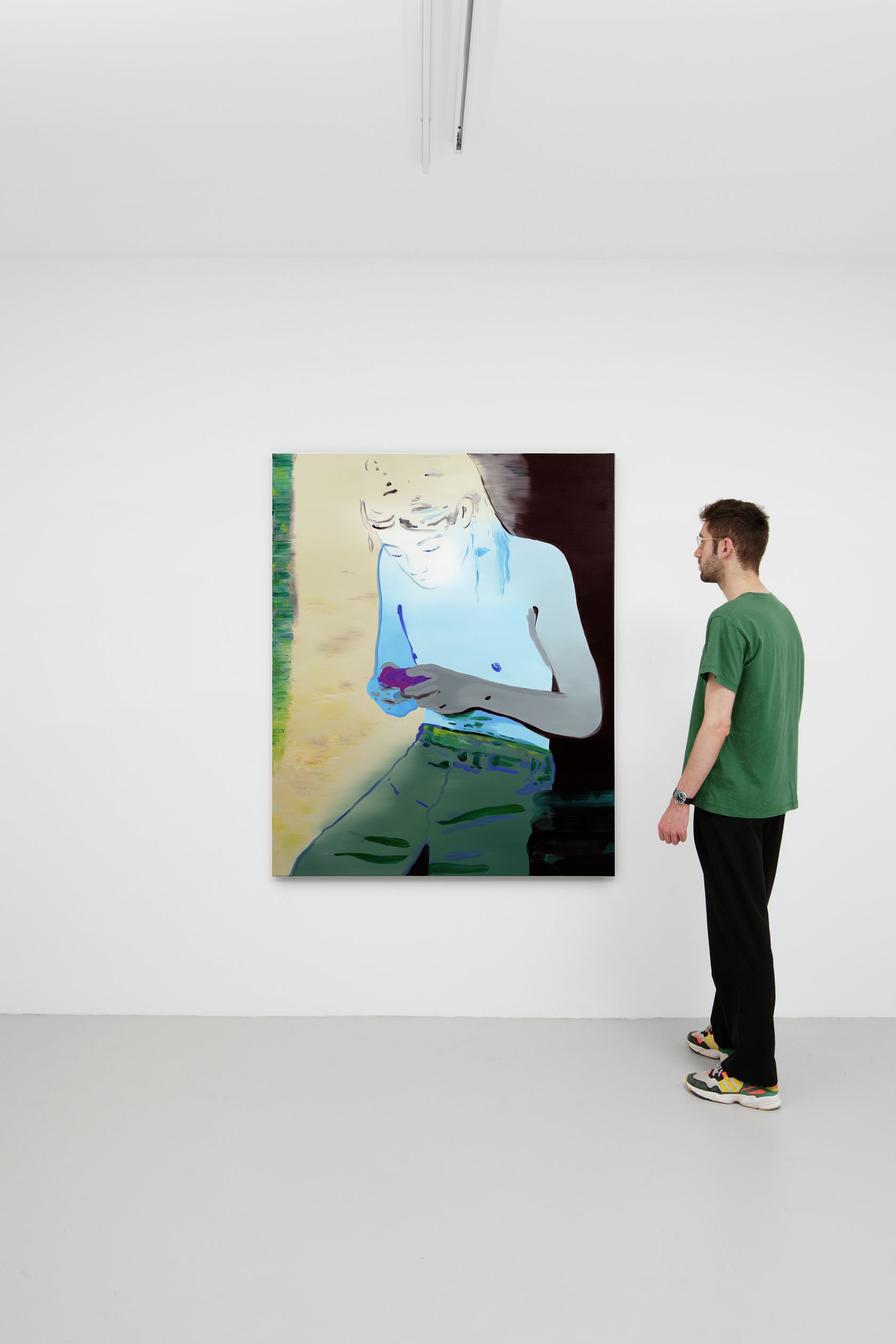
- Françoise Pétrovitch
- Sans titre , 2022
- Oil on canvas
-
- 160 ×
- 130 × cm
- 63 ×
- 51 1/8 × inches
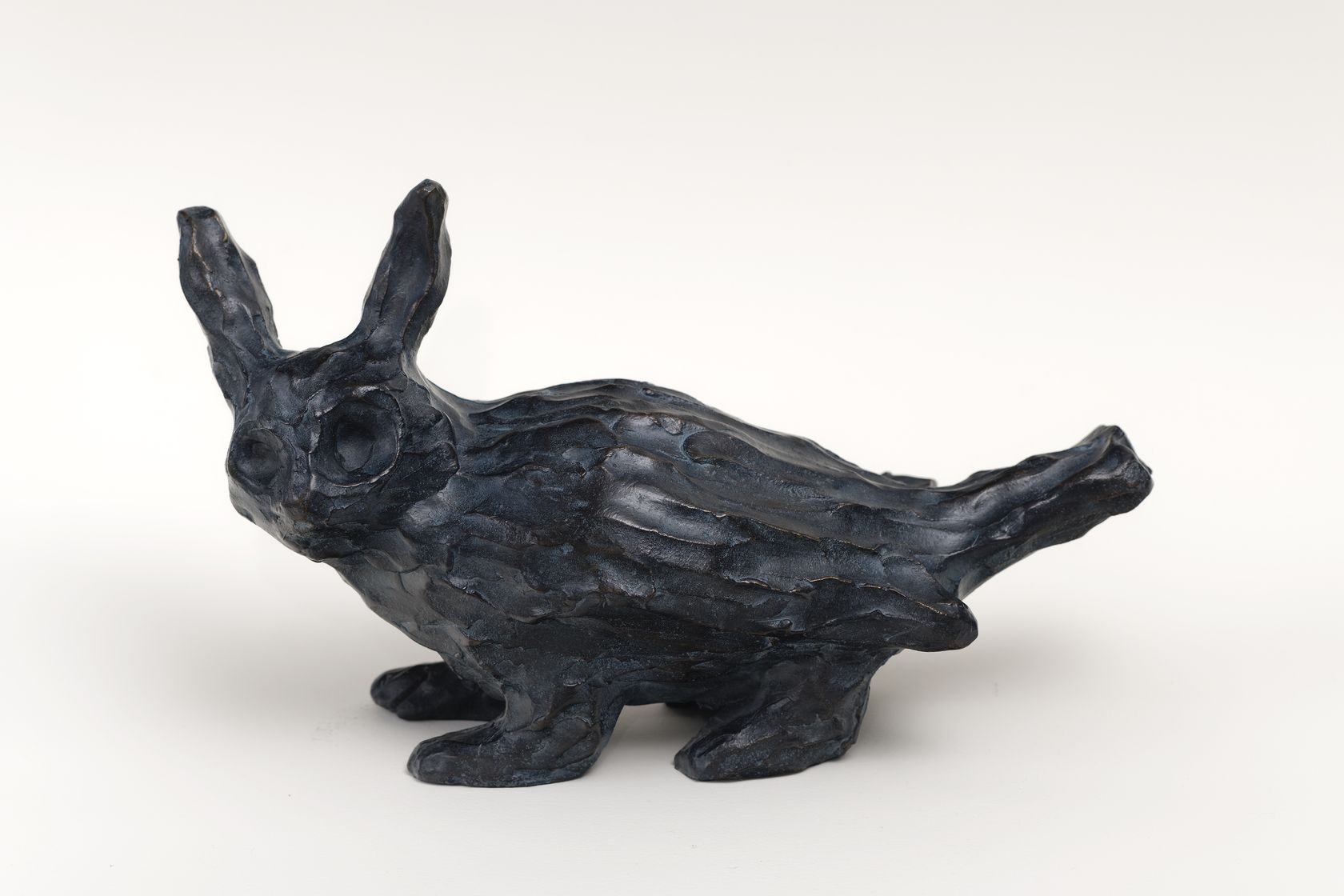
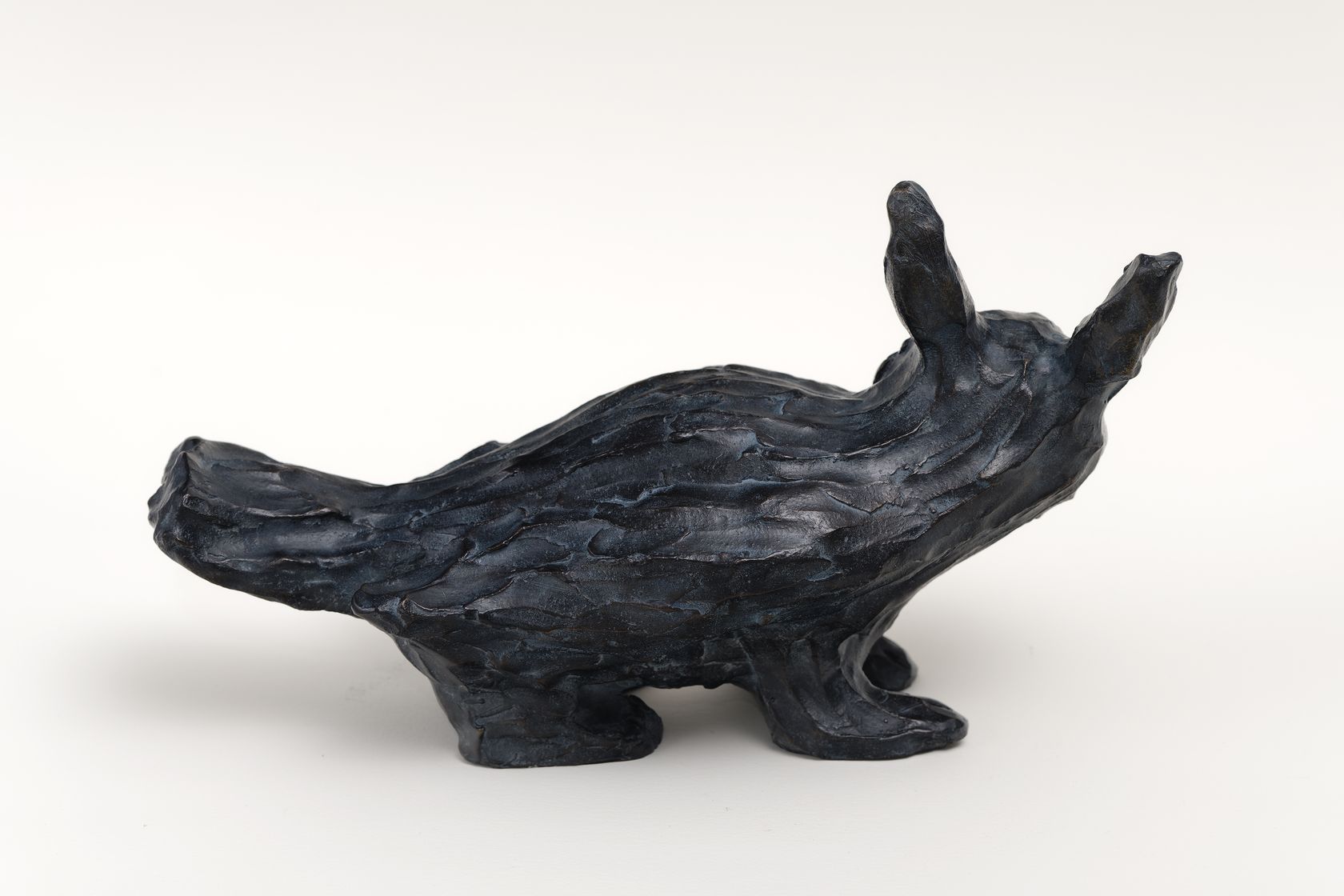
- Françoise Pétrovitch
- Lapin-Oiseau , 2018
- Bronze - Edition of 8 + 4 AP
-
- 18 ×
- 32 ×
- 14 × cm
- 7 1/8 ×
- 12 5/8 ×
- 5 1/2 × inches
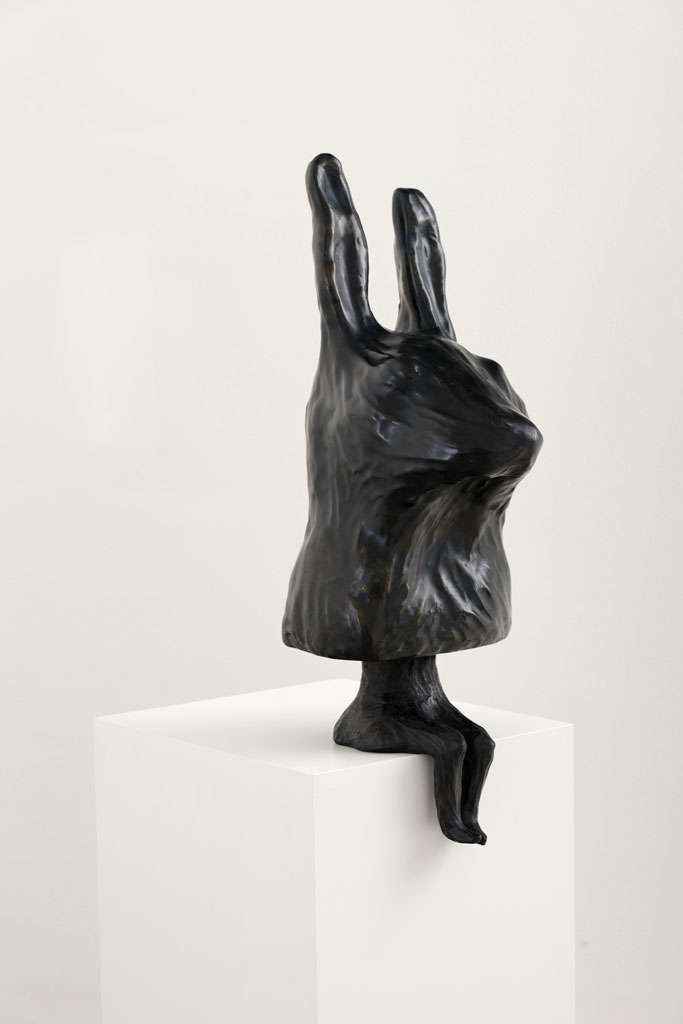
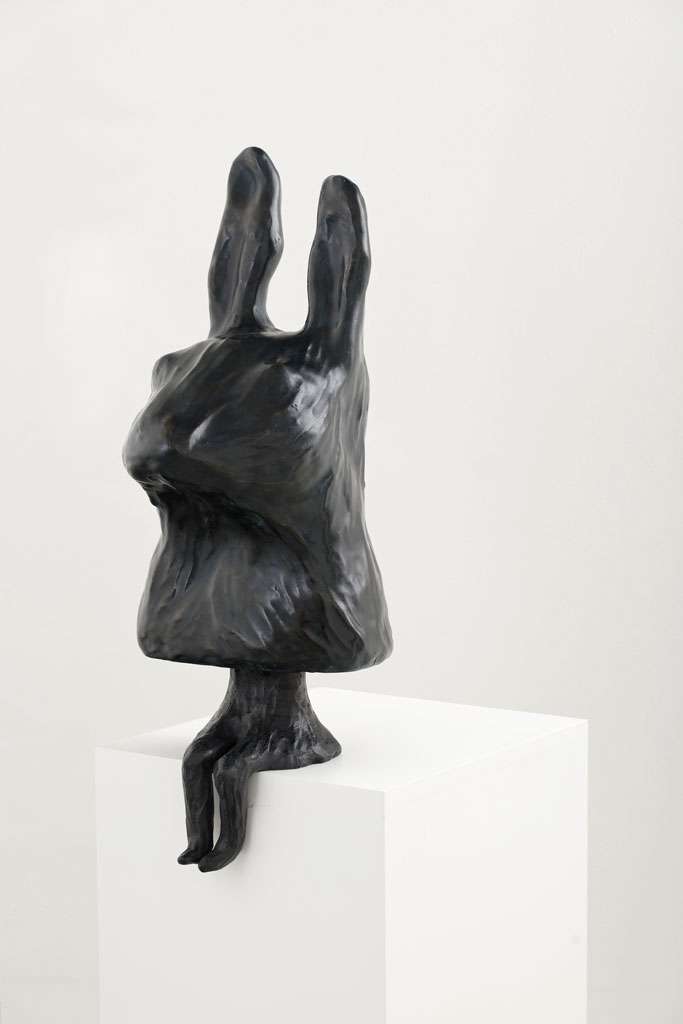
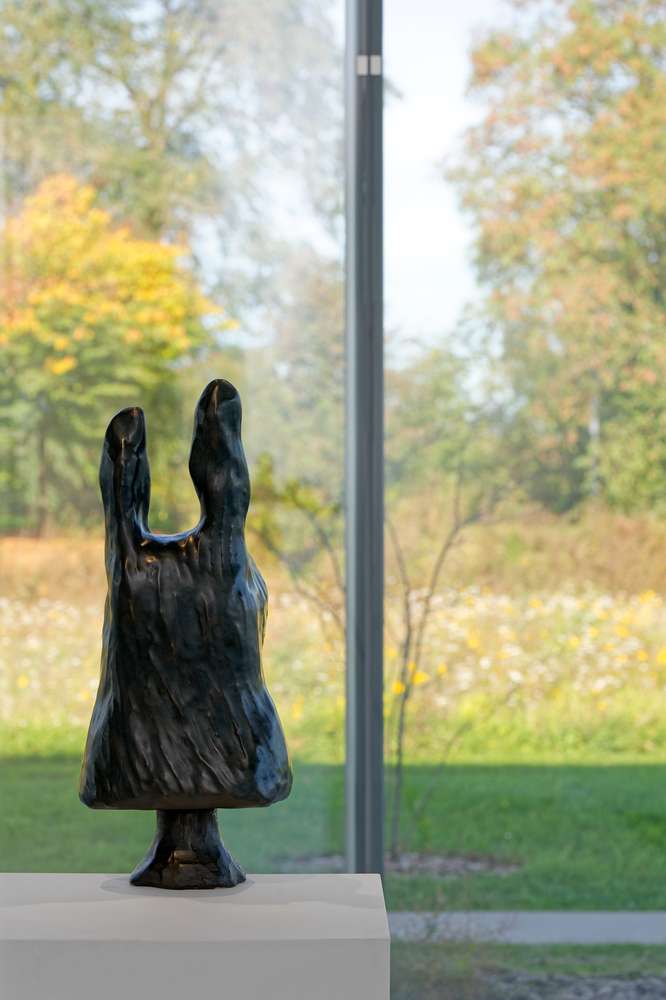
- Françoise Pétrovitch
- Sentinelle (Lapin) , 2015
- Bronze - Edition of 8 + 4 AP
-
- 74.5 ×
- 28 ×
- 30 × cm
- 29 3/8 ×
- 11 ×
- 11 6/8 × inches
Abraham Poincheval (born 1972 in Alençon, lives and works in Marseille) is an insatiable explorer. Whether by crossing the Alps while pushing a capsule he used as his shelter, or by enclosing himself for a week in a rock, his—itinerant or static—expeditions require total physical commitment. The inhabitable sculptures which the artist conceives are laboratories allowing him to experience time, enclosure or immobility. They are the envelope that hosts the performer, an object that disturbs the landscape, and which exists through word of mouth.
The works and performances of Abraham Poincheval are subject to numerous national and international exhibitions and invitations. In 2017, the Palais de Tokyo curated a one-person show which led him to experience through two new performances (Stone and Egg) the temporalities of the animal and the mineral kingdoms. Solo exhibitions have recently been hosted at the Musée de la Chasse et de la Nature, Paris (FR), the Institut d'art contemporain - IAC, Villeurbanne (FR), La Criée, contemporary art centre, Rennes (FR), the MAC VAL, Vitry-sur-Seine (FR), the FRAC Paca, Marseille (FR) and the Domaine de Chamarande (FR) to name a few. In 2019, Abraham Poincheval is part of the International Exhibition of the 15th Lyon Contemporary Art Biennale where his film Walk on Clouds is screened for the first time. His work is held in the collections of the Museum Voorlinden, Wassenaar (NL), the Fondation Louis Vuitton, Paris (FR) the Centre national des arts plastiques - CNAP, Paris (FR), the Musée-Forum de l'Aurignacien, Aurignac (FR), the MAC VAL, Vitry-sur-Seine (FR), the Musée d'art du Valais, Sion (CH), the MAHF Fribourg (CH) and the FRACs Corse, Franche-Comté, Limousin, Occitanie and PACA (FR).
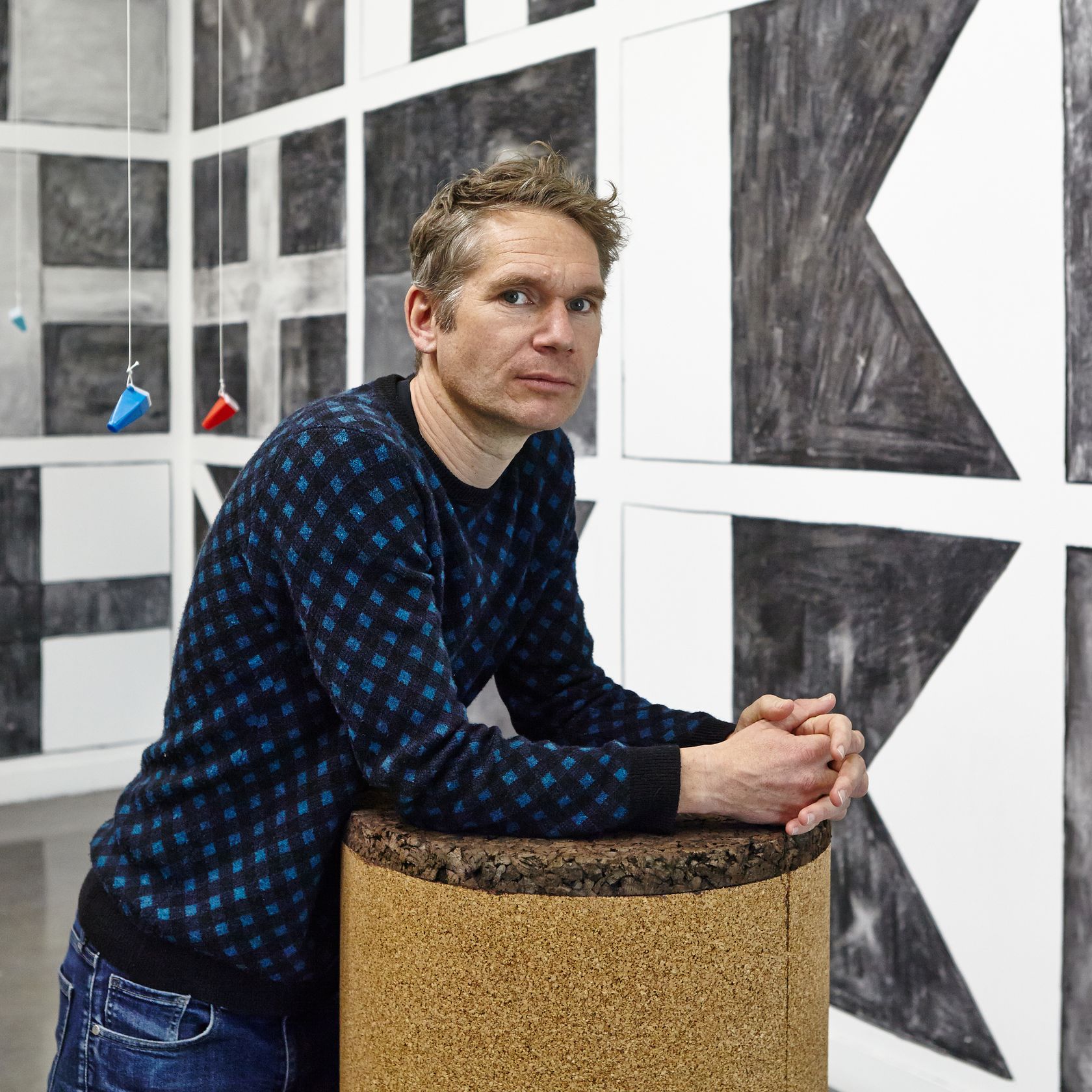
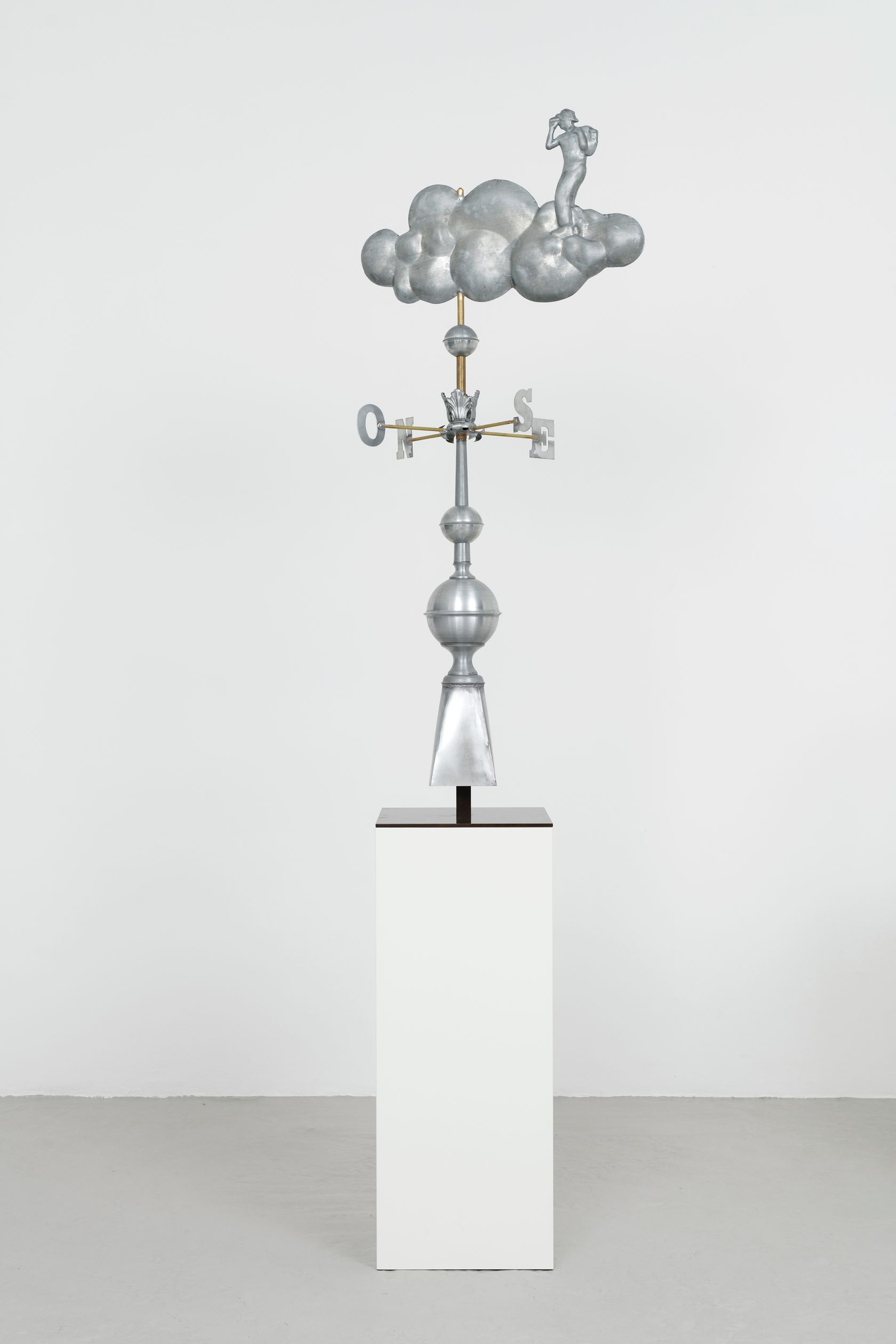
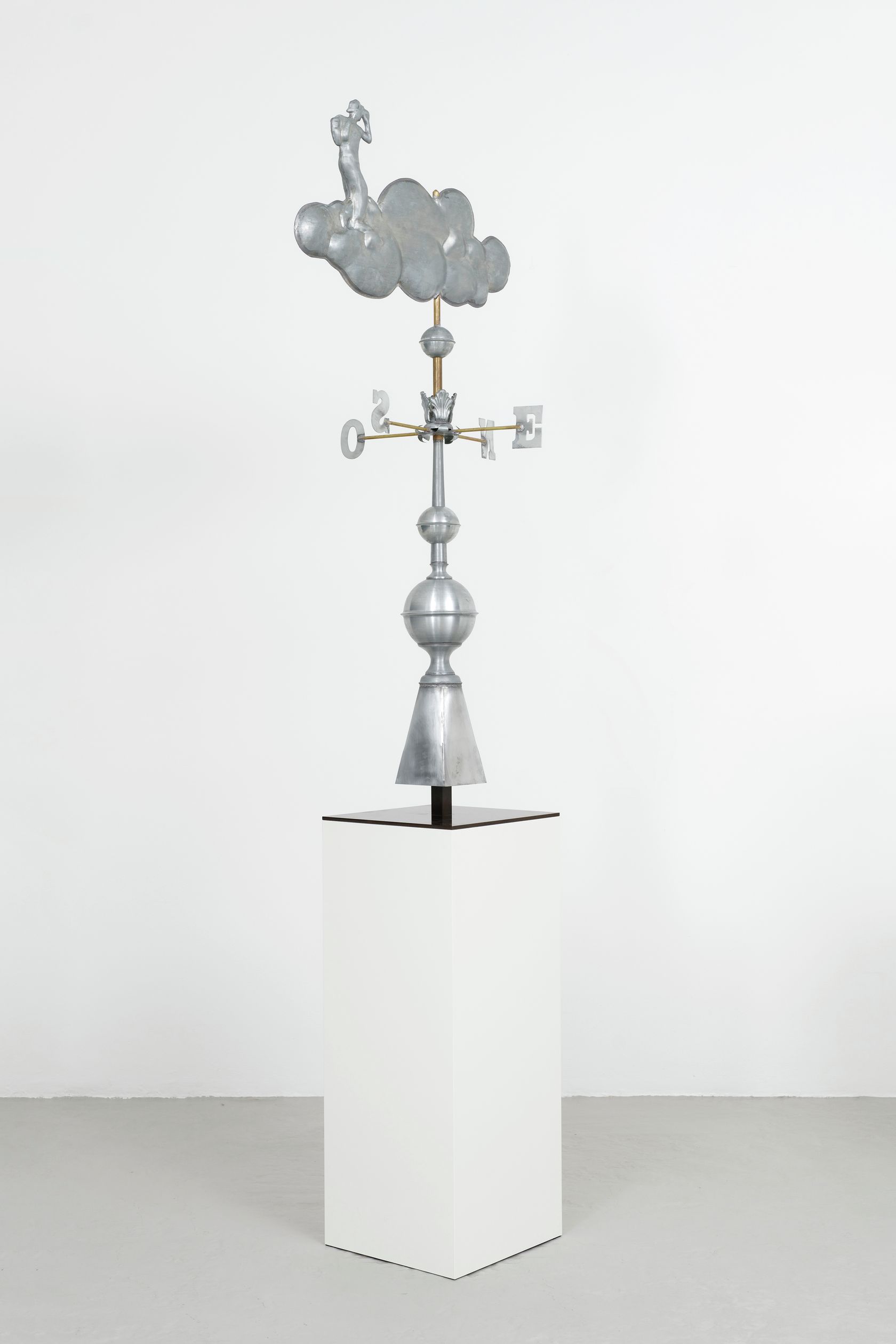
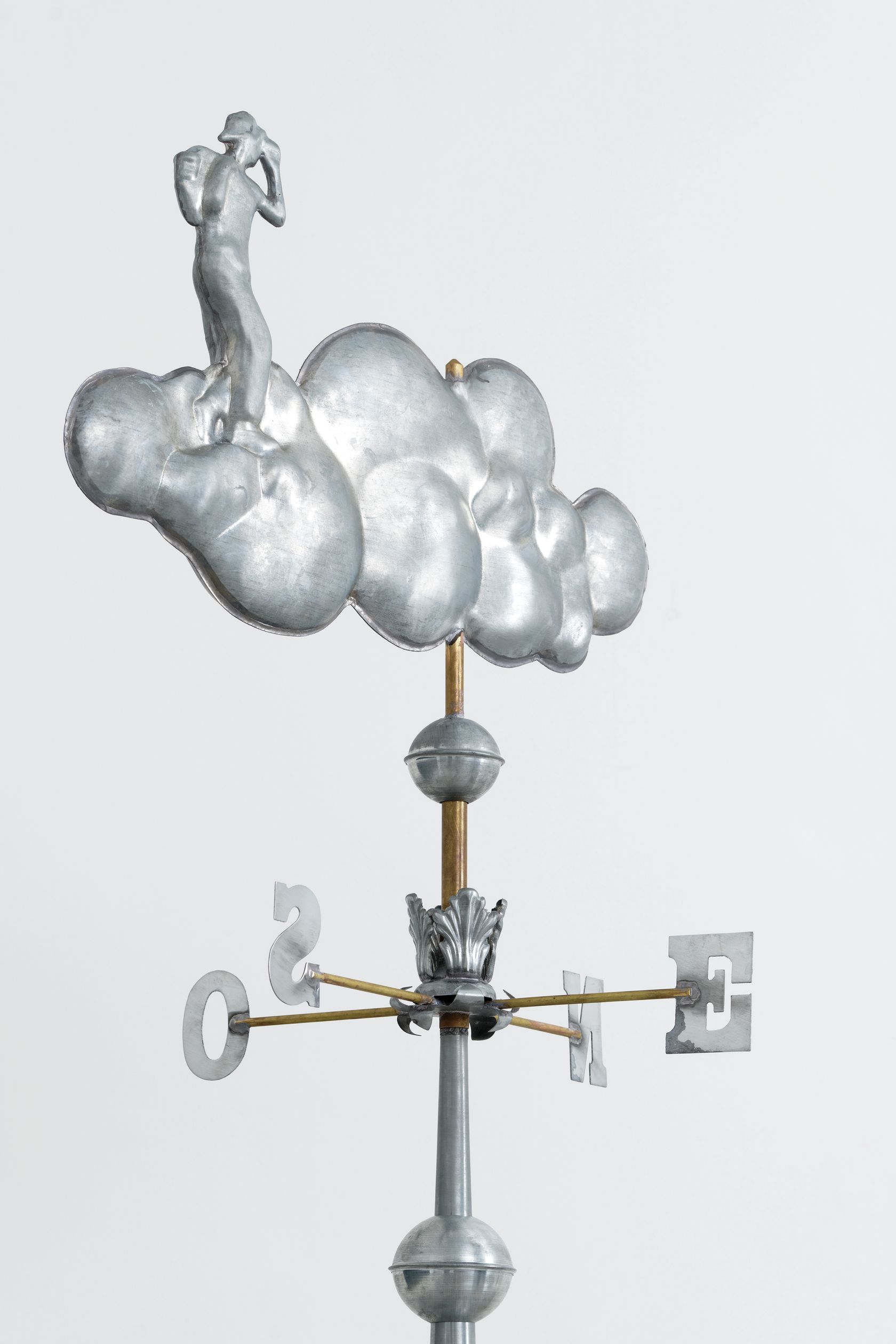
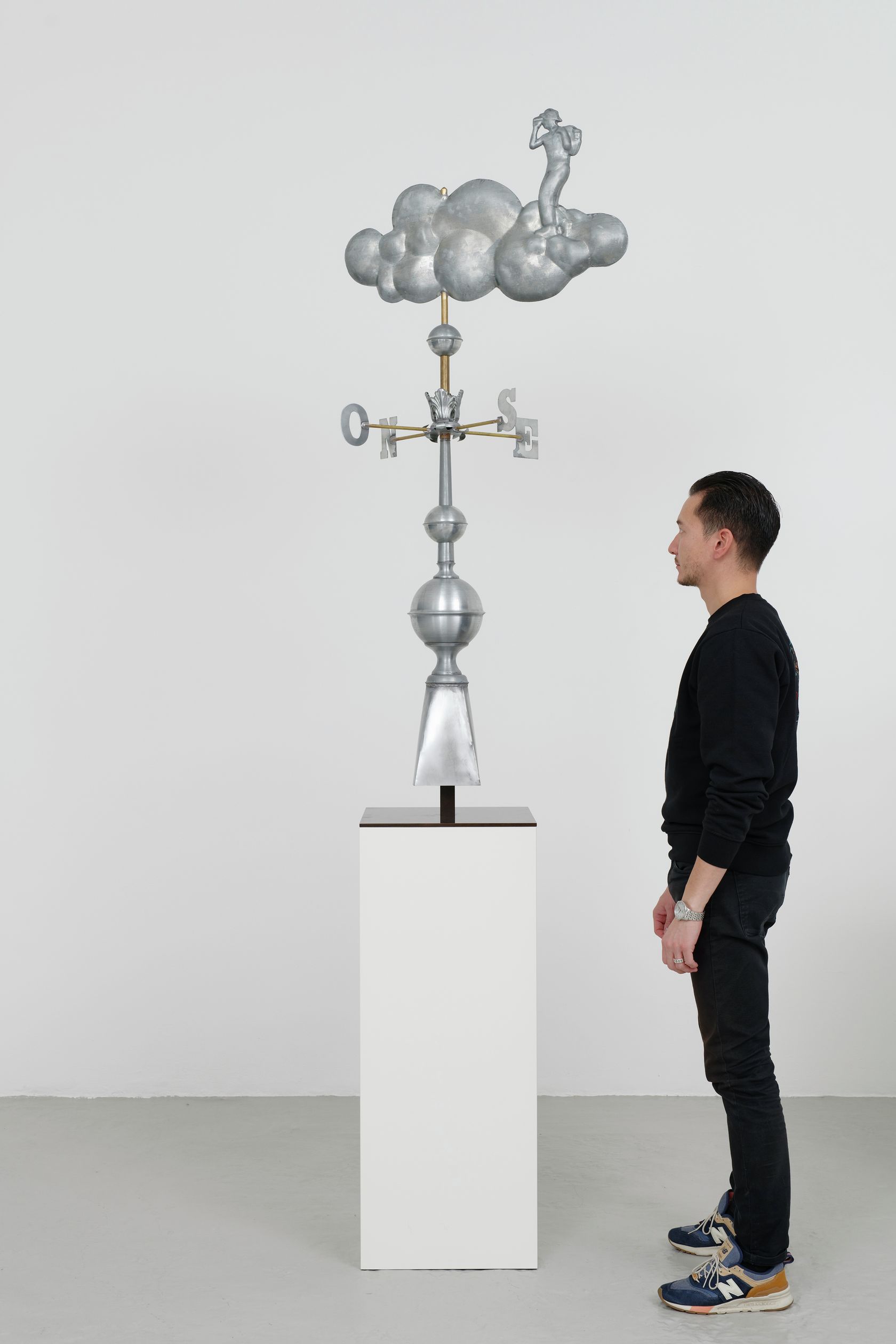
- Abraham Poincheval
- Walk on Clouds (Girouette) , 2020
- Zinc and brass
-
- 156 ×
- 55 ×
- 73 × cm
- 61 3/8 ×
- 21 5/8 ×
- 28 6/8 × inches
Born in Versailles in 1980, Laurent Proux lives and works in Paris.
In his painting and drawing, Laurent Proux produces powerful and original imagery that seeks through his formal choices to resolve the questions raised by his subjects. Described by some as a realist due to the subjects he depicts—industrial machinery, workstations, sexualized bodies, etc.—his style finds its emancipation through his never-ending exploration of pictorial solutions, the integration of aberrations, bringing planes into collision, the use of artificial colors, all freeing his oeuvre from the opposition between figuration and abstraction. He approaches the human form through fragments, exaggeration and the use of silhouettes to create a kind of body-cum-machine, politicized and under assault, often disturbing and occasionally sentimental. His canvases take the form of a stage, in an altered perspective and the artist addresses the spectator with a visual and intellectual enigma running through the image.
Laurent Proux’s oeuvres are included in the collections of the National Center for Visual Arts (CNAP), the Occitan, Limousin and Nouvelle-Aquitaine regional contemporary art collections (FRAC) and the Paris Municipal Collection (FMAC). His work has been exhibited at the Mana Contemporary in Chicago (US), the Shanghai Art Museum (CN), the Moscow Center for Contemporary Art (RU), the Musée d’Art Contemporain in Lyon (FR), the Limousin FRAC in Limoges (FR), at the Lieu Commun in Toulouse (FR) and at the Musée d'Art moderne et contemporain de l'Abbaye Sainte-Croix aux Sables-d'Olonne (FR). Laurent Proux was a resident of the Casa de Velázquez in Madrid (ES).
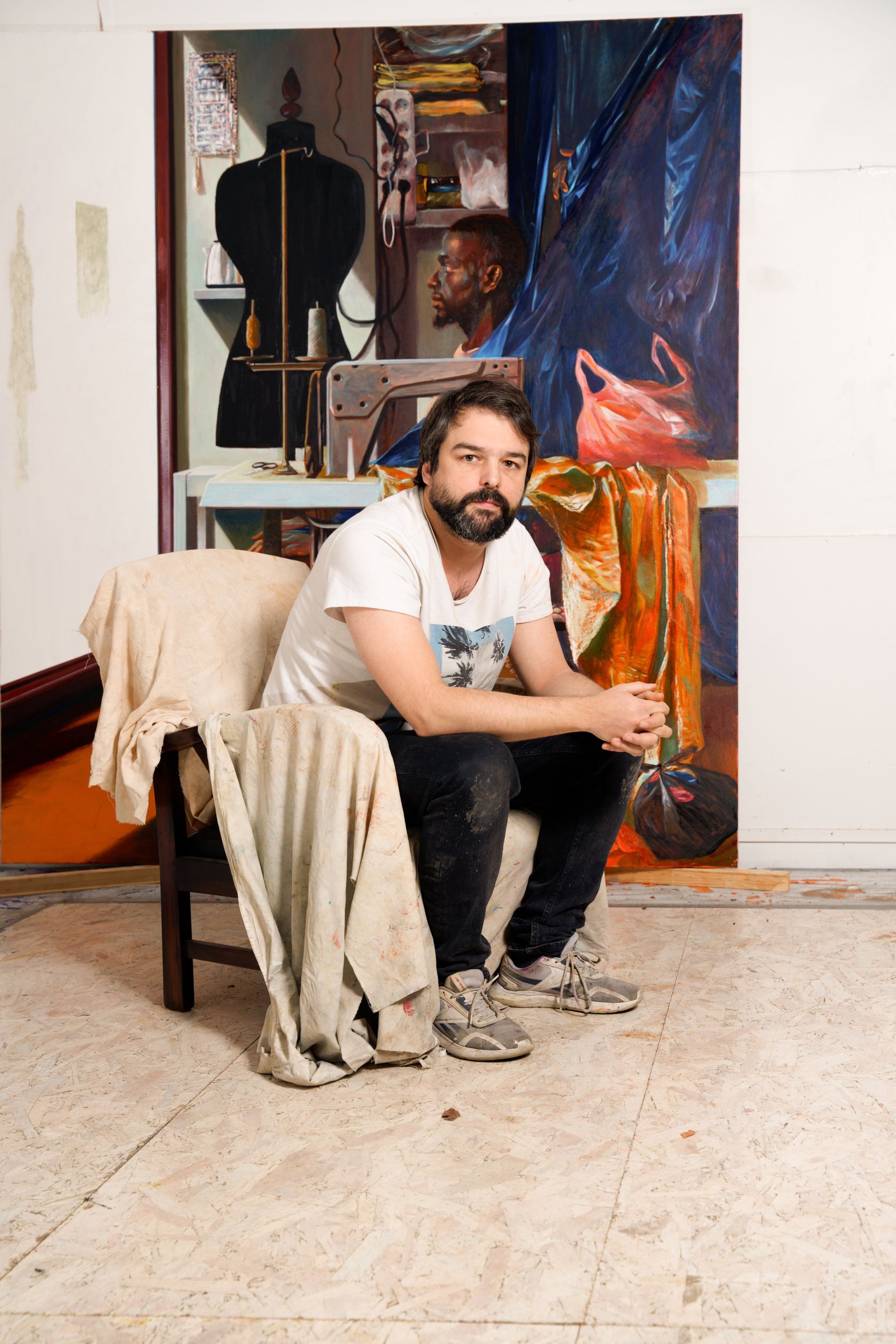
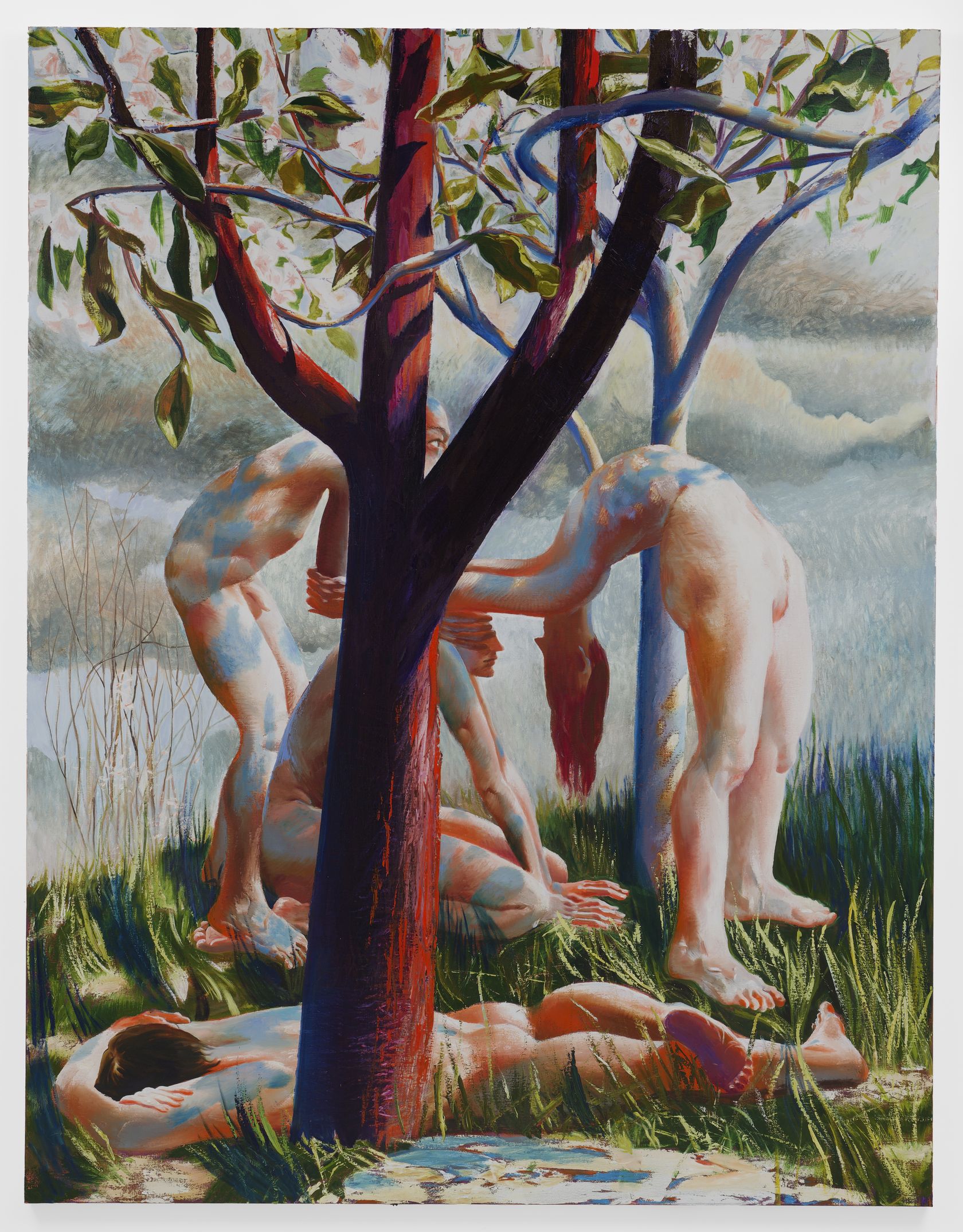
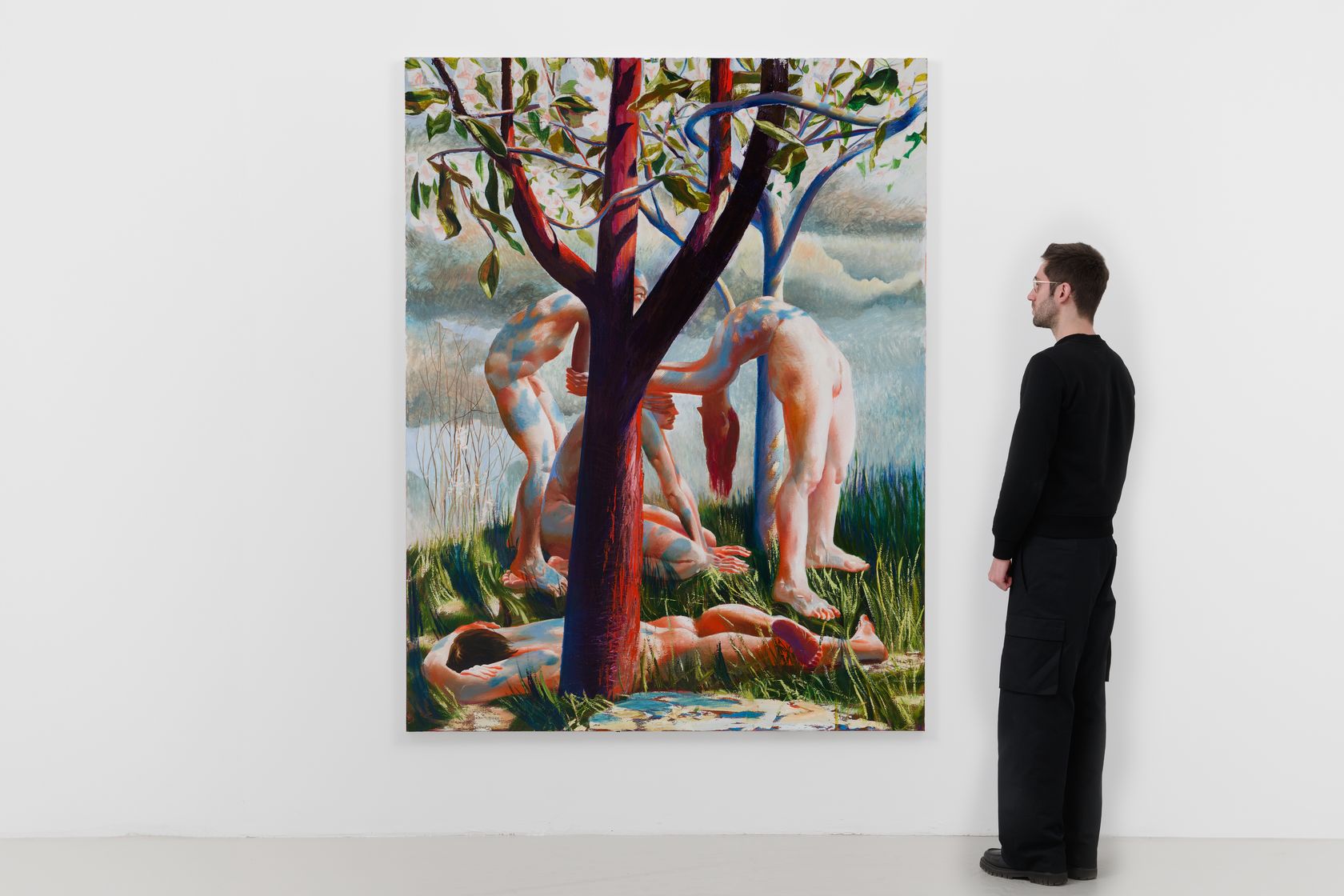
- Laurent Proux
- The Acrobat , 2024
- Oil on canvas
-
- 220 ×
- 170 × cm
- 86 5/8 ×
- 66 15/16 × inches
- unframed
- 224 ×
- 174 ×
- 5 × cm
- 88 3/16 ×
- 68 1/2 ×
- 1 15/16 × in
- framed
The African-American artist Philemona Williamson (b. 1951) brings together personal and more universal narratives in her brightly colored, large format paintings that portray children and teenagers, often in mysterious situations. She paints directly onto her canvases without preliminary sketches and her paintings thus resemble palimpsests telling their own stories, with multiple layers, figures and scenes appearing across the support, before seemingly being abandoned. Williamson’s works are deeply rooted in her childhood memories and include references to memorabilia, such as dolls typical of American popular culture from the artist’s personal collection, and as such are an invitation to explore mysterious and unfinished tales.
Williamson has been exhibited in numerous American institutions, from her debut solo show at the Queens Museum of Art in 1988, to Metaphorical Narratives, at the Montclair Art Museum, New Jersey, in 2017, which spanned the thirty years of her artistic career. Her works can be seen in many public collections across the USA and she has been commissioned for several public projects, most notably by the New York Metropolitan Transport Authority. In 2022, she was one of fifteen recipients of the Anonymous Was A Woman prize, awarded annually since 1986 to women artists over the age of 40, in recognition of their previous and future work.
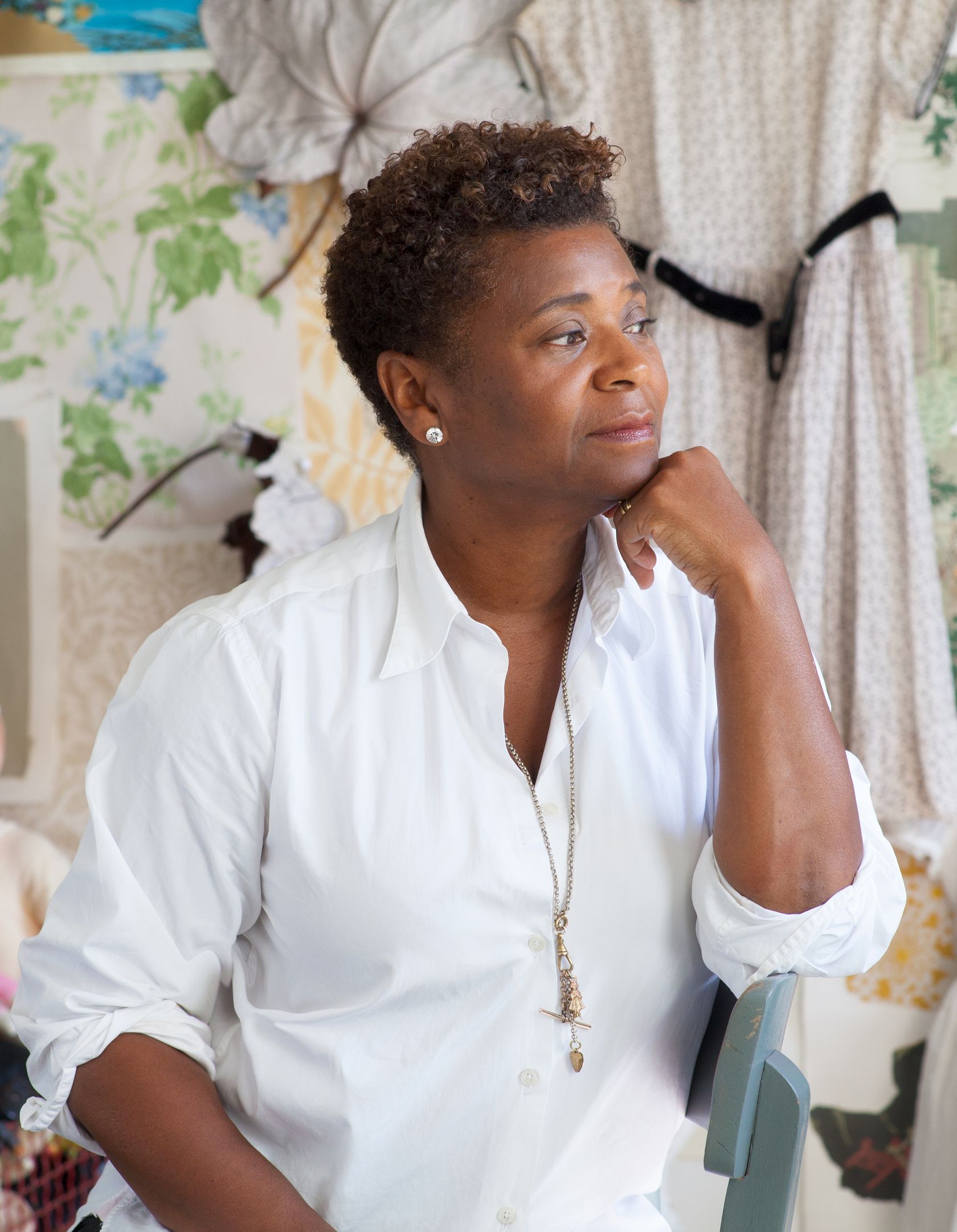
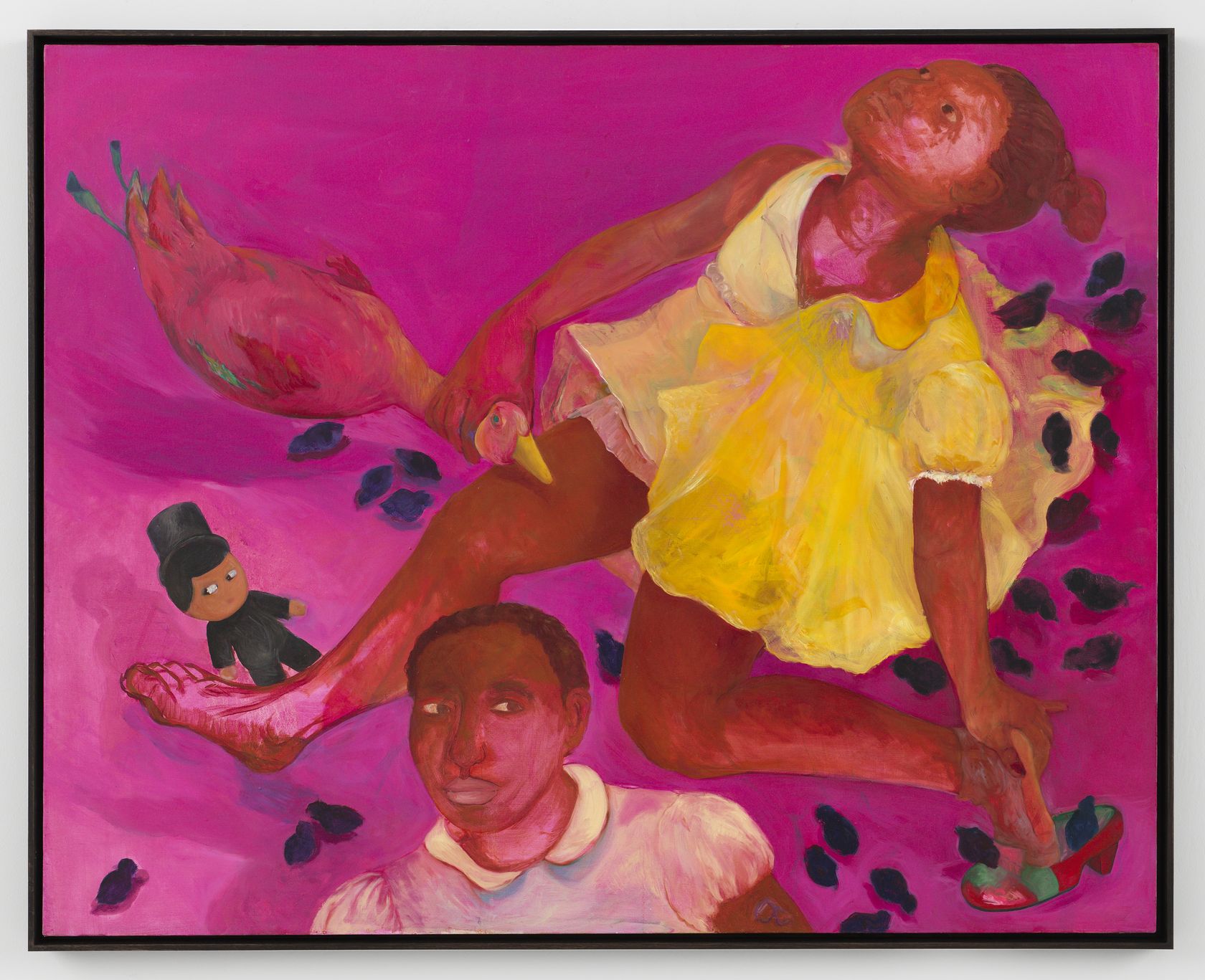
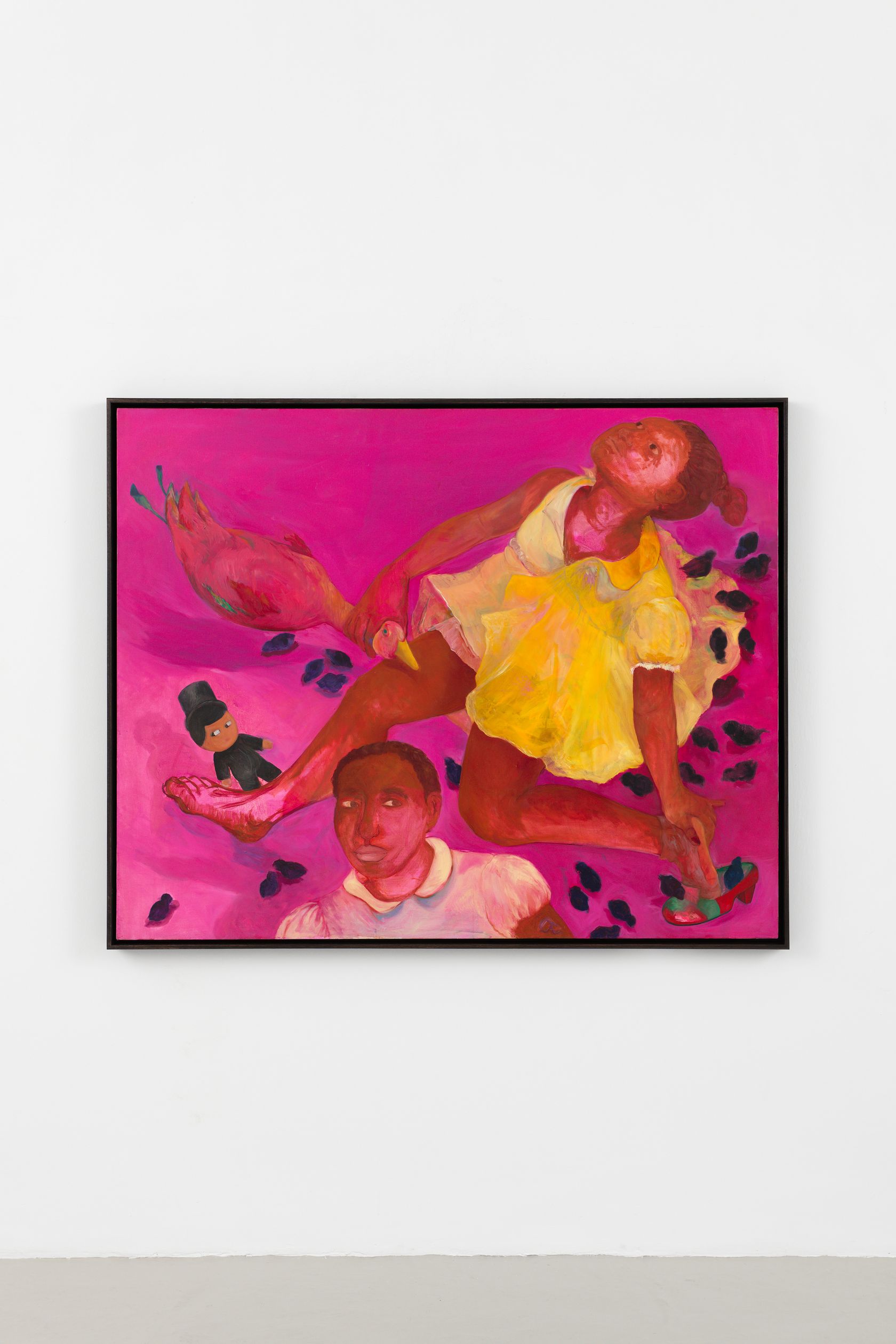
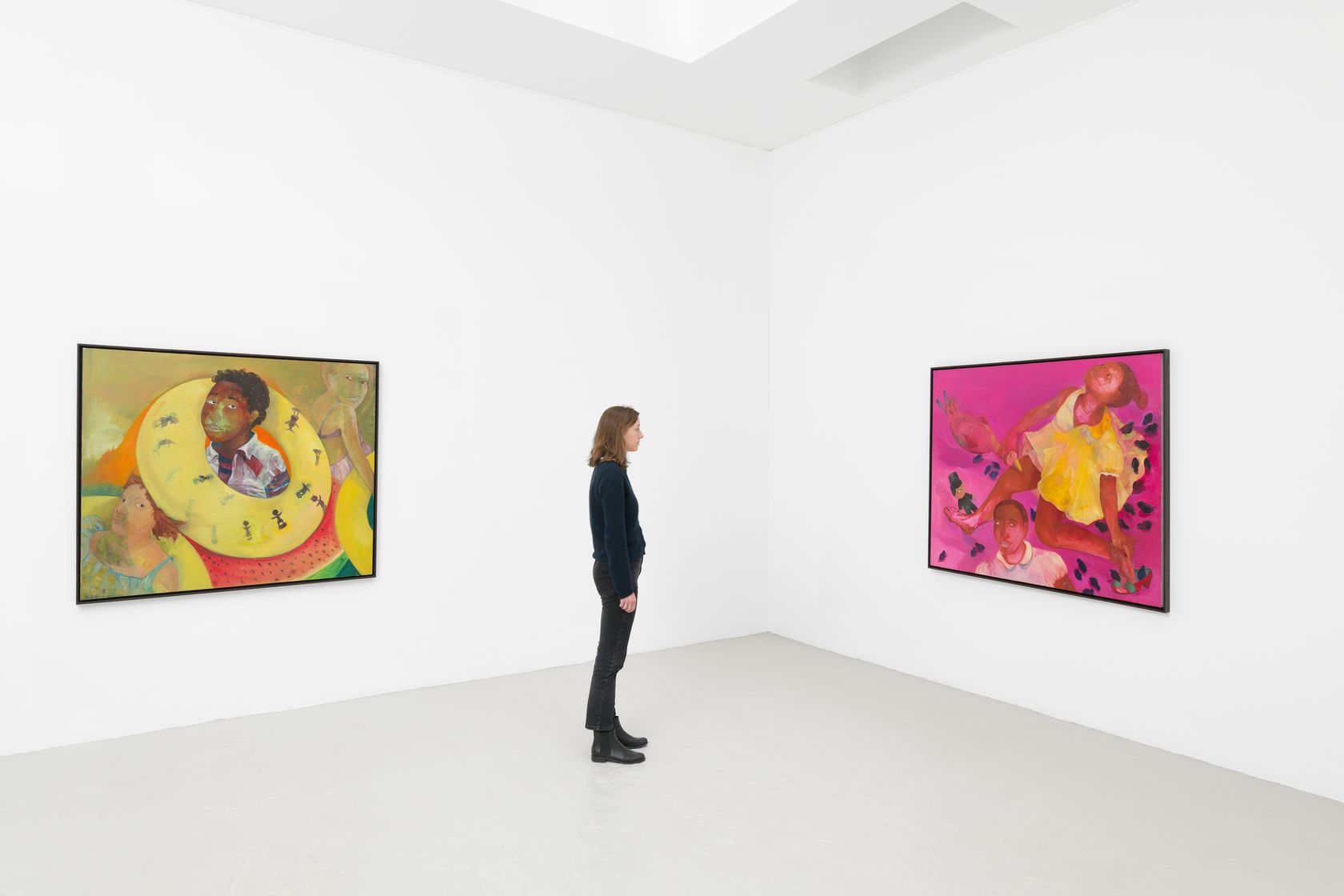
- Philemona Williamson
- January March , 2016
- Oil on linen
-
- 122 ×
- 152.5 ×
- 3.5 × cm
- 48 ×
- 60 1/16 ×
- 1 3/8 × inches
- unframed
- 126 ×
- 156.5 ×
- 5 × cm
- 49 5/8 ×
- 61 5/8 ×
- 1 15/16 × in
- framed

